
Portugal in April: A Country in Bloom
- Share on Facebook
- Share on LinkedIn
- Email this Page
Visit Portugal
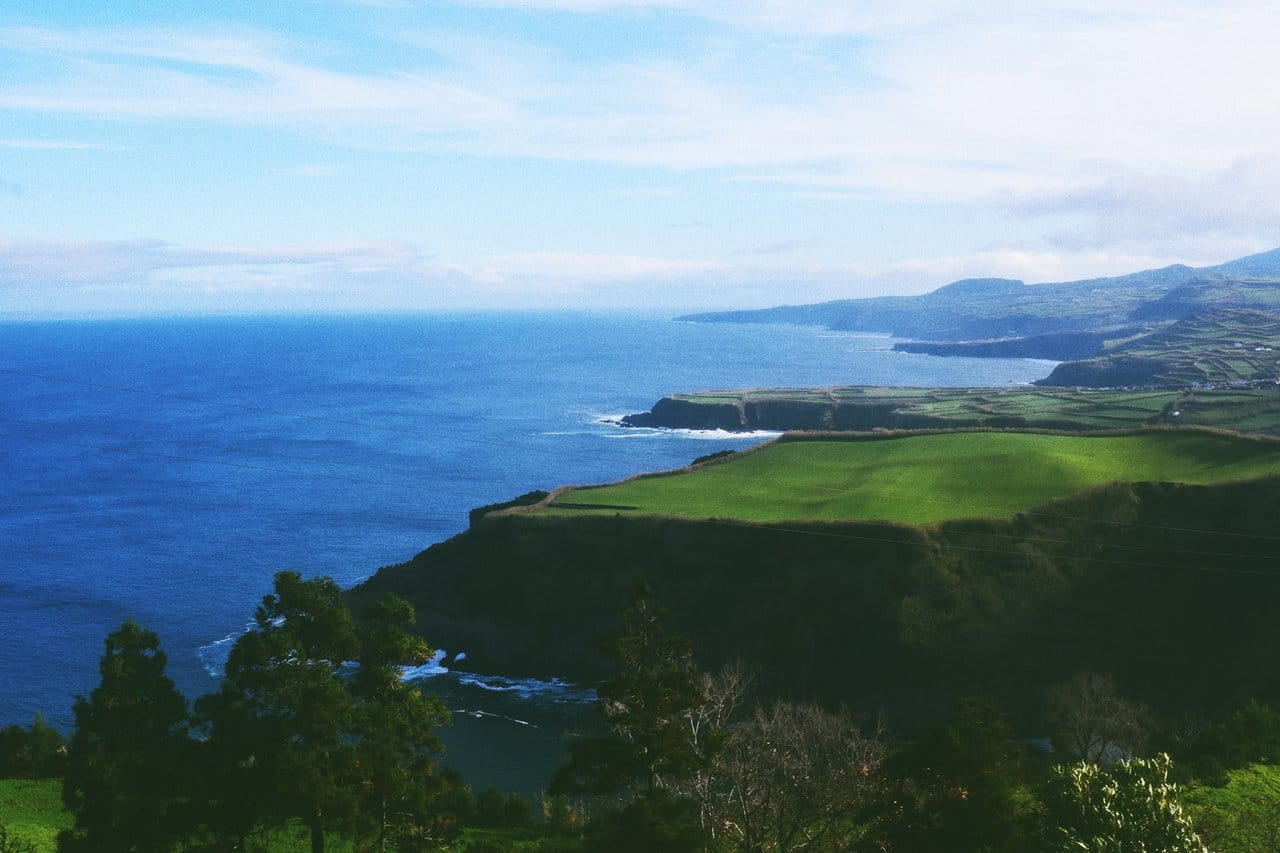
- Why Visit Portugal in April
Spring is gorgeous in Portugal. The countryside bursts with new foliage, and the wildflowers are in bloom. A visit to Portugal in April will mean that you can take advantage of the spring sunshine too. The preparations for Easter mean that the summer season is well and truly on its way. You can enjoy many activities all over Portugal in April, and the weather will usually be kind while you’re here.
- Weather in April
April showers in the northern hemisphere is a real thing, and Portugal is no different. If you visit Portugal in April, you’re likely to see at least a few days of rain. The benefit of this is the beautiful lush landscape that you can enjoy on the sunnier days. April is a changeable month, but Easter heralds the gradual return of warmer weather. If you head south for your holiday, to the Algarve , you’re more likely to see the sun. Whereas in the north, particularly in the mountains, temperatures are still fresh. The Azores islands in the mid-Atlantic are temperate all year round and have an average high of 17c in April. Madeira , also part of Portugal, lies off the northwest coast of Africa and enjoys a subtropical climate. The average temperatures in April, in the northern city of Braga, are between 17c and 8c. In the southern town of albufeira, the average high in April is 20c. You will get around nine hours of sun each day in the Algarve. Sunrise is around 6 am, and sunset is at 7 pm in the middle of April.
- Timezone in Portugal
The time in Portugal changes from GMT to DST changes at the end of March. If you visit Portugal in April, you will notice that the evenings are long and light.
- What to do in Portugal in April
Feira do Chocolate in Óbidos

Óbidos is beautiful in any season, but in April, you can enjoy two of the biggest events of the year there. The Chocolate Festival is inexpensive and great fun with plenty of activities to take part in. You can buy tickets for the closed event in the castle area of town at the main ticket office near the car park, or at the festival gates. If you prefer you can also arrange a hotel and festival package in the area. There are a myriad of stalls selling a variety of sweet treats , and you must check out the chocolate sculptures on display at the catering school. All of the main streets in Óbidos are likely to be busy during the festival, but it’s easy to duck off the main paths to take in the medieval atmosphere. Head down the hill a little, and you will find yourself on the winding roads that lead to the castle and chocolate festival.
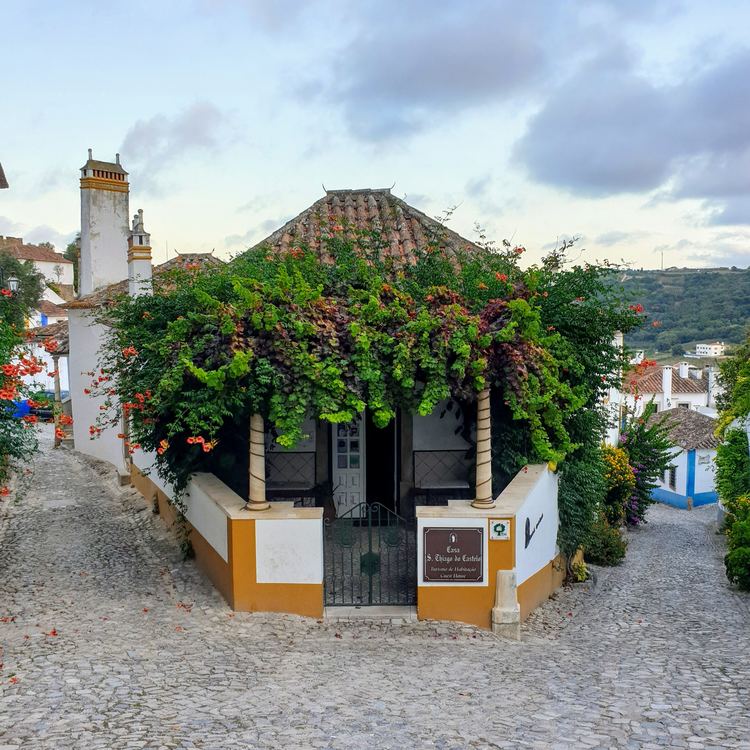
The program for all the activities during the festival is available on flyers all around town so that you don’t miss the fun. There are body painting demonstrations, a fashion show, concerts, and cooking demonstrations. In 2020 the Chocolate Festival will run from April 25 to May 5.
Peixe em Lisboa
This is a gastronomic celebration of seafood in Lisbon over 11 days in April. You can enjoy cooking workshops and taste gourmet fish dishes prepared by celebrated chefs. From April 7 to 17, 2020, you will learn all about the traditional fish dishes of central Portugal. It is designed for visitors to enjoy and which allows them to learn about local cuisine and Portuguese wine. As part of the Lisbon Fish and Flavours event, you’ll also be entertained by local dance performances and folk music groups.
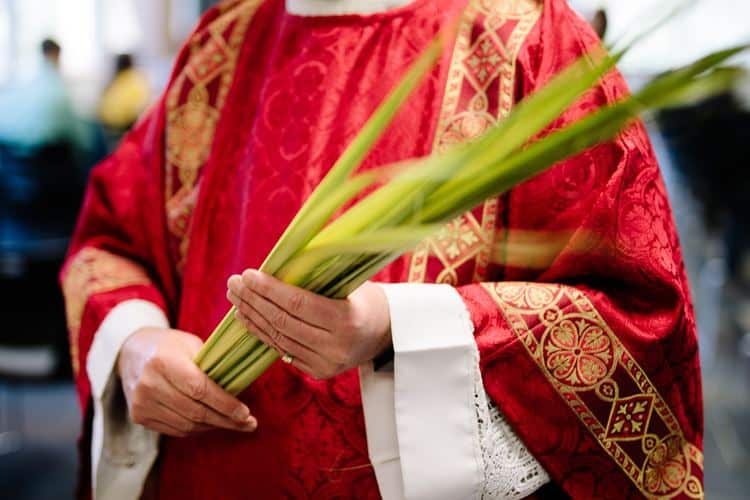
In 2020, Easter falls in April, and there is a big celebration in Óbidos over Holy Week. The festivities start at the beginning of Lent with the Procession of the Third Order of St. Francis of flower-laden floats. Then on Palm Sunday, the Senhor dos Passos procession winds through the walled town.
The highlight of the Easter festivities is the solemn Good Friday evening funeral procession around Obidos lit only by flaming torches along the route. In 2020 the Holy Week processions will take place between April 5 and 12.
Holy Week in Braga

Braga, to the north of the county, also has celebrations in the Easter period. The churches are filled with flowers, and streets are decorated with lights during Easter week.
Mundo Abreu exhibition
This travel and tourism event takes place in late March or early April in Lisbon. The exhibition consists of a variety of stands from different countries, all promoting the beautiful sites that they recommend tourists visit in their country. In 2019, over 700 exhibitors took part, both domestic and international. In addition to the stands, there are cultural exhibitions and shows, such as music, dancing, and storytelling.
- What to eat in April
Come the end of April, you will start to see signs in cafes advertising “ Há caracois ” (roughly, “Snails are here”). The appearance of these delicious tiny snails means it’s time to enjoy them in the sun with a beer.
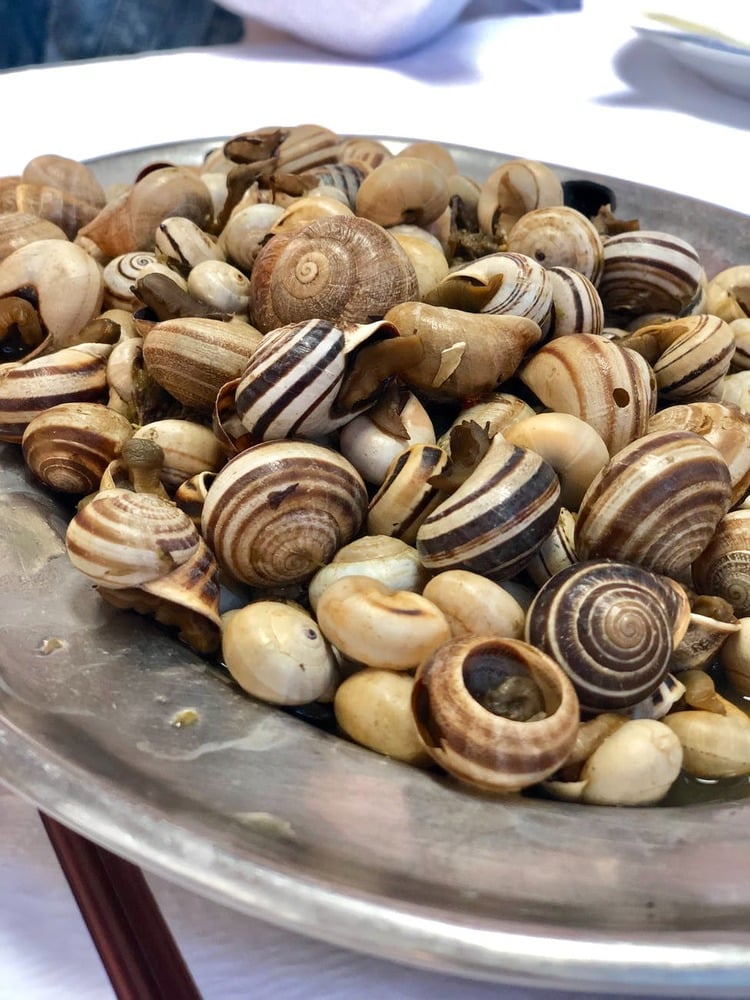
Usually cooked in broth with rosemary and a dash of piri piri, these are an excellent starter or snack with a cold drink. Lisbon is where you will tend to see caracois, and they herald the beginning of summer and the return of outdoor cafe culture. The end of April is also the start of the local strawberry season. If the weather has been good, you will see Portuguese and Spanish strawberries in the shops. Locally grown fruits in season , such as strawberries, apples, and rhubarb, are delicious and much more flavorful than the imported varieties.
Where to stay in Portugal
There are plenty of hotels in Portugal, from budget to boutique. Here are a few suggestions to get you started.
Hotel Casa Das Senhoras Rainhas
Set inside the city walls of Óbidos, this attractive boutique hotel overlooks the castle walls. It has a restaurant serving regional specialties, plus a bar with a terrace to relax on. A night in mid-April costs from €95. You can find more details and book here .
Casal de Eira Branca
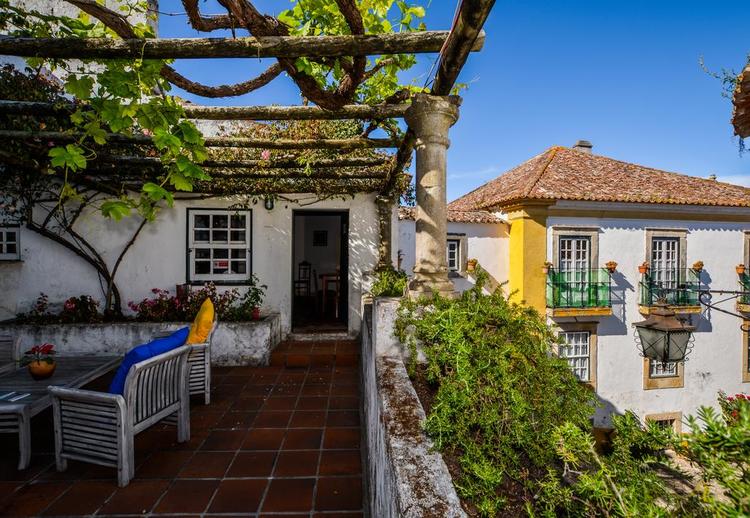
This hotel is also set in the centre of medieval Óbidos offers accommodation full of charm. It is a listed building with panoramic views of the old walled city. You can enjoy original ceramics and paintings in the public areas by local artists. An advantage of Casal de Eira Branca is the communal kitchen area that guests can use. You can also use the outdoor dining area in the summer. In April, one night at Casal de Eira Branca costs from €50. Further details are available and reservations can be made here .
Browns Downtown Hotel
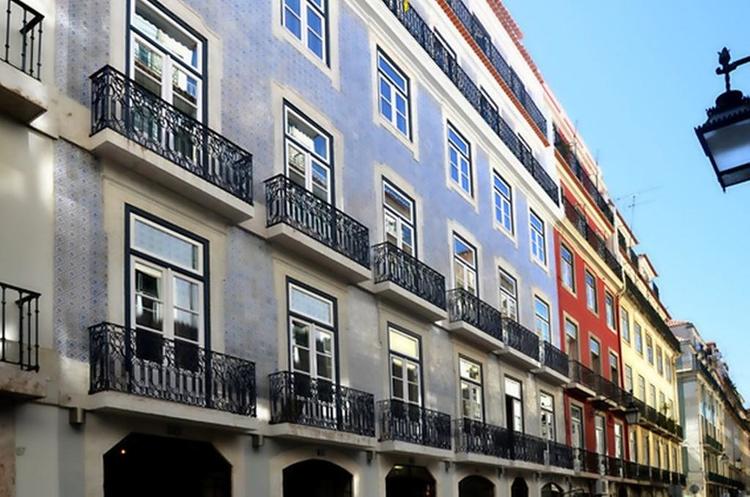
This super-hip hotel in the centre of Lisbon is a great choice. It has contemporary decor, iMac computers in every room, and is excellently situated for the main attractions. You are within a 15-minute walk of the bars and restaurants of Bairro Alto. It is also close enough to the stores of Baixa-Chiado to stroll around to find the best souvenirs. Browns Downtown Hotel costs from €140 in mid-April. Book your spot here .
Vila Gale Collection Braga
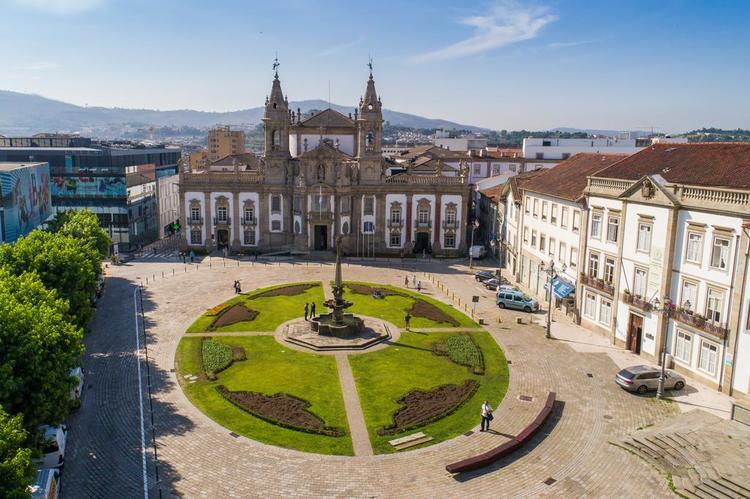
This beautiful hotel in Braga has comfortable accommodation with a restaurant, bar, and free parking. The 4-star Vila Gale Collection Braga is set in private gardens and has both an indoor and outdoor pool. Rooms here cost from €100 in April, and more information is available here.
Golden Tulip Hotel and Spa
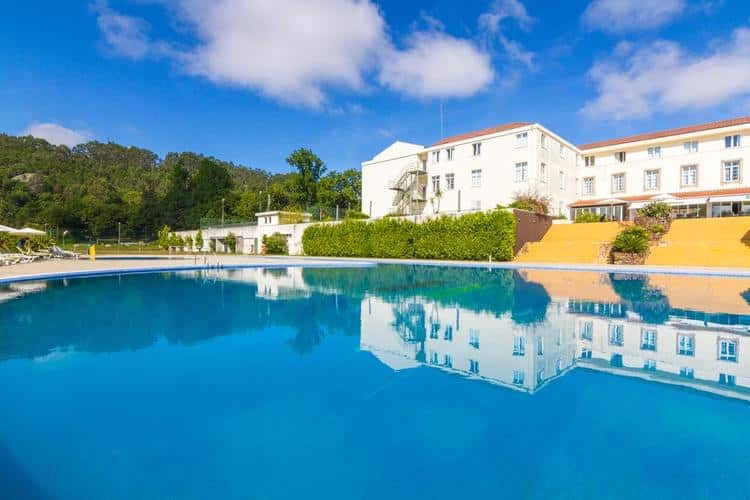
This restored 18th-century convent in the Minho region is conveniently located to enjoy Braga. It has indoor and outdoor pools for children and adults, and spa facilities to help you relax. The hotel’s Do Convento restaurant serves the best of local and international cuisine and boasts panoramic views of the valley that surrounds the hotel. Prices in April start from €80, and you can find more information and book your spot here .
- Are there any bank holidays in April?
Easter falls in April in 2020. April 10 is Good Friday, and Easter Sunday is on April 12. Easter is observed in Portugal, but supermarkets in cities will still be open on these days. April 25 is a national holiday every year and is known as Día da Liberdade (Freedom Day). It commemorates the 1974 Carnation Revolution that ended the dictatorship. It also celebrates the first free elections that took place a year later on April 25, 1975.
How hot is it in Portugal in April?
April in Portugal is generally pleasant weather but not very hot. Usually in the second half of April, Portugal starts to warm up, often between 21 and 25 degrees C. You might still get a rainy day here and there, so definitely prepare to dress in layers and bring a light jacket.
What is the best time of year to go to Portugal?
The best time of year to go to Portugal depends on what you’d like to experience during your Portugal vacation. Summer months are great beach weather. Spring and fall means fewer tourists, but still fabulous weather. Winter is rainy and cool – perfect for exploring without tourists!
What country is hot in April?
The warmest European countries in April include Portugal, Greece, and Spain. The Algarve, in southern Portugal, is particularly warm during April as compared to other parts of the country. While not quite summer beach weather, it’s dry, sunny, and delightful in April.
Where should I go in April?
If you’re visiting Portugal in April, consider the country’s southern region. The Algarve has some of the most beautiful beaches in Europe, and is already feeling early summer temperatures by mid-April. You’ll be able to shake off winter’s cold before the full tourist season begins.
Table of Contents
Related posts.
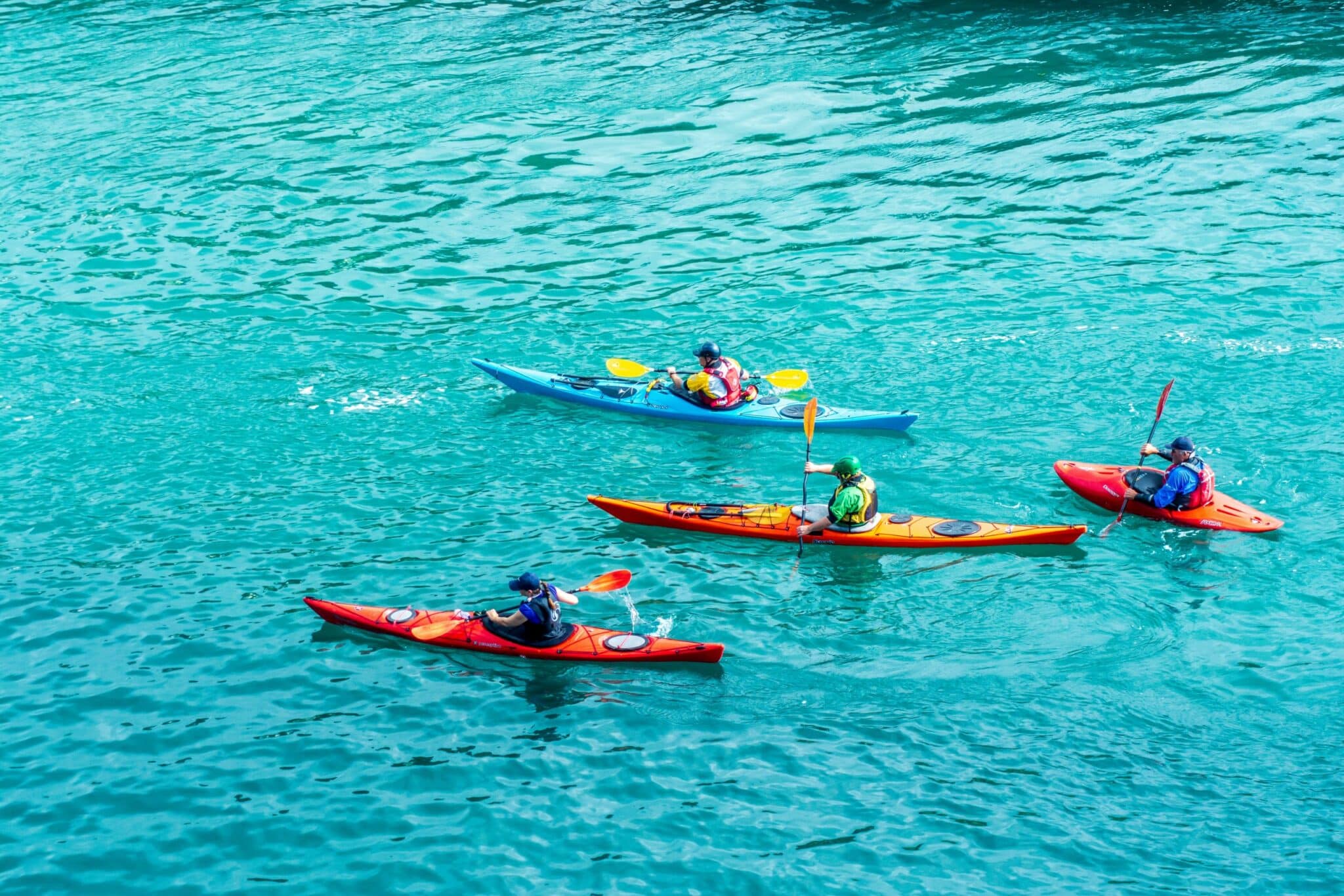
6 Amazing Places To Go Kayaking In Portugal
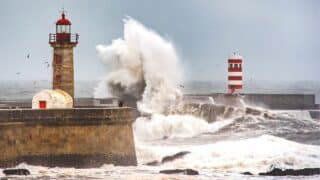
What is Portugal in Winter Really Like? Does it Snow?

9 Awesome Music Festivals in Portugal for Summer 2020
Retiring in Portugal: How Much Money Do You Need?
by Clara Higham-Stoianova
Portugal in August: Sunsets, Parties and Festivals
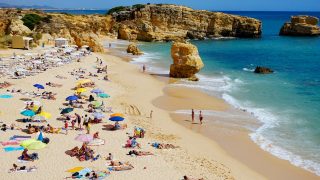
Stay up to date
Join our email list to receive weekly updates on webinars, promotions, announcements, social meet ups and more…
About BePortugal
Life in Portugal
Money in Portugal
Stay Connected
Keep up to date with industry insights and latest news.
Copyright © 2024 Expats Portugal
Privacy policy, terms of use.

- South Korea
- Indonesia (Bali)
- Central Asia
- African Safari
- South Africa
- Itinerary Ideas
- Portugal Weather in April 2024: Travel Tips for First-Timers
Portugal's spring weather means flowers are in full bloom in April , and the weather turns mild or warm and sunny most days along with showers and flowers. The weather is good for nature hikes, urban tours, and sightseeing the highlights.
Read on for our weather information and travel advice including average temperatures and rainfall, places to go, and travel tips…
Portugal Weather in April: Overview
- Temperature range: 12–20°C (54–68°F)
- Rainfall: 7 cm (3 inches)
- Rainy days: 10
- Humidity: 70%
- Sunshine hours/day: 7 hours
Discover real reviews of Highlights Travel Family 's best-rated service across trusted platforms.
April Climate Comparison (Averages) for Portugal's Top Tourism Areas
In April, Portugal is mild or warm at the low elevations, and because there are 7 hours of sunshine, you will often feel warm during the day at the tourist highlights. You could get out into nature for extended hikes and visit Portugal's historical and urban attractions.
Northern Portugal: The region has an Atlantic oceanic climate. There are more storms, rain, and cooler temperatures. Daily highs reach a pleasant 18°C (64°F) with 7 hours of warm sunshine.
Central and southern Portugal: The Algarve and the Alentejo region east of Lisbon generally experience Mediterranean-like weather. It is warmer, sunnier, and drier, so there is good weather for sightseeing, hiking, and touring. The area near Lisbon has good surfing conditions.
Madeira Island: Madeira gets cloudier in April.
Azores: See below.
The Best Places to Visit in Portugal in April
Portugal is one of the sunniest places in Europe, and in April, it is as sunny as Greece, except that Madeira gets cloudier. You could welcome the sunshine and warm weather while visiting historical places and ancient ruins and enjoy hiking. Flowers, both wild and cultivated, bloom abundantly
1.Lisbon — Enjoy Historical Highlights and Excursions to Beaches and Countryside Towns
Lisbon is the sunniest capital city in Europe with 8 hours of sunshine a day in April. The 70% humidity makes the average 20°C (68°F) daily highs actually feel a little warmer in the sun, so you can take pleasant warm walks. Low rainfall falls about 12 days in April.
Historic places such as the Castelo de São Jorge that is a big castle with a museum are highlights. When the weather is sunny, historic towns such as Sintra (30 minutes' drive) or Évora (90 minutes' drive) have countryside beauty to hike and stroll in and historic places and archeological sites.
There are good beaches near Lisbon. Ericeira that is about 35 minutes away by vehicle has about the best surf in Portugal in April. The sea temperature is about 16°C (60°F) or lower, so you will need a wetsuit for comfort.
2. Eastern Alentejo — Get Away to the Beauty of Spring
The middle belt region of the country east of Lisbon is called the Alentejo, and the central and eastern regions of the Alentejo are drier with pleasant weather and much sunshine in April. A good base for a tour of the area is Évora from which you could visit the countryside.
There are daily highs of about 21°C (70°F), 8 hours or more of sunshine, and 10 days of rain each April. Évora in Alentejo is 90 minutes from Lisbon by vehicle and has luxury and middle-budget hotels, Roman ruins, huge cathedrals and palaces and an estimated 7,000-year-old megalithic site.
The Alentejo countryside is one of the most beautiful in Portugal in April with pastures, farms and countryside. Great day trips include Arraiolos, where there is a castle and carpet making, and Estremoz, where there is a castle and lots of marble construction.
3. The Azores — Enjoy Adventure and Lush Beauty
The Azores have subtropical oceanic weather. It is pleasant and mild and when it is not raining, the weather is suitable for hiking, whale watching, and soaking in the hot springs. There are colorful wildflowers and lush greenery and many hiking paths.
There is a variety of terrain. Mount Pico is the tallest mountain in Portugal's territory with an elevation of 2,351 m (7,713 feet). The beaches are beautiful, but it is too cold to swim since the water temperature is 16°C (61°F). Accommodation prices are lower than in the busy summer months.
There is a mix of sunny days with highs about 18°C (64°F) and occasional rainy days. There are about 10 days of moderate rainfall, but the weather varies from island to island, and there are microclimates. Flights to Ponte Delgada (PDL) on Sao Miguel take two hours from Lisbon.
4.Algarve — Hike, Kayak, and Do Outdoor Activities in Pleasant Spring Weather
Algarve is the southern region of continental Portugal. In Algarve, the average daily highs reach 20°C (68°F), and you will feel comfortable even basking on the beaches most of the month with 8 hours of bright sunshine and 69% humidity. There are about 10 days of low rainfall in April.
In April, you can enjoy the hotels and resorts with low to moderate occupancy and prices, and there is a quiet ambience suitable for enjoying the outdoors. and Flight ticket prices are moderate. Almost everything is open, but not busy.
April and May are best for outdoor activities such as hiking, horseback riding, and mountain biking in the most beautiful scenery with fresh green vegetation and wildflowers dotting the hillsides and fields. You could hike the many trails, such as the Seven Hanging Valleys Trail, bike, and kayak.
Low Tourism Season: Touring Advice for April
Though there are no crowds like those of summer, the visitor numbers start to steadily rise in April, particularly in hotspots like the Algarve, where often the days seem like summer with bright sunshine and warm temperatures. The latter half of April is drier and more summerlike than the first half.
There are deals for flights and hotels unless it is Easter vacation period, when prices and traveler numbers are high. For many people, the summer is too bright and hot for outdoors activities, but April weather feels optimal. It is too cold for swimming though.
Public holidays in April:
- April 25 is Freedom Day , a national holiday. Businesses and government offices close. They celebrate the revolution in 1974 that ended the dictatorship and started the democracy.
- Easter: If Easter is in April, then Easter Sunday is a national holiday. The Friday before it, Good Friday, is also a national holiday. Easter 2024 is in March, but Easter 2025 is April 18–20.
What to Wear in April
You will need to bring a jacket, and dress in layers to be comfortable. Have an umbrella or poncho for rainy days especially if you are going to the north or mountains. Bring summer and beach clothes too.
Shoes: Sturdy shoes with good traction help you walk on the smooth cobblestone streets and historical sites and to prevent slips and fall. The historic cities and old towns have lots of old cobbled streets.
Wetsuits: The average sea temperature is about 16°C (61°F) or lower at most of Portugal's beach highlights in April, so it is too cold for swimming comfortably without a wetsuit.
UV protection: With so much sunshine in Portugal, if you have sensitive skin, wear a sunhat, and cover up with long sleeves and long trousers or dresses. You might want to wear polarized glasses too.
Recommended Tours for Portugal in April
We at Global Highlights specialize in hosting bespoke tailor-made tours, and we consider your travel goals and work with the weather and local culture to make your dream trip a reality. Enjoy a private tour with an expert guide and private driver who speaks Greek. Contact us to begin a tour inquiry.
Monthly Weather and Travel Information for Portugal
Previous month: Portugal in March
Next month: Portugal in May
Why Global Highlights (10,000+ reviews & 98.8% 5-star rating)
- Save Your Time:
- Less research, more enjoyment!
- Real-time 1V1 expert planning
- Maximize Your Flexibility:
- Personal local guide and ride
- Explore at your own pace
- Celebrate Your Journeys:
- Specially-crafted family adventures
- Celebrate milestones with style!
- 7-Day Portugal Family Beach Vacation
- 10-Day Portugal Family Adventure: Explore, Create & Relax
- 10-Day Portugal Highlights: History, Food & Coastal Charm
- 7-Day Family Fun in Portugal: Porto, Lisbon & Sintra Adventure
- How to Plan a Trip to Portugal in 2024
- How Long to Spend in Portugal (Top Itineraries and Side Trips)
- 7 Days in Portugal: 6 Top Itineraries for First-Timers
- How Long to Spend in Portugal, Spain, and Italy (3 Top Itineraries)
- Portugal Weather in January: Travel Tips for First-Timers
- Portugal Weather in February: Travel Tips for First-Timers
- Portugal Weather in March: Travel Tips for First-Timers
- Portugal Weather in May 2024: Travel Tips for First-Timers
- Portugal Weather in June 2024: Travel Tips for First-Timers
- Portugal Weather in July 2024: Travel Tips for First-Timers
- Portugal Weather in August 2024: Travel Tips for First-Timers
- Portugal Weather in September 2024: Travel Tips for First-Timers
- Portugal Weather in October 2024: Travel Tips for First-Timers
- Portugal Weather in November 2024: Travel Tips for First-Timers
- Portugal Weather in December 2024: Travel Tips for First-Timers
Get Inspired with Some Popular Itineraries
More travel ideas and inspiration, sign up to our newsletter.
Be the first to receive exciting updates, exclusive promotions, and valuable travel tips from our team of experts.
Why Global Highlights
Where can we take you today.
- Southeast Asia
- Japan, South Korea
- India, Nepal, Bhutan, and Sri lanka
- Travel Agents
- Loyalty Program
- Privacy Policy
Address: Building 6, Chuangyi Business Park, 70 Qilidian Road, Guilin, Guangxi, 541004, China
Weather in Portugal in April
Book your individual trip , stress-free with local travel experts
Select Month
- roughguides.com
- Travel guide
- Itineraries
- Local Experts
- Travel Advice
- Accommodation
Plan your tailor-made trip with a local expert
Book securely with money-back guarantee
Travel stress-free with local assistance and 24/7 support
Just wanted to express my thanks to Joel and Rough Guides for a wonderful trip! Everything was well-chosen and we just loved all of the hotels, sightseeing...
- The weather in Portugal in April at a glance
- Temperatures typically range from 12°C to 21°C (54°F to 70°F) , with warmer days becoming more frequent as the month progresses.
- April is the shoulder season for tourism in Portugal, meaning moderate to low crowds.
- Spring begins with blooming flowers, green landscapes, and cultural events throughout the country.
What is the weather like in Portugal in April?
Average temperatures in april, is april a good time to visit portugal, what about crowds and costs, festivals and events in april, ready for your dream trip to portugal.
- Visit Portugal in other months
The weather in Portugal in April is delightful. Spring kicks into gear, bringing warmer days and longer daylight hours. You'll find yourself basking in some lovely sunshine, making it prime time for a visit. While there might still be a stray shower (especially up north), overall, April sees a drop in rainfall compared to earlier months.
Just keep an eye out for those passing showers — especially if you're planning to hit the trails or relax on the beach . You’ll want to watch your step on the roads, particularly in rural areas, if it starts to rain.
On average, Portugal gets about 40-80mm of rain in April, but it usually comes and goes quickly, leaving plenty of sunshine in its wake.
April marks the start of the uptick in tourist numbers, but it's still not as busy as the peak summer months. Prices for accommodations and travel are reasonable, as April falls during the country’s shoulder season for tourism.
Overall, April can be a great time to visit Portugal because it offers delightful spring weather, perfect exploring outside, and fewer crowds to contend with.

Tips from Joel
Portugal Travel Expert

Remember, when dining in Portugal, it's important to be aware that there can be unexpected charges. It's not uncommon for certain items like bottled water or bread to be automatically added to the bill without prior consent. Some restaurants may apply a service charge, typically around 10%, especially in tourist areas or for larger groups. While these charges may seem minor individually, they can add up and catch you off guard if you aren’t expecting them.

The weather in Portugal in April is great for exploring Lisbon © Shutterstock
In April, Portugal welcomes the arrival of spring with mild and increasingly sunny weather. Coastal areas experience pleasant temperatures, while inland regions begin to warm up. Daytime temperatures typically range from 15°C to 20°C (59°F to 68°F), with some warmer days reaching up to 25°C (77°F). Nighttime lows generally hover between 8°C to 13°C (46°F to 55°F). Rainfall is possible, especially in the north.
Porto and northern Portugal
In Porto and northern Portugal , April ushers in mild and pleasant weather, perfect for outdoor activities and sightseeing. Average lows range from 8°C to 11°C (46°F to 52°F), while highs typically reach between 15°C to 18°C (59°F to 64°F). Spring showers are still possible, but rainfall decreases compared to the earlier months, allowing for more sunshine and blue skies.
Lisbon and central Portugal
Moving down to Lisbon and central Portugal , April showcases the region's charm with mild temperatures and blooming landscapes. Average lows hover around 11°C to 13°C (52°F to 55°F), while highs range from 18°C to 21°C (64°F to 70°F). Rainfall remains low, and the region enjoys plenty of sunny days.
The Algarve and southern Portugal
In the southern region of Portugal, including the Algarve, April marks the beginning of beach season as temperatures rise and the sun shines brightly. Average lows range from 12°C to 14°C (54°F to 57°F), while highs reach around 19°C to 22°C (66°F to 72°F). Rainfall is minimal, and the region experiences warm sea breezes.
The island of Madeira continues to enjoy its pleasant subtropical climate in April , with warm temperatures and abundant sunshine. Average lows range from 15°C to 17°C (59°F to 63°F), while highs average between 20°C to 23°C (68°F to 73°F). Rainfall remains low.

Colourful Sintra, Portugal palace Palácio da Pena © Shutterstock
April is often touted as a fantastic time to visit, and it's easy to see why. With its mild weather, blooming landscapes, and a calendar packed with events (more on that below), it's a top pick for many.
Portugal truly comes to life in April, as spring brings mild temperatures and a burst of foliage, with flowers blossoming across gardens, parks, and vineyards. Don't miss the opportunity to visit botanical gardens or take leisurely strolls through parks to admire the colorful flowers in bloom.
April is an excellent time for outdoor activities in Portugal. Consider hiking in the beautiful Douro Valley or exploring the coastal cliffs of the Algarve region. Just remember to bring appropriate footwear and sun protection.
If you're a beach lover, you may find that the water might still be a tad brisk for swimming. That said, Portugal boasts some of the most breathtaking coastal landscapes in Europe , and the beaches are perfect for soaking up the sun and enjoying leisurely strolls along the shore.
While it's not as jam-packed as the peak summer months, April still sees a noticeable uptick in visitors, especially around the Easter holidays. This means you might encounter some crowds at popular tourist spots and beaches, but don't worry – there are still quieter spots to discover, especially in lesser-known regions.
As for costs, April marks the start of the tourist season, so you can expect a gradual rise in accommodation and transportation prices compared to the quieter winter months. However, it's still more wallet-friendly than the peak summer season.
April is a great month to see Portugal because it’s a good balance of comfortable weather and relatively thin crowds.
If you're keen on avoiding the crowds but still want similar weather conditions, consider planning your trip for late September or early October. These months offer mild temperatures and fewer tourists compared to April.
Ready to explore Portugal? Start preparing by finding out how to get there .

The weather in Portugal in April is great for exploring Porto © Shutterstock
As you gear up for your upcoming trip to Portugal in April, take a look to see if any exciting festivities are happeningsavory in town during that time. Additionally, it's advisable to book your accommodations as early as possible. If you're seeking further inspiration for your trip, browse through our carefully curated list of the best things to do in Portugal .
Semana Santa
Semana Santa, or Holy Week, is observed with solemn religious processions and ceremonies in towns and cities across Portugal . From Palm Sunday to Easter Sunday, churches come alive with prayers, Masses, and rituals that commemorate the passion, death, and resurrection of Jesus Christ. It's a time of reflection, devotion, and spiritual renewal for Catholics throughout the country.
Chocolate Festival
Chocolate lovers won’t want to miss the Chocolate Festival, where cocoa takes center stage in various sweet and savoury creations. From chocolate sculptures to decadent desserts, visitors can indulge their sweet tooth and explore the rich flavors and textures of chocolate in all its forms.

Praia da Rocha, Portimao, Algarve, Portugal © Shutterstock
Peixe em Lisboa
Peixe em Lisboa, or Lisbon Fish and Flavors Festival, celebrates Portugal's rich seafood tradition with a showcase of the country's finest fish and seafood dishes. From grilled sardines to seafood stew, visitors can sample a diverse array of culinary delights prepared by top chefs and restaurants from Lisbon and beyond. Cooking demonstrations, tastings, and workshops add to the gastronomic experience, making it a must-visit for culinary enthusiasts.
Festa das Tochas
Festa das Tochas, or Torch Festival, is a traditional event held in various towns and villages across Portugal, particularly in the Alentejo region. Participants carry torches through the streets, illuminating the night with flickering flames and creating a magical atmosphere. It's a celebration of light, community, and the arrival of spring.
Festa das Cruzes
Festa das Cruzes, or Festival of the Crosses, is celebrated in various towns and villages across Portugal, with particular grandeur in Barcelos. Streets and squares are adorned with colourful flower-covered crosses, and processions, concerts, and traditional dances enliven the atmosphere. It's a joyful celebration of faith, community, and the renewal of nature.

Cooking class in Algarve, Portugal © Dre Roelandt
Are you ready to go on your trip? Our tailor-made trips are created by local travel experts and are completely customisable. Plus, while on your trip, you’ll have 24/7 support. Here are some of our Portugal trips:
- North Portugal trip (8 days): From Porto, explore the best of Northern Portugal: hike along the Paiva River, tour the Serra da Arada by jeep, and enjoy Douro Valley wines.
- Best of Portugal (12 days): Short on time? This trip covers Portugal's top highlights: Lisbon, Porto, Douro Valley, and the beautiful Algarve beaches.
- Azores wild nature (7 days):Discover São Miguel, the largest Azorean island, on a 6-day adventure. Swim with dolphins, abseil waterfalls, bike through Sete Cidades, and relax in natural spas.
Or browse our other Portugal itineraries .
Looking for more options for your holiday in April? Find the perfect holiday destination with our top suggestions .
Visit Portugal in other months
Not sure when to go to Portugal? See our guide to other months:
- January : The weather's nice and the tourist crowds are thin, so it's a perfect time to dive into the cities without all the hustle.
- February : February's just like January - cool and quiet. It's great for leisurely walks through Portugal's charming streets with fewer people around.
- March : Spring is here, bringing with it pleasant temps and moderate crowds, especially along the coast. Perfect for enjoying the blooming flowers and coastal breezes.
- May : Spring's in full swing, and Portugal's buzzing with warm weather and lively crowds, especially during festivals and outdoor events.
- June : Summer's officially started, and it's hot! Beaches and landmarks are bustling, making it the ideal time for sun-soaked adventures.
- July : The heat's cranking up, and so are the crowds. Tourists are flocking to Portugal's sandy shores and popular spots.
- August : It's scorching in August, and the crowds are out in force. Beaches and tourist hotspots are packed, offering a lively but sometimes crowded experience.
- September : As summer winds down, the crowds thin out, but the warm weather sticks around. September is a fantastic time to visit Portugal without the summer rush.
- October : With mild temperatures and fewer tourists, October's calling for some relaxed exploration. Enjoy Portugal's natural beauty and cultural gems without the crowds.
- November : Autumn brings cooler temps and a quieter atmosphere. It's perfect for cosying up in cafes or taking scenic drives through the countryside.
- December : Cool weather and festive crowds add to the charm of its cities and towns, making it a delightful time to experience the country's traditions and celebrations.
The Rough Guides to Portugal and related travel guides
In-depth, easy-to-use travel guides filled with expert advice.

Travel advice for Portugal
From travel safety to visa requirements, discover the best tips for traveling to Portugal
- Eating and drinking in Portugal
- How to get to Portugal
- Getting around Portugal: Transportation Tips
- Shopping tips for Portugal
- Travel Tips Portugal for planning and on the go
- Best time to visit Portugal
- 7 days in Portugal — 5 travel itineraries
Find even more inspiration here

written by Dre Roelandt
updated 07.06.2024
Dre Roelandt is originally from the United States but lives and works in Berlin, Germany. Dre is a freelance writer and artist with a passion for travelling. They are an in-house Content Editor at Rough Guides.
Ready to travel and discover Portugal?
Get support from our local experts for stress-free planning & worry-free travels.
- Where to stay
- Travel advice
- June 9, 2024
- Dream Destinations , Europe
Portugal in April: Weather, Events, Activities and What Else to Expect on Your Trip

April is an ideal time to visit Portugal , offering mild weather, blooming landscapes, and a host of cultural events.
From the vibrant cities of Lisbon and Porto to the picturesque countryside and stunning coastline, Portugal in April promises a blend of relaxation, adventure, and cultural exploration.
This guide will help you plan your trip, covering everything from weather patterns to activities, events, and culinary delights.
Chapter Trail
Weather in portugal in april.
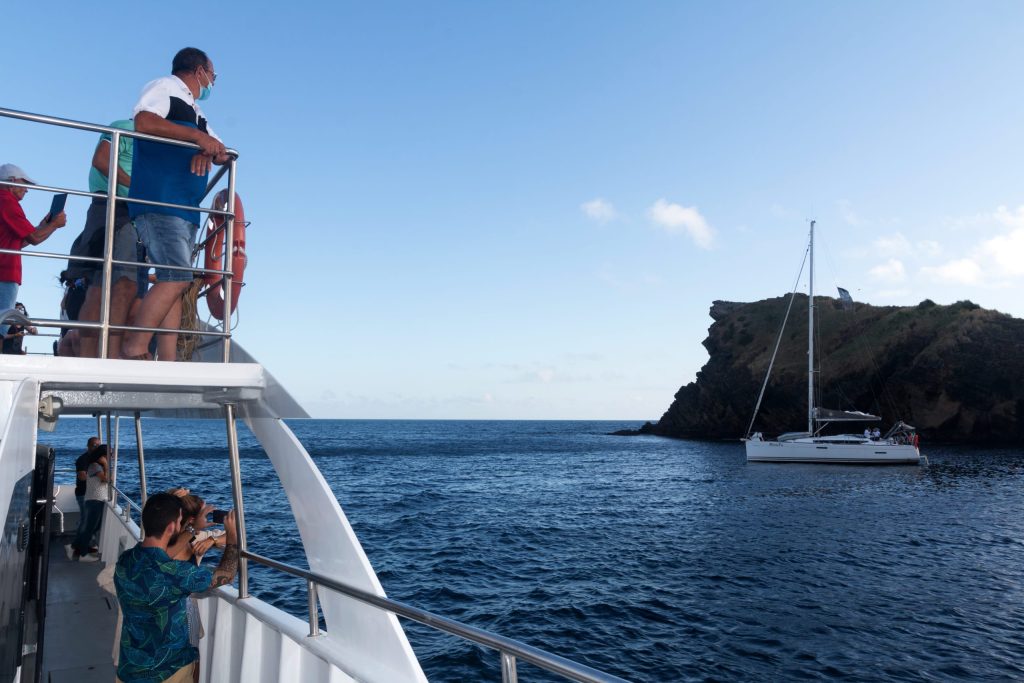
April in Portugal is characterized by pleasant spring weather, making it an excellent time for outdoor activities and sightseeing. Here’s what you can expect:
- Lisbon : Temperatures range from 11°C to 20°C (52°F to 68°F). The weather is generally sunny with occasional rain showers.
- Porto: Temperatures range from 10°C to 18°C (50°F to 64°F), with a mix of sunny and rainy days.
- Algarve: Temperatures range from 12°C to 22°C (54°F to 72°F). This region enjoys more sunshine and warmer temperatures, perfect for beach activities.
The weather is comfortable for exploring both urban and rural areas, with the added beauty of spring blooms enhancing the scenery.
What to Do and Expect In Portugal In April
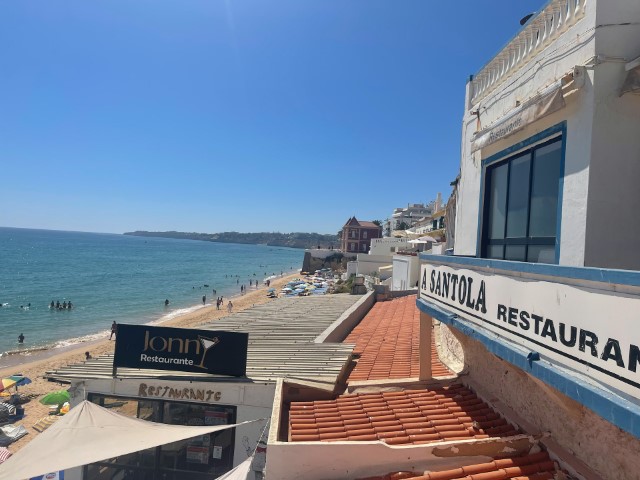
Here are some of the activities that you can enjoy in Portugal for April:
Relax in the Algarve
Enjoy the beautiful beaches of Lagos, Albufeira, and Faro. Explore the dramatic cliffs and hidden coves along the coastline, or take a boat trip to the Benagil Cave.
Explore the Douro Valley
Take a scenic drive or river cruise through the Douro Valley, famous for its terraced vineyards and wine production. Visit local wineries for tastings and tours.
Hike in Nature Parks
Enjoy hiking in Portugal’s national parks , such as Peneda-Gerês, Arrábida, and Serra da Estrela. Experience the diverse flora and fauna, and take in stunning natural vistas.
Visit Sintra
Just a short trip from Lisbon, Sintra is known for its fairytale-like palaces and gardens. Explore the Pena Palace, Quinta da Regaleira, and the Moorish Castle.
Discover Porto
Wander through the Ribeira district, visit the stunning Livraria Lello bookstore, and tour the famous port wine cellars. Don’t miss a cruise on the Douro River for breathtaking views.
Events and Festivals in Portugal in April
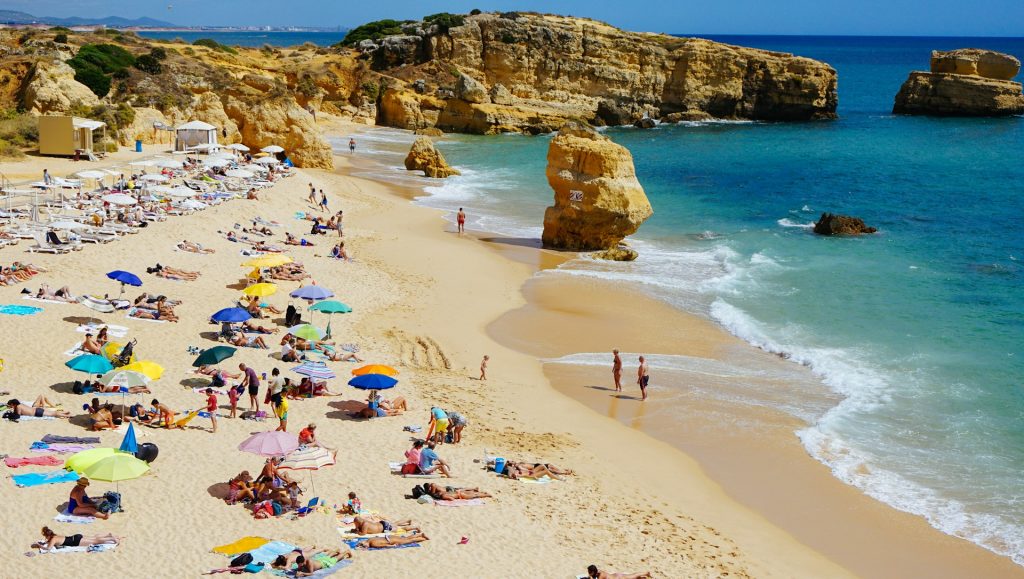
Here are some of the vibrant festivals that you can witness in Portugal for an April visit:
Easter Celebrations
Easter is widely celebrated in Portugal, with processions, religious ceremonies, and festive events taking place across the country. Braga is particularly known for its elaborate Holy Week processions.
Liberty Day (Dia da Liberdade)
Celebrated on April 25th, this national holiday commemorates the Carnation Revolution of 1974, which ended the dictatorship. Enjoy parades, concerts, and cultural events, especially in Lisbon .
Festa das Tochas Floridas
Held in São Brás de Alportel in the Algarve, this festival features beautifully decorated flower torches and processions, celebrating the resurrection of Christ.
Food to Enjoy in Portugal in April

Portuguese cuisine in April features fresh, seasonal ingredients and traditional flavors. Here are some must-try dishes and seasonal delights:
- Bacalhau à Brás: A popular dish made with shredded salted cod, onions, and thinly cut fried potatoes, all bound together with scrambled eggs.
- Caldo Verde: A traditional soup made with kale, potatoes, and chorizo, perfect for a light yet hearty meal.
- Pastéis de Nata: These famous Portuguese custard tarts are a must-try. Enjoy them fresh from the oven with a sprinkle of cinnamon.
- Grilled Sardines: Fresh sardines grilled to perfection and served with a squeeze of lemon, typically enjoyed in coastal areas.
- Spring Vegetables: April brings a variety of fresh vegetables, such as asparagus, peas, and artichokes, often featured in local dishes.
- Portuguese Wine: Sample a variety of Portuguese wines, from the crisp Vinho Verde to the rich and robust reds of the Douro Valley.
Why You Should Take a Trip to Portugal in April

Here’s why you should consider visiting Portugal in April:
Pleasant Weather
April’s mild temperatures and sunny days are ideal for exploring both urban and rural areas without the heat of summer.
Fewer Crowds
Enjoy popular tourist attractions with fewer crowds compared to the peak summer season, providing a more relaxed and intimate experience.
Spring Blooms
Experience the stunning beauty of Portugal in spring, with blooming flowers and lush landscapes adding to the charm of your trip.
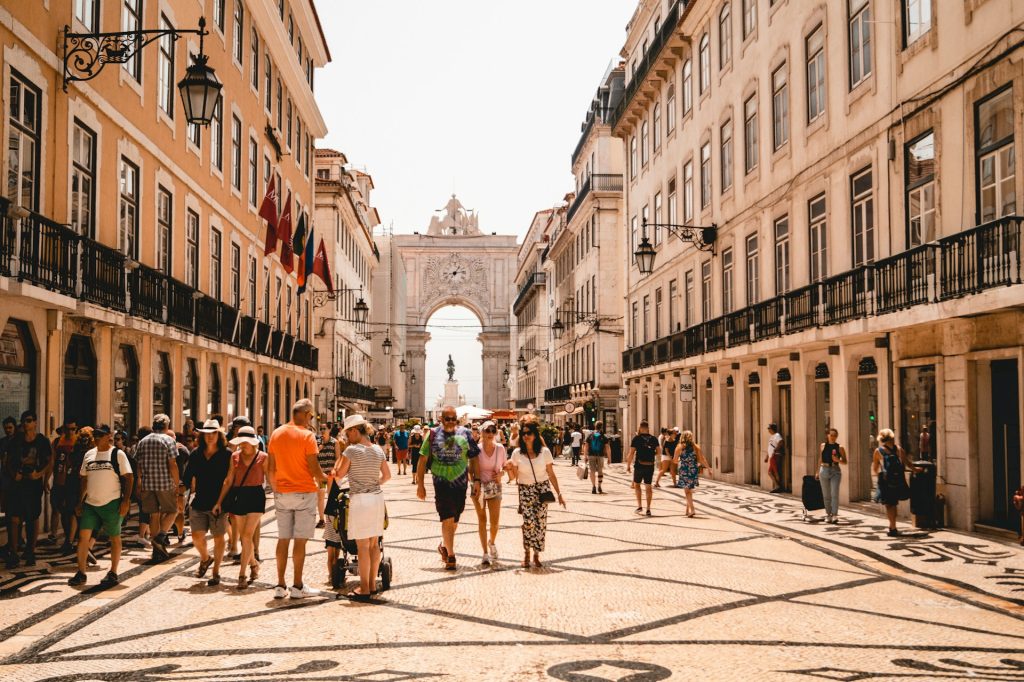
A trip to Portugal in April offers a delightful mix of cultural exploration, natural beauty, and pleasant weather.
Whether you’re wandering through historic cities, relaxing on stunning beaches, or enjoying scenic hikes, this captivating country provides a unique and memorable travel experience. Plan your April getaway to Portugal and immerse yourself in the vibrant culture, stunning landscapes, and warm hospitality of this enchanting destination.
Check out Baboo Travel’s free itinerary for your custom trip to Portugal below:
Explore Baboo Showcase Itineraries
Baboo tours & local experts.
Plan your next dream trip with one of our hand-picked, highly experienced, licensed, and insured Local In-destination Experts!

Here you can find some amazing travel stories, to tickle your travel bone or just to dream away. Sometimes we travel without moving.

A Transformative Journey: My Psilocybin Healing Mushroom Retreat with Baboo Travel
An immersive exploration into the realms of consciousness and purpose
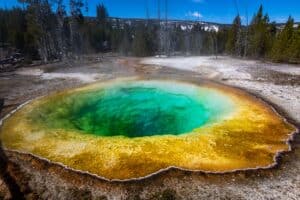
A Family Adventure: Why Summer is the Best Time to Visit Yellowstone
Get the lowdown on what your family can enjoy at Yellowstone

All Your Questions Answered About A Vacation in Lake Como
A blend of natural beauty, cultural heritage, and luxury experiences

Unlock the world’s secrets

- How it Works
- Sustainability
- Start New Trip

Algarve in April: What It’s Really Like, Weather & Seasonal Tips
By Author Jurga
Posted on Last updated: January 22, 2024
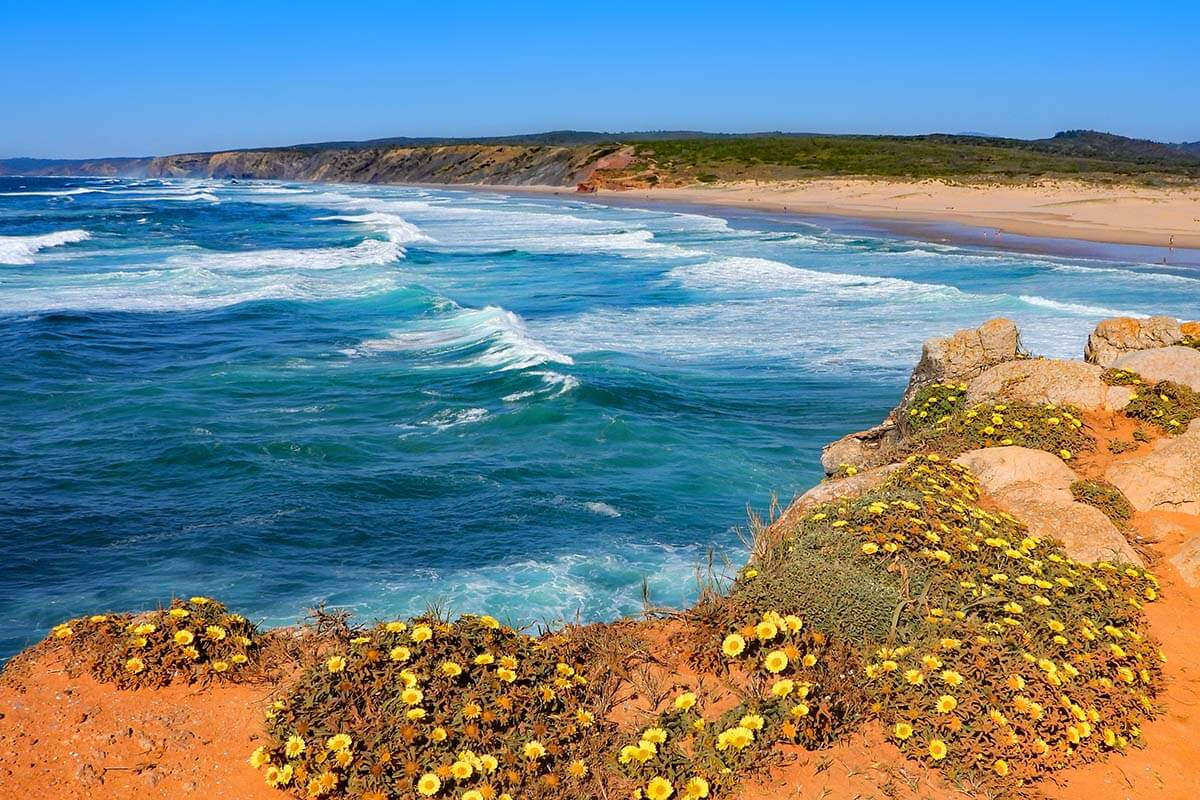
Algarve in southern Portugal is a destination that has something to offer at any time of the year. But your experience will highly depend on the season or even the specific month when you visit. In this guide, you can learn what to expect when visiting the Algarve in April.
What is the weather like in Algarve in April? What kind of clothes to pack? How busy is it? Is everything open? Is everything closed at Easter? Is April a good month for beaches, hiking, or sightseeing in the Algarve? Can you swim in the sea?…
In this article, you can find answers to all these questions, as well as our experience-based tips for your spring visit to this beautiful part of Portugal. We also share the advantages and disadvantages of visiting the Algarve in April.
Top 3 Experiences & Tours in Algarve:
- Benagil Cave boat tours .
- Ponta da Piedade grottos and sea caves .
- Zoomarine (usually open daily in April).
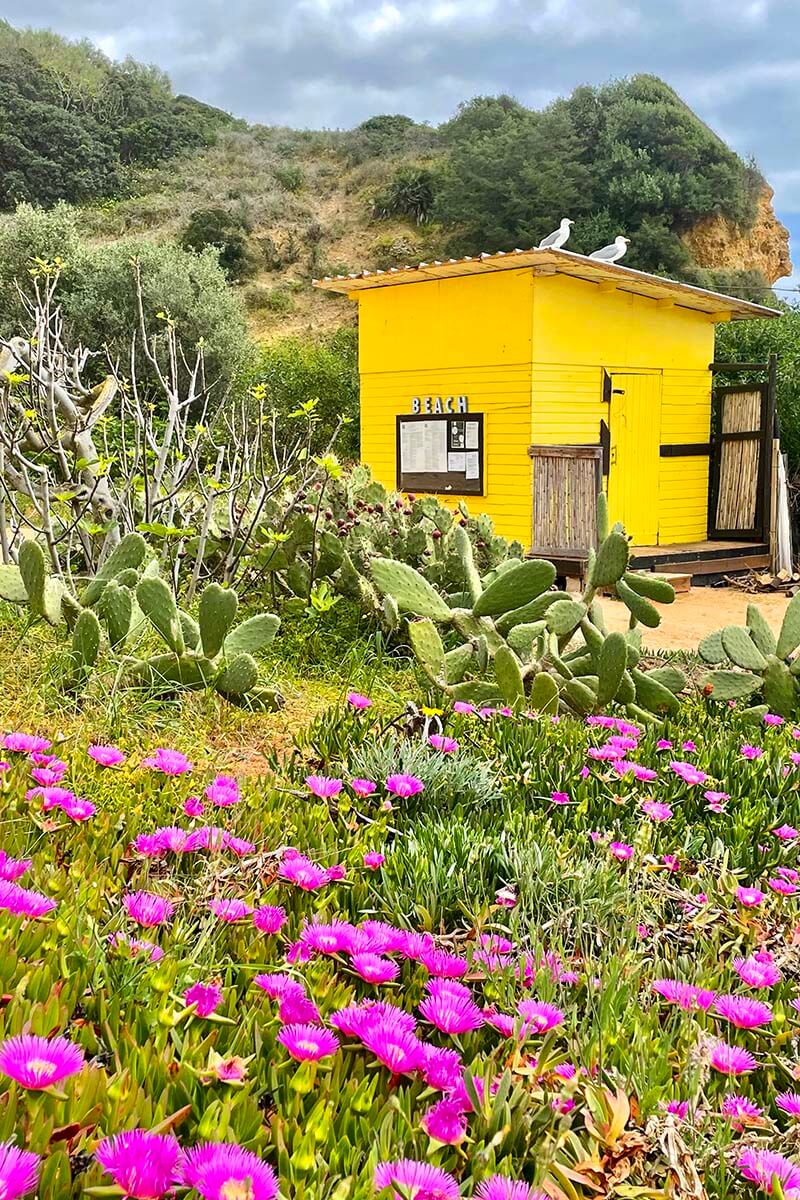
What kind of weather and temperatures to expect in Algarve in April?
April is a bit of a shoulder month between the ‘winter’ weather (which is already very mild in the Algarve) and the warm summer weather. So quite frankly, it’s impossible to predict in advance what kind of weather you’ll get in April.
Most likely, it will be nice and sunny with daytime temperatures around 20°C (68°F).
When I searched the Internet for ‘Algarve temperature in April’, pretty much every website said something different. Some say that the average daytime temperature in the Algarve in April is 15°C (59°F), some others – 20°C (68°F). According to some websites, the average low temperatures are around 10°C (50°F), others say it’s 15°C (59°F)…
This might have to do with the fact that the Algarve is quite a big region, and so these stats are likely influenced depending on the exact location.
So according to statistics, average April temperatures in the Algarve are between 10 – 20°C (50-70°F). However, these averages really don’t tell you much and it’s quite possible that you’ll experience temperatures around 25°C (77°F) or even higher.
But while the sun shines most of the time , you should know that there is always a possibility of some rain in the Algarve in April. Just don’t stress about it because the weather forecast changes all the time, and the average number of days when it rains is just 3 in the entire month of April. Furthermore, even if it rains, it usually doesn’t last longer than a few hours.
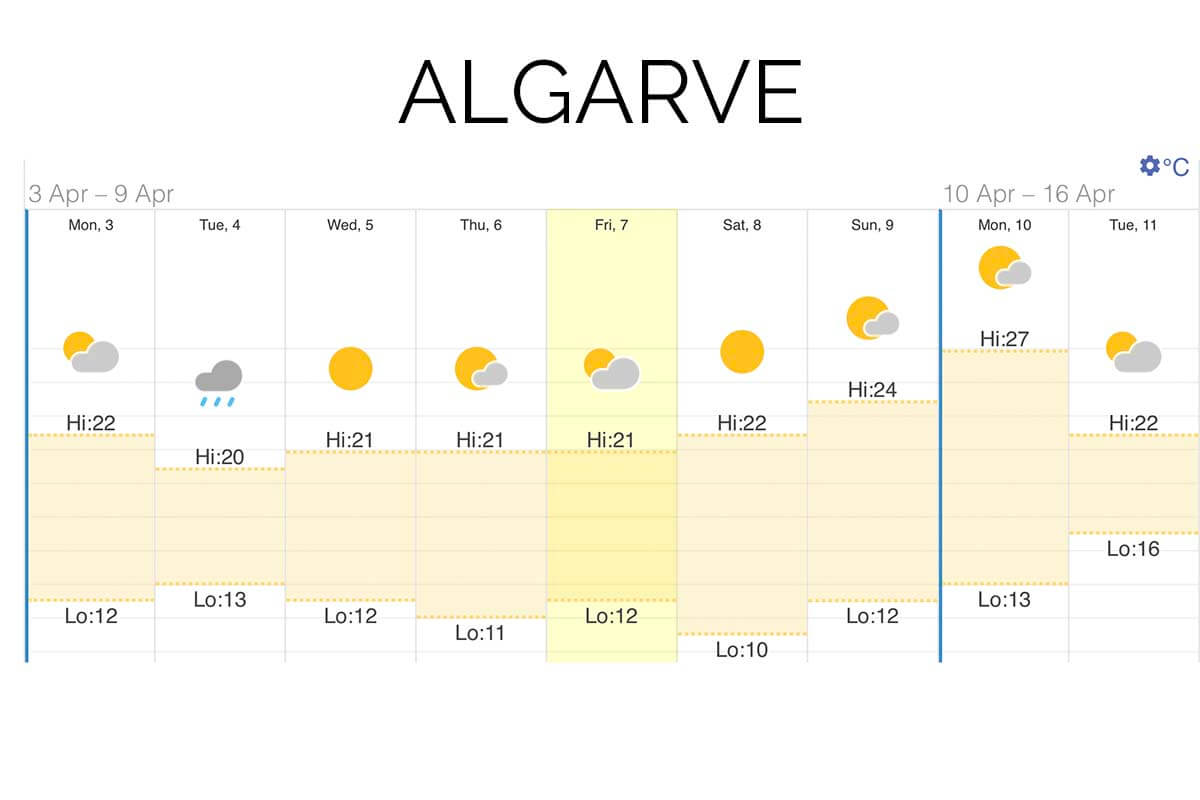
Our experience: We’ve been to Algarve in April a few times (and loved it every time).
One year, the coldest day we got was 15-17°C (59-63°f) with a few drops of rain. All the other days were sunny with temperatures around 18-20°C (64-68°F) – perfect for hiking and sightseeing.
Just recently, we spent 3 weeks in the Algarve in April and it was sunny and warm enough for the beach every single day. Daytime temperatures averaged around 22-25°C (72-77°F) for three weeks in a row, and there were even a few days when it got as warm as 28-30°C (82-86°F). This kind of weather continued for days and days after we left as well. So the entire month of April was beautiful and summer-like.
But even on the warmest days in April, evenings and nights get quite chilly. Plus, the wind can get quite strong as well.
If there is one tip I can give you is don’t worry about the weather too much when planning your trip. Instead, simply make a list of activities that you can do depending on the temperature.
April is an amazing time to visit the Algarve, one of our favorite months, actually, and there is plenty to see and do beyond sunbathing. Check out the most beautiful beaches of the Algarve and don’t miss the stunning scenery along the coastal Seven Hanging Valleys Trail . April is a perfect month for this hike!
READ ALSO: Ponta da Piedade (an absolute must-see in Algarve!)
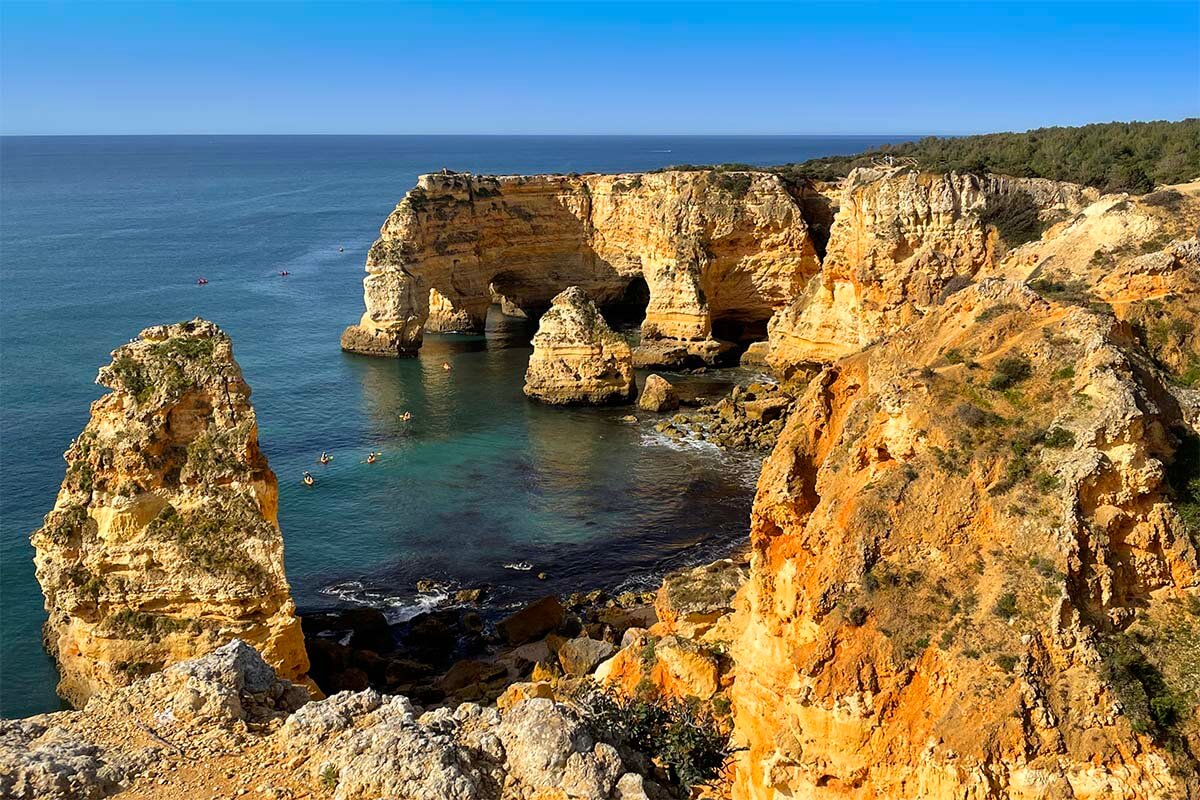
What to wear in Algarve in April?
As you can imagine, there’s a big difference between packing for temperatures around 10-15°C and rain or for 20-25 °C and sunshine. And while most of the time you’ll probably be wearing shorts and T-shirts, you really should be prepared for everything in April.
So when packing for the Algarve holiday in April, in addition to summer clothing and swimwear, be sure to take a few extra layers, like a sweater and a light rain jacket. (You will likely need these warmer clothes when traveling to/from the airport in your home country anyway).
Even if it’s very warm during the day, you will usually need a sweater the moment the sun goes down.
Also, you should know that it can be quite windy in the Algarve. So it’s always a good idea to have a sweater or a light jacket for boat trips and sightseeing as well.
That being said, on our recent trip, we only needed sweaters on two days out of three weeks. Or long pants and rain jackets stayed in the suitcase until it was time to go to the airport and head back home.
On the other hand, on previous trips, we wore sweaters, jeans, and even light jackets much more often… So you just never really know until you get there.
Important! Don’t underestimate the sun in the Algarve and use plenty of sunscreen lotion. Every time, we see tourists as red as lobsters in the Algarve. It’s as if people seem to think that you can only get burned in the summer. Even on colder days when you are wearing a sweater, you can still burn your face or your legs in no time. A sun hat and sunglasses are a must as well.
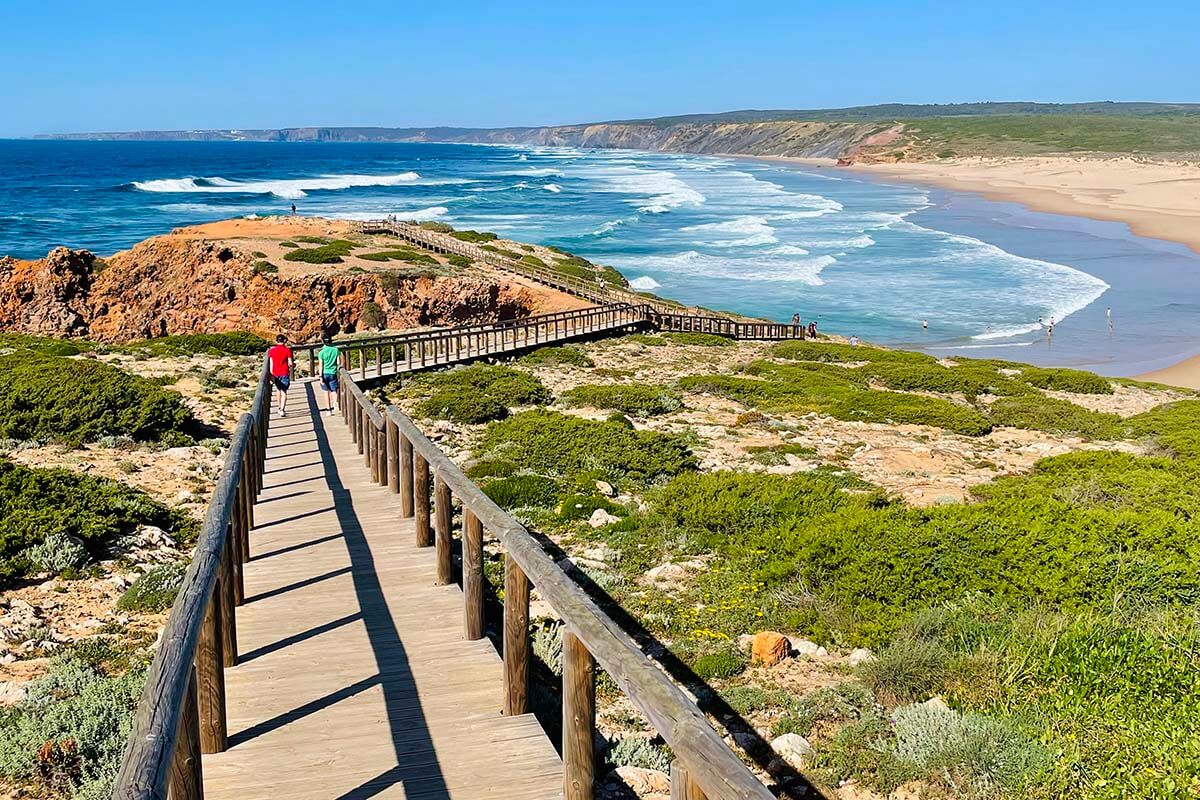
Is everything open in the Algarve in April?
When we first visited the Algarve in April a few years ago, quite a lot of smaller towns looked really quiet, with some hotels and many restaurants still closed at the beginning of the month. However, on our most recent trip, the situation seems to have changed completely, and almost everything was open in April even in the smaller villages.
This might have to do with the post-pandemic shift in travel behavior or the increased popularity of Portugal among international travelers, but there has clearly been a noticeable change in how lively the Algarve is in April.
Nowadays, pretty much everything is open in the Algarve in April, including small beach restaurants and even some water parks. For example, Zoomarine and Slide & Splash water parks are already open for the season. That being said, the water in the unheated outdoor pools is still quite cold, and so many smaller outdoor water parks are still closed in April.
Also, some places have limited opening times in April. For example, we did encounter a few attractions that were only open in the afternoon, a few beach restaurants that closed at 5-6 pm, and some restaurants in towns that were open for dinner but not for lunch… But overall, you won’t have any trouble finding fun things to do or good places to eat in Algarve in April.
READ ALSO: Best Restaurants in Albufeira
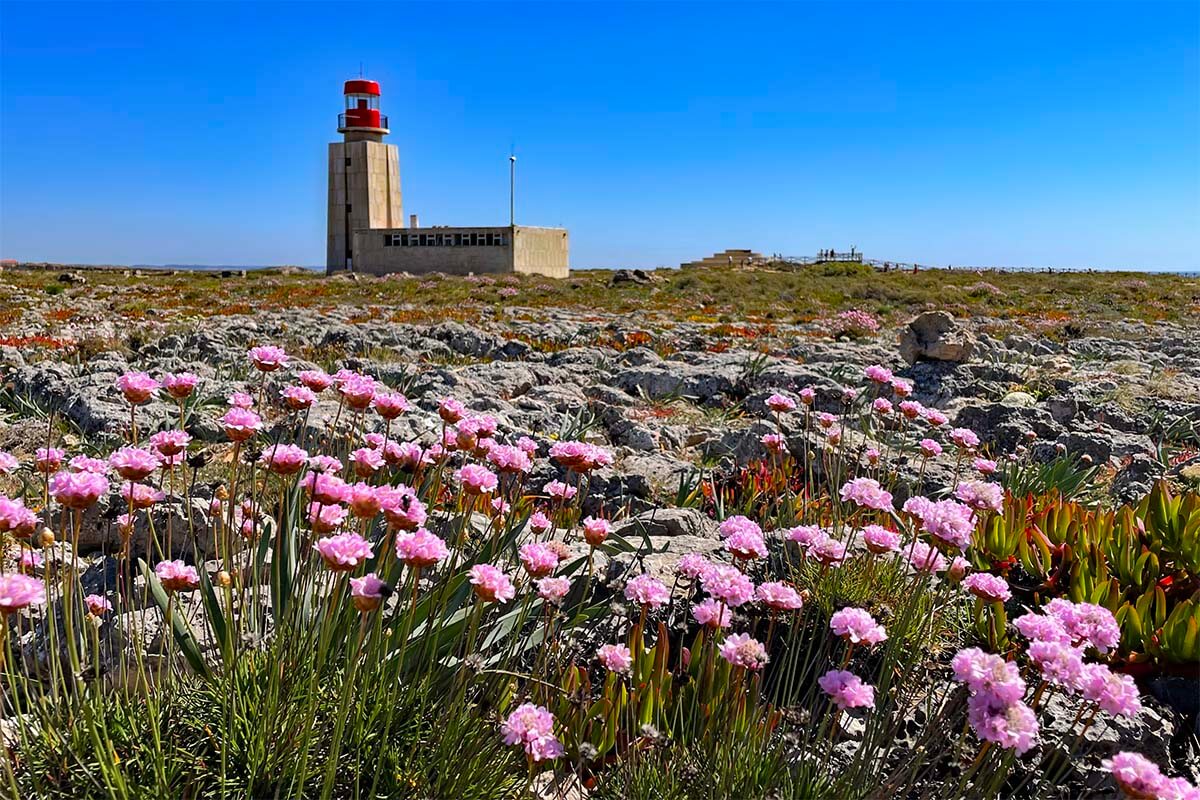
How busy is it?
April is still a rather quiet month in the Algarve, except for a few days around Easter. But even on the busiest weekend and in the busiest towns of the Algarve, such as Albufeira , Lagos , Faro , Tavira , or Vilamoura, it’s just pleasantly lively everywhere.
You won’t have to get up at dawn in order to find empty chairs at the pool or on the beach, parking isn’t a big issue at most places yet, and you can simply show up at most restaurants without an advance reservation.
That being said, Algarve is getting more and more popular in the shoulder season as well, so some advance planning is always useful.
If you are thinking of visiting some of the most popular places, try to arrive before 10-11 am so that you don’t have to worry about finding a parking spot. If you want to be sure to do a specific activity or excursion at the time that suits you best, it’s always best to book at least a day or two in advance.
The busiest place in Algarve in April (or any time of the year) is the famous Benagil Cave – more info below.
But overall, visiting Algarve in April is very relaxing.
LEARN MORE: Best Towns to Visit in Algarve
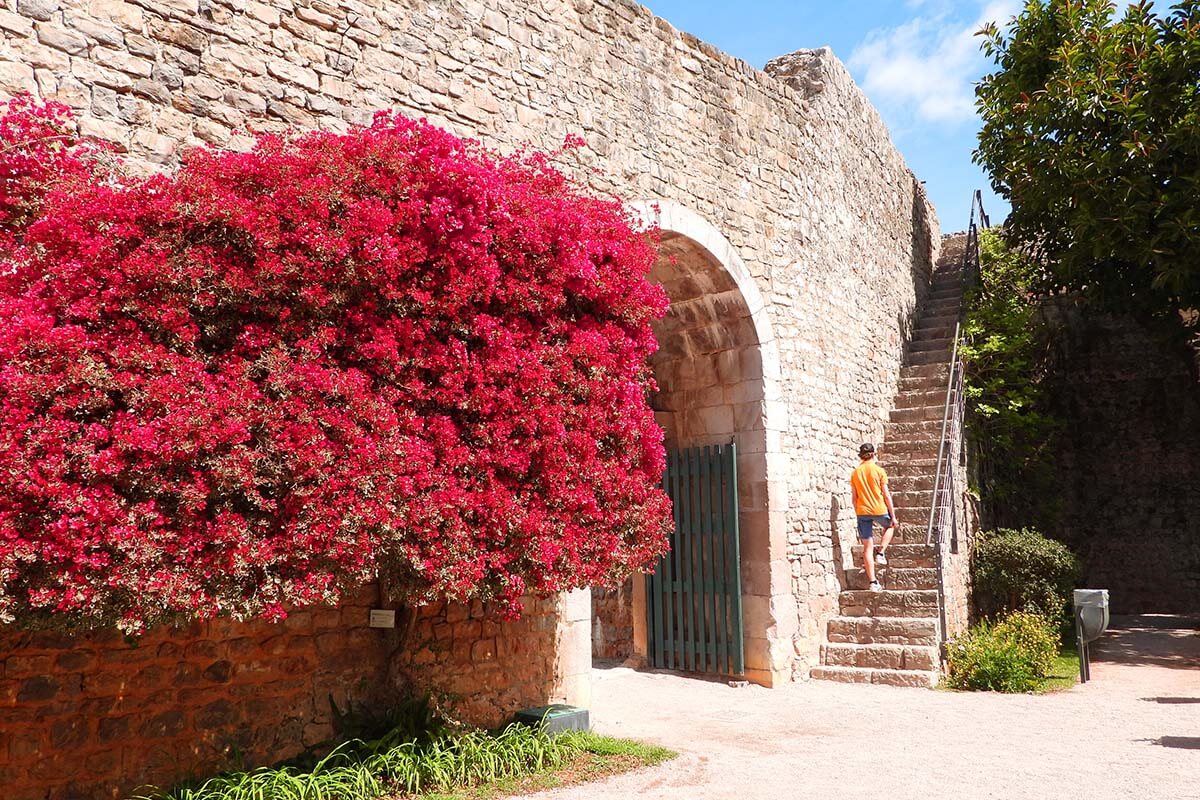
What to see and do in Algarve in April?
You can see and do pretty much everything that you want to in the Algarve in April. Of course, some activities like water sports are a bit more weather dependent, but if you get lucky with the weather, you can even go swimming in the sea.
Because April temperatures in the Algarve are usually not too high yet, it’s a perfect month for sightseeing, hiking, and outdoor activities like biking, boat tours , jeep excursions , quad tours , (mini)golf, adventure parks, etc. April is also a great month for kayaking , surfing, parasailing , and long walks on the beach.
It’s also one of the best times of the year to see some of the most beautiful flowers and stunning sunrises and sunsets. The nicest sunsets and sunrises are on warm days with cold nights.
There are just a few things that April is not ideal for. One of them is birdwatching because most birds that spend winters in the Algarve region usually start to leave in March. And the second is outdoor pools and waterparks because it can be just a bit too cold to properly enjoy them. But – depending on the temperatures – the latter may not be such a big issue.
April weather is perfect for sightseeing, so be sure to visit the stunning coastal areas and at least a few of the nicest towns in the region!
LEARN MORE: Top Places to See in Algarve & Algarve Sightseeing Itinerary
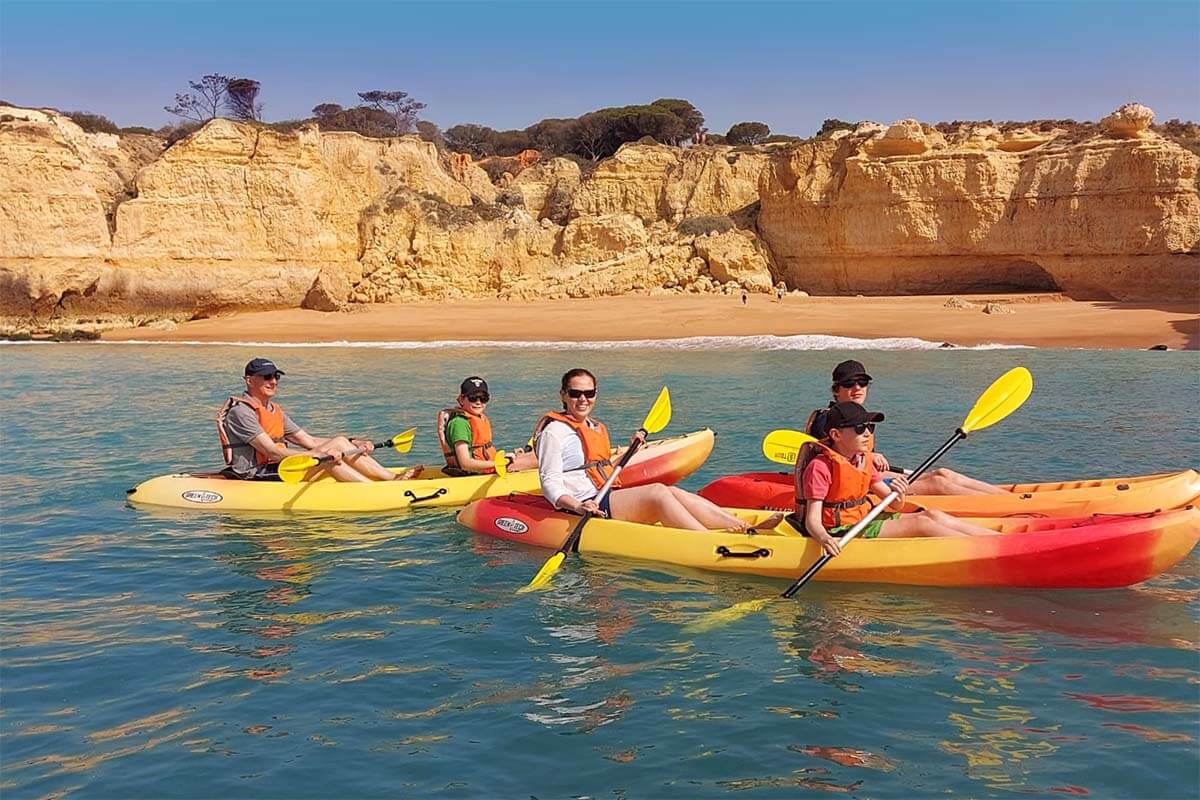
Benagil Cave in April
Benagil Cave is one of the most popular places in the Algarve region.
It’s a sea cave that can be best admired from the water, so the best way to visit is by boat. However, if the waves are too high, the boats may not be able to enter the cave.
While it can happen that the sea is a bit too rough for sea caves in April, overall, it’s a good time to visit Benagil Cave. The very first time when we visited Algarve in April years ago, it was very windy and the sea was quite rough, but even then, the boats were going in and out of the cave without any issues. Anyway, it’s not something you can foresee in advance and it can happen in the summer too. But the coastline is so beautiful that we find a boat trip worth it in any case.
Good to know: Even in April, there are tens of boats in and around the cave pretty much the entire day. If you want to avoid the biggest crowds, go as early in the morning as you can! The sea is generally also much quieter in the morning than later in the day.
We have a detailed guide about visiting Benagil Cave where you can find all the information about the boat tours, kayak options, and also how to see the cave from above without going on a boat (it’s not nearly as impressive, but nice to do in addition to seeing it from inside). You can find all this info via the link below.
LEARN MORE: Benagil Cave
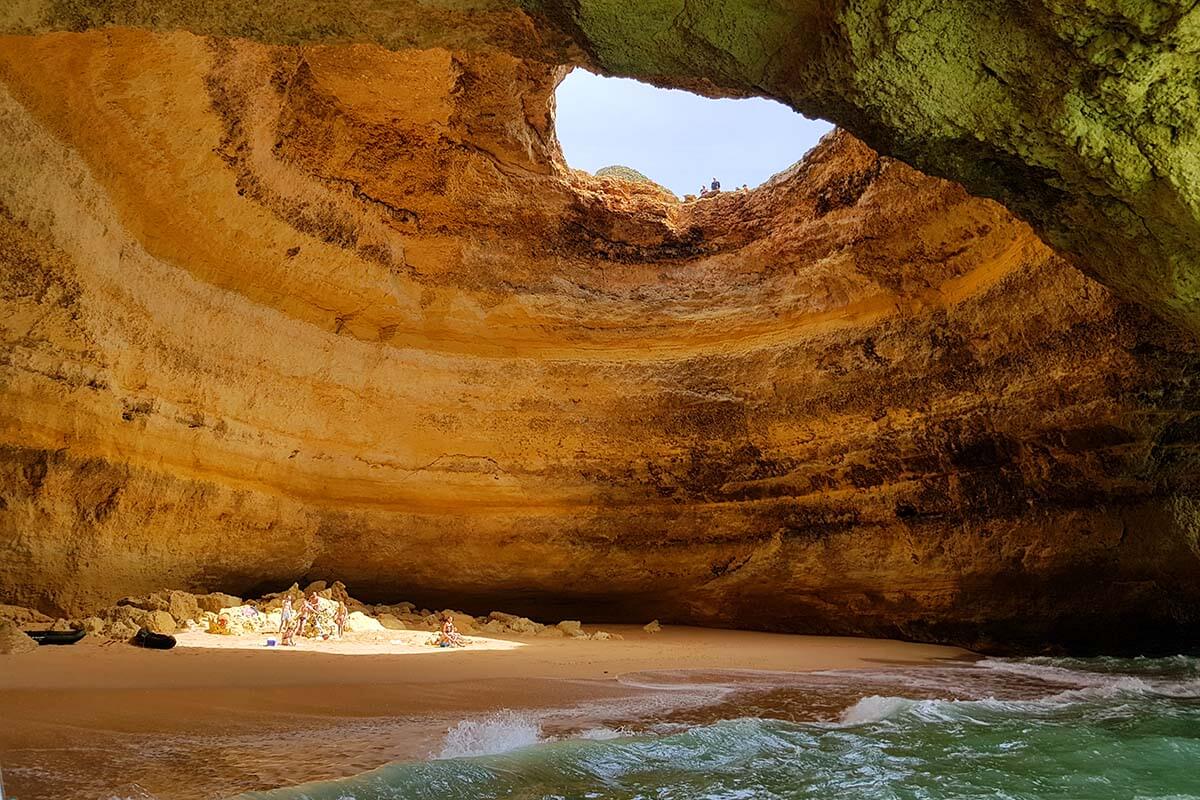
Easter in Algarve
Easter weekend is a public holiday in Portugal. Most shops are closed on Good Friday and on Easter Sunday. Some restaurants in Algarve were closed between Friday and Sunday during Holly Week as well.
However, the majority of restaurants remain open during Easter too, especially in the most popular tourist resorts such as Albufeira or Vilamoura. Portuguese don’t seem to celebrate Easter Monday and we found that all the businesses were open as usual that day.
There are also all kinds of events in Algarve around Easter. The most notable is probably the Holly Week celebration in Tavira. The festivities usually start with the Procession of Triumph on Palm Sunday and there are various processions and masses throughout the entire week. The celebrations usually end with a concert on Easter day.
Albufeira holds a Sea Fest on Friday and Saturday before Easter. There are all kinds of fun (and free) events during the day and concerts on the main square by the beach in the evenings. Expect big crowds here, especially for the concerts.
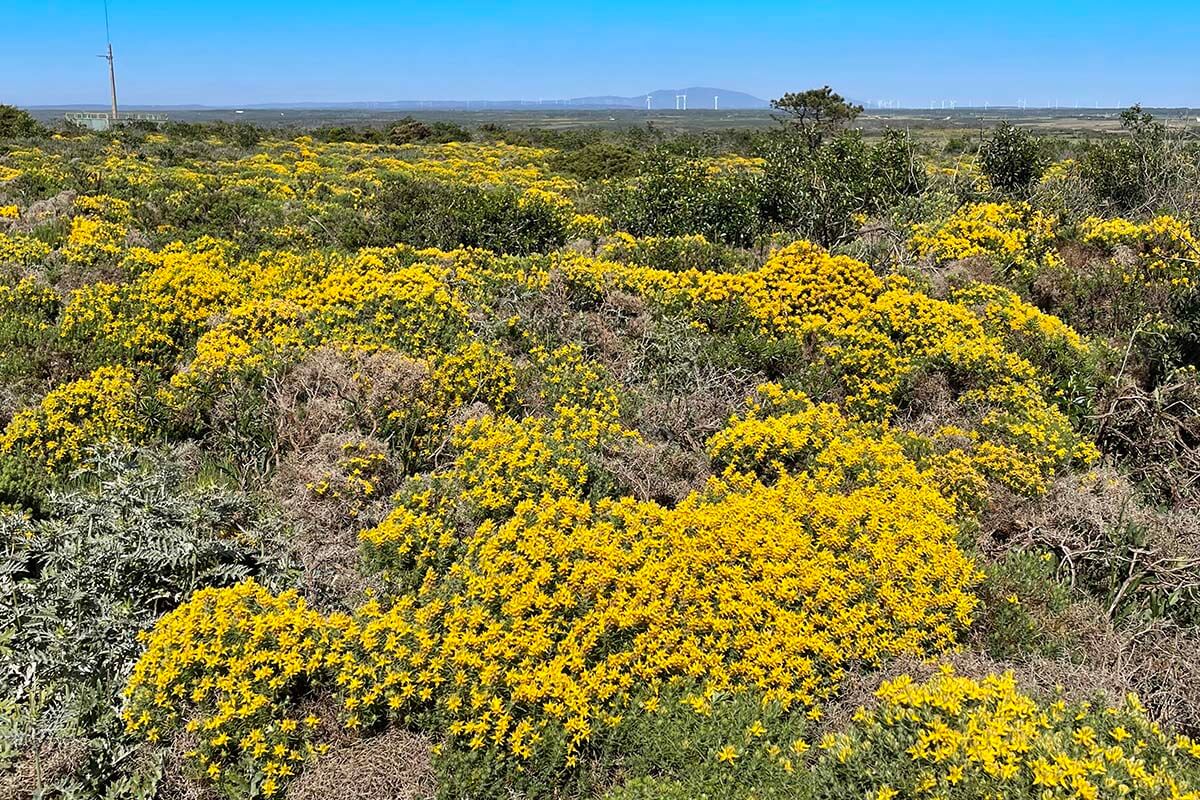
Advantages of visiting the Algarve in April
There are many advantages of traveling to Algarve in April. Here are some of the main ones:
- The weather is generally nice and warm and perfect for sightseeing. Plus, it’s often warm enough to enjoy the beach as well.
- It’s not nearly as busy as in the summer.
- Pretty much everything is open for the season already.
- There are spring flowers everywhere.
- Beautiful sunsets and sunrises (and you don’t have to get up very early or stay up late in order to see them).
- Accommodations are more affordable. You can stay at a really nice resort for a fraction of the summer prices.
READ ALSO: Best Places to Stay in Algarve

Disadvantages
Of course, there are some disadvantages to visiting in April as well. Here are some of the main ones:
- Warm temperatures aren’t guaranteed. If you are looking for a beach holiday and want to be absolutely sure that you can sunbathe and swim in the sea each day, then April is a bit too unpredictable for that.
- It may be a bit too cold for outdoor pools and waterparks.
- Migratory birds are usually gone by April. So if you want to see flamingos in Algarve, April is not the best time for that.
- Some restaurants or attractions have shorter opening times.
READ ALSO: Tips for Your First Visit to Algarve
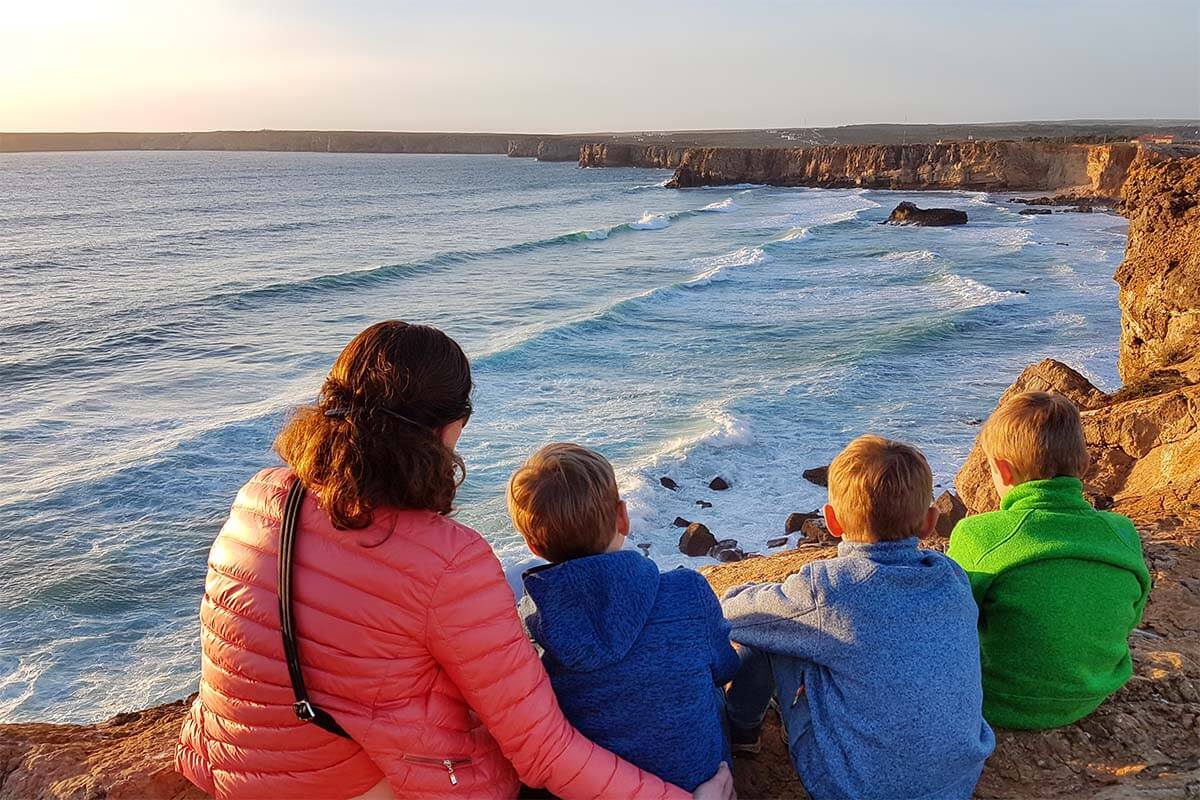
We go to the Algarve quite often, in all seasons, and I have to say that April is one of our favorite months.
It’s warm but not too hot and lively but not too busy. In my view, April offers the perfect combination for a perfect vacation with a mix of sightseeing, plenty of beach time and swimming, but also fun activities for the whole family.
If you don’t absolutely have to have guaranteed beach weather and sunshine every single day, then you really cannot go wrong with visiting Algarve in April.
More travel inspiration for the Algarve region:
- Best Things to Do in Algarve
- Best Beaches in Algarve
- Benagil Caves
- Ponta da Piedade
- Seven Hanging Valleys Hike
- Best Kayak Locations in Algarve (+ Kayak/SUP Tour Recommendations)
- Kayaking at Ponta Piedade
- Best Things to Do in Tavira
- Best Things to Do in Lagos
- Best Things to Do in Albufeira
- Best Beaches in Albufeira
- Where to Stay in Albufeira
- Algarve in November
READ ALSO: What It’s Like to Visit Portugal in April
If you found this post helpful, don’t forget to bookmark it and share it with your friends. Are you on Pinterest? Pin this image!
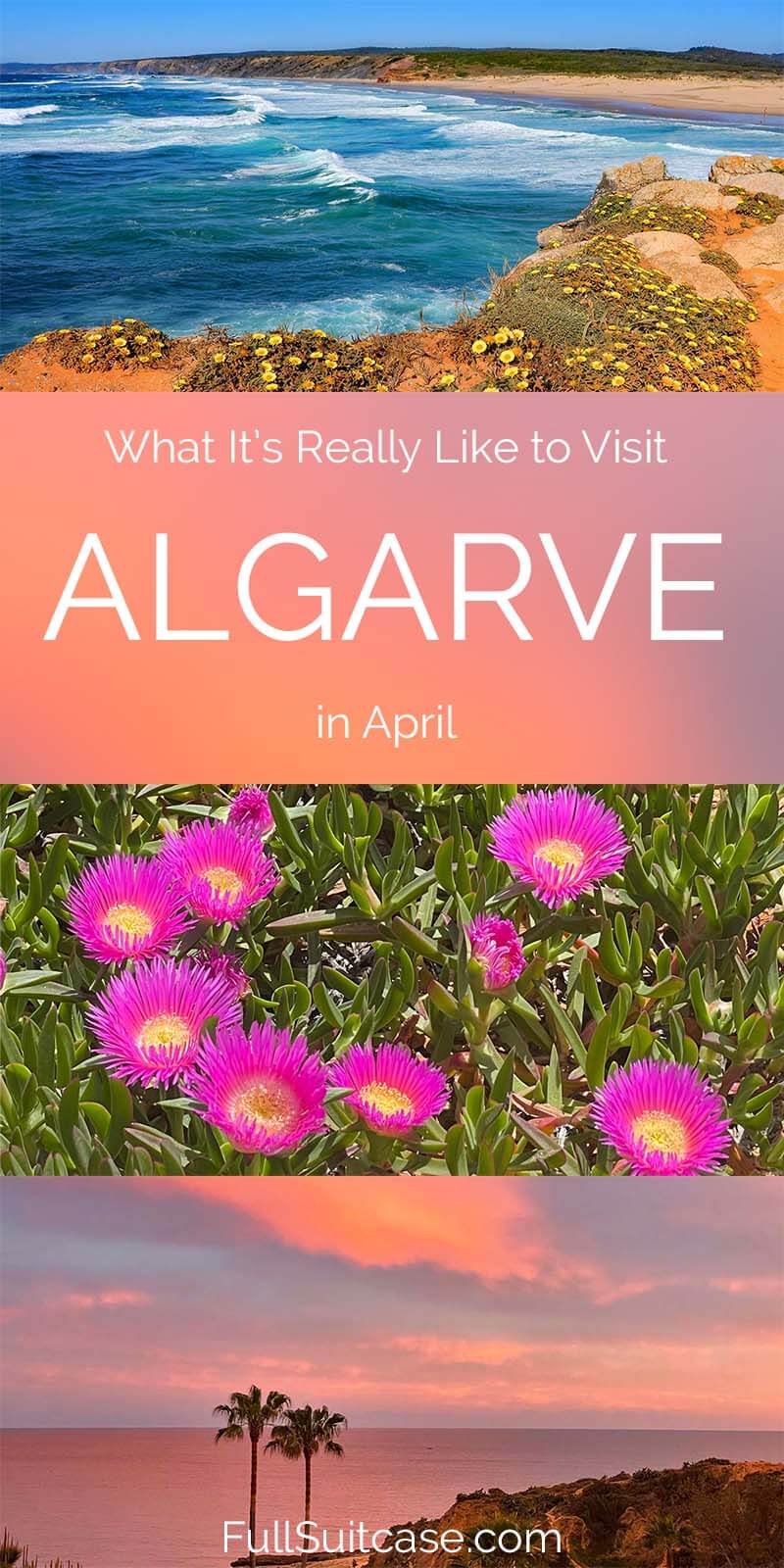
More inspiration and tips for your trip to Portugal:
- Best Things to Do in Lisbon
- Lisbon 1-Day Itinerary
- Best Day Trips from Lisbon
- Best Things to Do in Sintra
- Sintra Itinerary
- Best Towns in Portugal
- Things to Do in Nazaré
- Portugal with Kids
- Portugal Itinerary for 10 Days
This site uses Akismet to reduce spam. Learn how your comment data is processed .
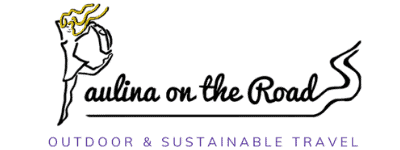
Algarve in April: 15 Fun Things To Do!
By Author Paulina
Posted on Published: March 22, 2024 - Last updated: March 26, 2024

Here’s a list of things to do in Algarve in April.
Have you ever wanted to escape to a secret paradise off-season, where you can soak up all the beauty yourself when the crowds have left?
Well, I’m here to tell you that the Algarve in April is where it’s at.
As the last remnants of winter fade into memory and spring burst into full bloom, this Southern Portugal transforms into a wonderland just waiting to be explored.
From breathtaking coastal hikes with scenic cliffside views to charming village squares filled with the scent of orange blossoms in the breeze.
Traveling Algarve in April offered unforgettable experiences at every turn during my most recent visit.
In this post, I’ll share my favorite things to do during this magical shoulder season, from secluded beaches to hidden grottos—all while protecting the land and sea.
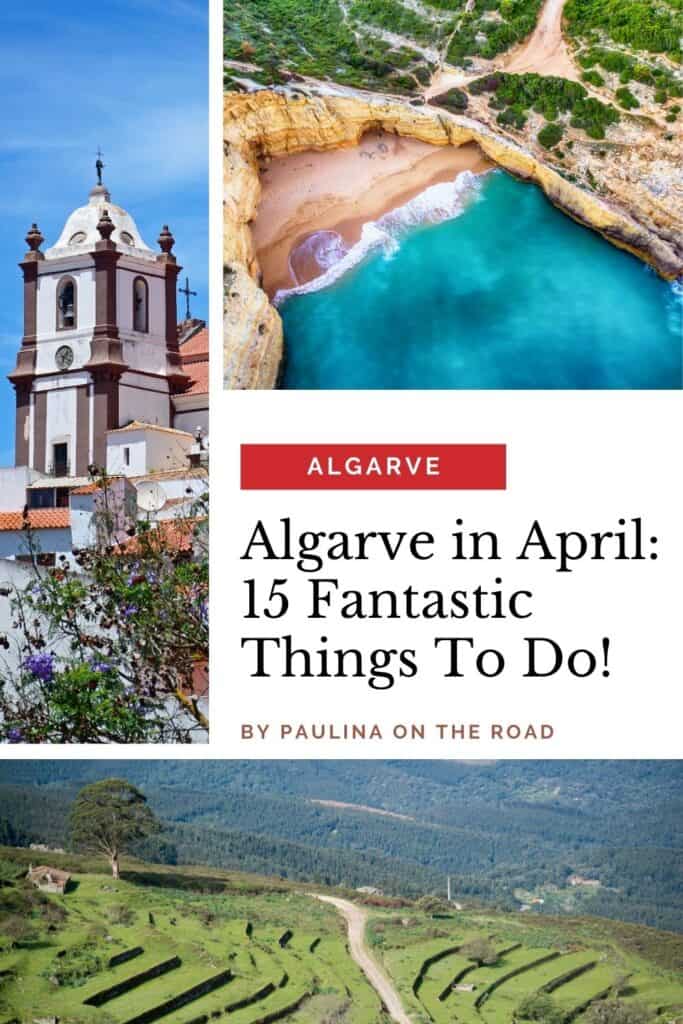
You, dear reader, support this blog. When you purchase through a link, I may earn a small commission. As an Amazon Affiliate, I earn from qualifying purchases.
Pssst…??!! You can’t get enough Algarve? Have a look at my other posts:
- Winter in Algarve
- Hiking in Algarve Trails
- Unique Places To Stay In Algarve
Love the Algarve? Click here to download your free bundle with a Fantastic Algarve Itinerary and Packing List! Don’t let them slip by!
Table of Contents
Overview: Things to do in Algarve in April
- Embark on a boat trip
- Go on a Food Tour
- Enjoy a Segway Tour
1. Springtime Charm
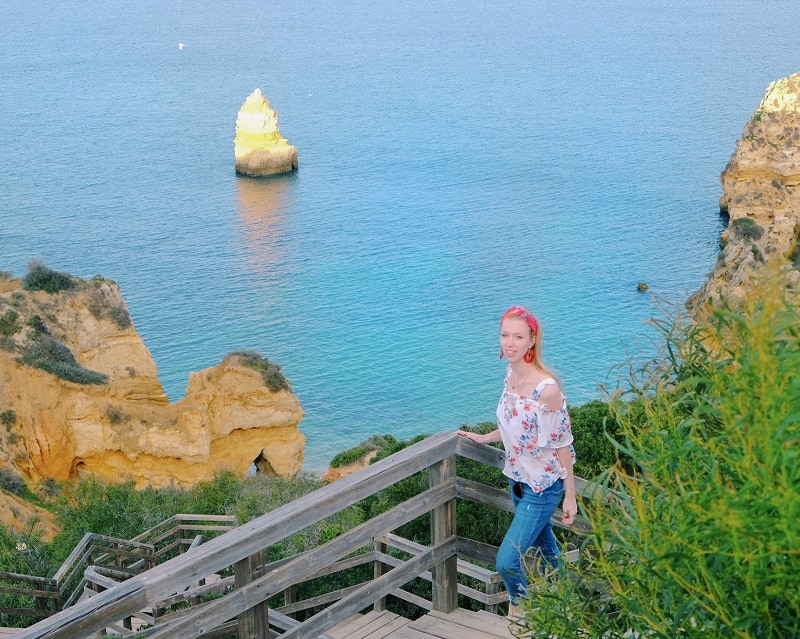
Now, you’re maybe curious: is Portugal hot in April? Nope, and Algarve would agree.
April weather in Algarve can be generally sunny but mild. However, compared to other regions of Portugal, it’s slightly warmer.
A place of countless beach resorts backed by impressive cliffs, the almost perfect weather has graced the Algarve’s landscapes as much.
Species of beautiful wildflowers in the meadows and fields are refreshing attractions in April. Tourists can find exotic places near most western coasts, like the Monchique mountains .
Algarve weather in April is also ideal for those who wish to see a wide variety of rare orchids.
It is not a common feature in the Algarve, but the scenic hills and countryside of the west coast, where rich vegetation such as citrus fruits and eucalyptus groves grow.
They are among the finest places in the Algarve.
Check Algarve Segway tours now .
2. Beach Escapades
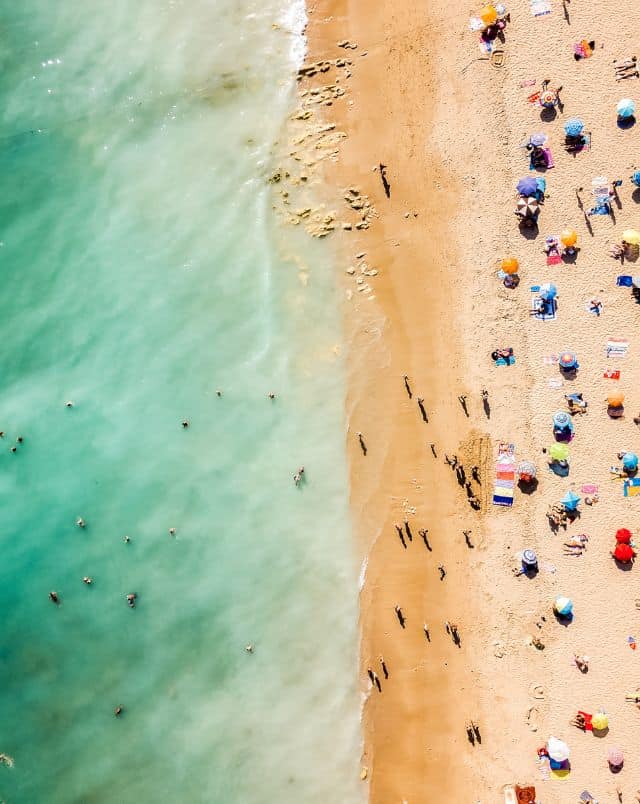
Algarve is home to the most beautiful beaches in Portugal. Praia da Marinha, with its pristine blue-green waters, was hailed as one of the top beaches in Europe.
Though the seawater in Algarve in April is still cold for a long dip, the golden and fine sands of the coastal resorts with nice warm weather can ease the pressures of a busy life.
With the water ordinarily calm and serene at the start of peak season, sunbathing and sunset on an Algarve beach are priceless.
If you’re up for a little fun, surfing, scuba diving, and hang gliding are just some of the water sports activities that town resorts offer.
Kayak rentals are also available to explore interesting coves and rock formations nearby.
Algarve in April is just ready for your ultimate beach experience!
Join Algarve boat trips here .

3. Explore Algarve’s culture
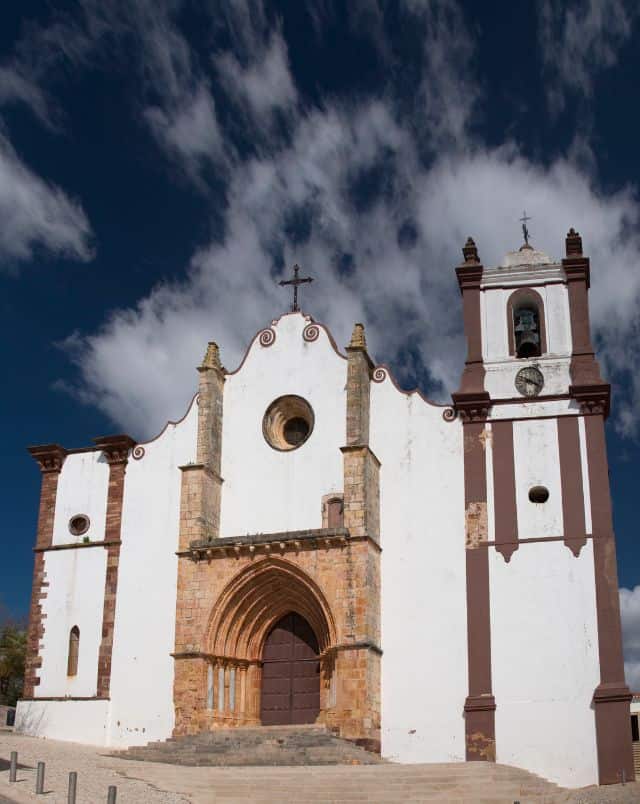
Portugal’s rich past is deeply engraved in many parts of the Algarve.
Spring is an excellent time to walk around Lagos and Tavira’s historic and picturesque towns.
A pro tip: Among your things to do in Lagos, Portugal , enjoy walking the narrow tiled streets and whitewashed houses to feel that traditional Mediterranean vibe.
You can also visit cultural treasures such as the medieval town walls, the Slave Trade Museum, and the 18th-century Church of San Antonio, a prominent landmark of Lagos.
Another historical attraction is the Moorish Castle, located in Silves– once the capital of the Arab Kingdom.
The Algarve has numerous art galleries, too, selling everything from paintings and sculptures to hand-crafted ceramics.
You can check out more of these from various art exhibits in Faro in April.
Stay in Lagos hotels .

Get you FREE Algarve Bundle!
Download your FREE Guide + FREE Packing List to prepare your Algarve vacation!
You have successfully joined our subscriber list.
Please check your inbox (and spam!) to get your freebie!
4. Culinary Delights
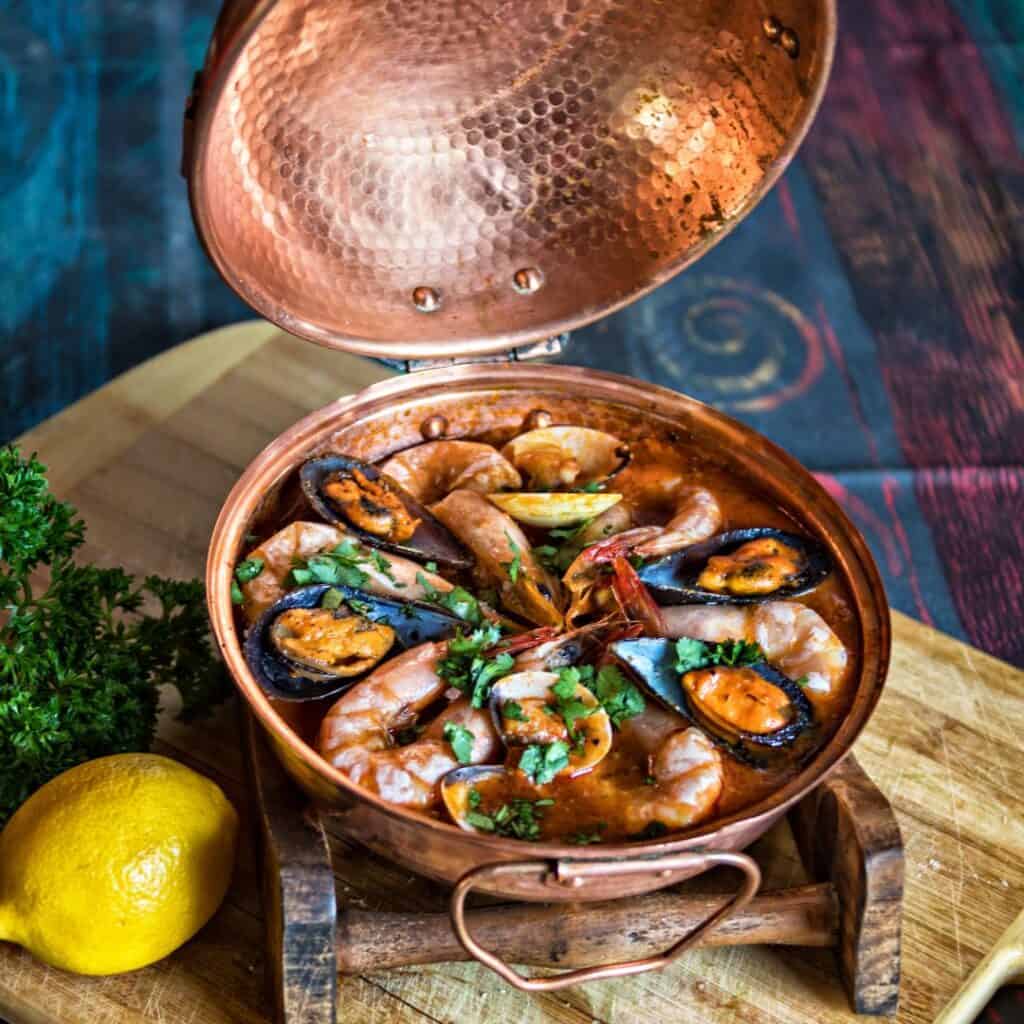
Tourists can savor Algarve’s cuisine, which has specialties in fish and seafood, from Michelin-starred restaurants to small traditional restaurants.
Popular dishes include Cataplana , a seafood stew served in a metal pot, and Caldeirada , a fish stew.
You can’t afford to miss Algarvian desserts!
They have the traditional codfish cakes, a sweet delicacy passed down through generations, and the favorite, pastel de nata or custard tarts .
Like other European countries, visiting local wineries in Portugal in April is a highlight.
The Algarve produces excellent white wines from its native grapes, Arinto and Siria.
Check out Algarve Food Tours .
5. Enjoy the outdoors!

Algarve is a paradise for active travelers.
Let’s start with everyone’s favorite: hiking the Algarve’s breathtaking cliffs, sea caves, and rock formations.
From your things to do in Carvoeiro , take advantage of hiking the Seven Hanging Valleys Trail.
Aside from the scenic views of the coastal region, there are hiking stops every few kilometers that will amaze you, like the famous Benagil Cave.
To go inside and witness the spectacular interior of Benagil Cave , you can take a kayak or a boat from nearby towns like Lagos and Portimao.
I’ll share a secret for the adventurers: the Ponta da Piedade boardwalk outside Lagos. This site has vantage points of stunning cliffs, caves, and other natural elements.
I must say this is one of the best places in the Algarve.
On the western seaboard, Algarve has everything for your outdoor enjoyment.
A 10-kilometer dirt road is waiting for those who want a drive adventure to some of the best viewpoints of the west Algarve.
This road is a part of the Rota Vicentina trail, which is also a popular hiking destination.
Regarding the Algarve’s outdoors, it’s adventure till you drop!
Join Benagil cave tours .

6. Festivals and Events

You’ll appreciate the Algarve’s vibrant culture through local events that you might only experience in the Algarve.
These are some of the festivals that you’ll love joining in Algarve in April:
- Fiesa – A beach exhibit of giant sandcastles, generally held between March and October.
- Festival Al-Buhera – It’s a festival that promotes local produce and one of the best things to do in Albufeira in April . Here, you’ll find a range of Algarvian food products, crafts, and locally-made alcohol.
- Liberation Day (25th April) is a historic and well-celebrated public holiday in the Algarve that commemorates the end of a dictatorship. It features fireworks displays and public performances.
The best places to stay and immerse yourself more in Portuguese culture are the smaller towns or the eastern side of the Algarve.
Larger towns sometimes organize beach parties, which are also excellent opportunities to mingle with the locals.
7. Nightlife in Algarve

Nightlife is even great in April as many restaurants and bars return after winter break.
Visitors who love street bar hopping and clubbing can head to cosmopolitan areas such as Albufeira and Portimao.
Algarve also offers gaming and dining venues around these areas, whereas known beach resorts are nearby.
But if you want a night of chill and drinks, there are cool live music bars in Lagos featuring Algarve’s local bands.
In Faro, rooftop bars overlooking the rich marina and charming after-dark views are great late-night options.
8. Family-Friendly Activities

There’s nothing happier than family trips, and visiting Portugal in April does sound like a plan.
Algarve offers guided kayaking trips where kids and the whole family can enjoy the best of Algarve’s marina.
Another highlight is the dolphin tour , where the main goal is to find dolphins frolicking in the waters.
Make this family activity a memorable part of your things to do in Albufeira .
Parque Aventura is also an excellent destination for families in the Algarve’s interior.
It’s a forest of challenging but child-friendly high rope courses for a different and unforgettable family bonding time.
Another inland must is the Krazy World Zoo. The exotic animal species will amaze the kids, and your little ones can enjoy the pony rides.
Check family activities in Algarve .
9. Go shopping

Travel won’t be complete without a little shopping, and the Algarve showcases a variety of shopping options, from flashy malls to local streets.
Some tourists prefer to shop at the elegant and quaint shopping malls around the major towns before roaming or leaving the Algarve.
Faro, the gateway city of Algarve, has the most modern and most extensive shopping center with designer brand boutiques, like the Forum Algarve.
While shopping malls are convenient, travelers are commonly fond of window shopping as they stroll around and go straight street shopping.
One interesting place I found was Rua Candido dos Reis in Lagos.
It has trendy boutiques for everyone and perfect souvenirs for friends and families, such as cork-made accessories and handmade crafts.
Some of the best souvenir ideas and Portuguese products are cork goods, soaps, leather, canned sardines, and ceramics.
10. Wellness and Relaxation

The beautiful and peaceful sunsets, perfect Algarve weather for April, and fresh sea breeze are enough to recharge your inner wellness.
But if you’re looking for a more pampering vacation, use a thermal spa (freshwater treatment), and thalassotherapy (salt water treatment).
They are widely popular natural therapies in The Monchique Thermal Spa.
Quiet wellness retreats, from smaller boutique hotels to country house accommodations, are relaxation treatments best experienced in a peaceful Algarve environment.
There’s also growing support for medical spas, such as Longevity Health and Wellness Centres, which are creating programs to rebalance the body and mind and prevent diseases.
Check Monchique stays .
11. Local Markets

The vibrant local markets of the Algarve feature fresh produce and seafood, a variety of local goods, and haggling.
Whether you’re a culinary master or trying hard to be one, checking out the Municipal markets is another exciting way to explore the Algarve.
In these indoor local markets, you can sample Algarve’s local goods and regional delicacies, such as cheeses and cured meats.
Local farmers typically run stalls selling fresh fruits, vegetables, seafood, and native-farmed meats.
Loulé Municipal Market is a popular municipal market over 100 years old and located in the heart of the Algarve.
Most towns, including Monchique on the west coast, have monthly markets.
This every-4th-of-Sunday market is unique because the sold items are mostly connected to Algarve’s culture and countryside.
The antique fair is an exciting and growing local market in Algarve. There’s one in the churchyard of the interior village of Boliqueime every 1st Sunday of the month.
12. Day Trips from Algarve
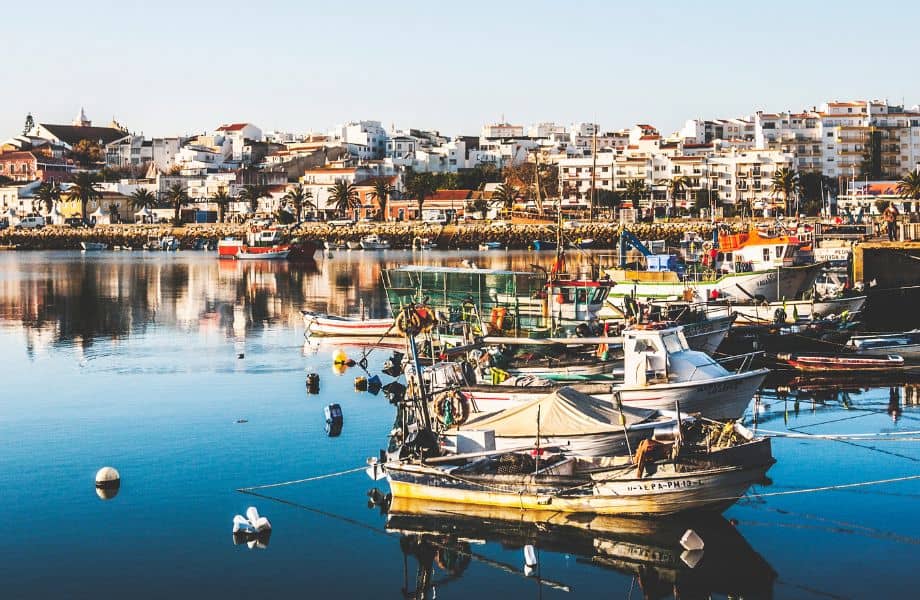
If you’re a busy traveler who wants to explore the Algarve for at least a day, numerous towns can still showcase the Algarve at its best.
You just have to know the kind of day trip you’ll enjoy.
But one thing is sure: there’s always a great beach to look forward to.
One of the most visited towns in the Algarve is Lagos. It has almost everything: stunning beaches and scenery, a historic old town, and the best accommodations.
The great news is you can experience them in a day.
If you’re on a romantic getaway or want to explore best places in Algarve , plan your things to do in Silves , Algarve day tour and visit Silves Castle. This red sandstone fortress stands magnificently.
Faro weather in April is also a great time to appreciate Algarve’s rich history, with cobbled streets and traditional Portuguese architecture.
A full-day trip is always a possible and available option in Algarve in April.
Check out Silves tours .
13. Photography Hotspots
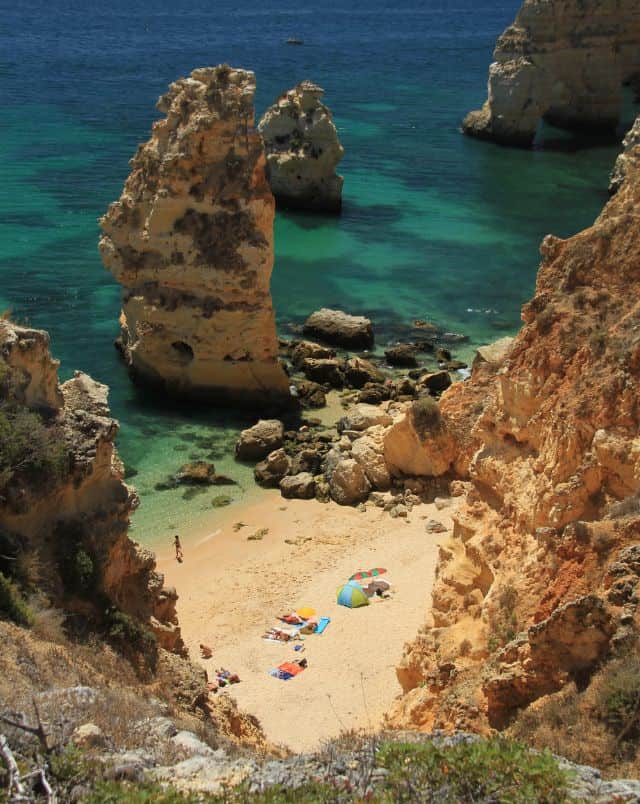
You’ll never run out of picture-perfect hot spots in Algarve.
Praia da Marinha has “The Heart of Algarve,” one of the most photographed rock formations.
The quaint plaza squares around towns, traditional houses in fishing villages, fields of Algarvian flora, and fresh local market produce are some subjects you’ll enjoy photographing in the Algarve.
Among the most photographed and IG-friendly sites are Tavira’s charming cobblestoned streets, Alvar Seco’s “ A Boneca ,” and The Benagil Cave.
Join a Benagil cave tours .

14. Golfing in Algarve

Algarve has been voted the best golfing destination by magazines, not just once.
About 40 golf courses are in the region; most offer training programs and practice areas for those who want to play and learn golf.
Dom Pedro ( Pinhal ) in Quarteira, Central Algarve, has a well-maintained, lovely ground lined with umbrella pines, a stream, and several small ponds.
Vilamoura, a sophisticated town, is known for its four luxurious golf courses.
If you’re a golf enthusiast or a beginner who’d like to play golf in such a pleasant environment, add this to your list of things to do in Vilamoura .
Check out Vilamoura tours now .
15. Local Entertainment

Local entertainment adds color and fun to a region.
Carnival, music and food festivals, and historical re-enactments are the traditional forms of entertainment in Algarve.
Cultural dances such as Spanish and Arabian night performances with wine tasting are another highly recommended addition to your things to do in Portimao .
For a fun-filled holiday, many visitors enjoy the latest musical trends from the discotheques, casinos, bars, and restaurants, with outdoor seating and an easy atmosphere vibe.
My final thoughts on Algarve in April

My list of things to do in Algarve left me with profound travel memories. Still, there’s a lot to discover, just like their history.
You’ll have the most of your trip in Algarve’s beautiful coastlines, and the fantastic views will make your outdoor adventures incomparable.
You can also check out where to stay in Algarve when you visit.
The vibrant spring matches their lush surroundings, while their food, music, and festivals express value for their own identity.
Whether you’re traveling alone or with loved ones, hotels and resorts offer well-planned activities to ensure your safety and a great time.
Knowing your destination well is an ingredient to a satisfying vacation. See your travel options and plan accordingly. Then, leave the rest to the Algarve in April!

Hola! I’m Paulina, a seasoned travelette who crossed the Atlantic Ocean by Boat HitchHiking. On my blog, find expert insights for an extraordinary holiday through outdoor and sustainable travel like hiking, cycling, and sailing. Let’s embark on unforgettable journeys together! 🌍🚀
14 things Portugal locals want you to know before you visit

Feb 25, 2024 • 7 min read

Learn how to act like a local in Portugal by following these key tips © AnnaTamila / Shutterstock
Many years ago, as a young backpacker, I made plenty of mistakes when traveling around Portugal – from trying to see everything on one trip to indulging in free appetizers that weren’t really free.
Since becoming both an honorary Lisboeta (Lisbon resident) and Tripeiro (Porto dweller), I have learned some essentials about the country. From the best methods for getting around to wardrobe essentials. Here are the key tips to help you make the most out of your trip to Portugal.
Don’t try to see it all in one trip
Portugal is a small country – roughly the size of the state of Indiana in North America and slightly larger than Scotland. But there’s a lot to see here , from hilltop villages in the Alentejo to remote UNESCO World Heritage sites , not to mention over 100 beaches in the Algarve. A rookie mistake is trying to see all of Portugal during one visit. Even if you have a few weeks to spare, you won’t be able to visit everything in this diverse country. Instead, pick one or two regions and focus your trip there, allowing yourself time to see both highlights as well as local markets, vineyards and other less-visited attractions.

Decide where to go
The mountains, the seaside, cobblestone-lined city streets? Portugal has plenty of options when it comes to travel. With a week at your disposal, you can combine a bit of urban adventure with scenic getaways nearby. If you have Lisbon in mind, you can spend several days there, along with day trips to Cascais , Sintra and the beach-dotted Setúbal Peninsula , or spend a couple of days in Évora or on the lovely Alentejo coastline.
A great northern itinerary combines Porto with some vineyard visits along the picturesque Douro River . Beach lovers might skip city life altogether and spend their time in the Algarve , checking out cliff-backed beaches, hidden coves and quiet fishing villages. If you have something more active in mind, plan a hiking outing in the mountains of the Serra da Estrela , which you can pair with time spent exploring craggy villages like Manteigas and Linhares, as well as the university town of Coimbra .
Book your accommodation well in advance
Portugal’s growing popularity means some of the best places to stay get booked up months in advance. This is especially true if you’re traveling in the peak months of June through August . Once you have your itinerary organized, reserve your lodging. If you’re traveling off-season (November through March), you’ll have much more flexibility – so you can book your first few nights and plan your other nights on the go.
Lower your carbon footprint by traveling on trains and buses
You can go green by ditching the car and getting around by public transportation. Portugal has a decent train network that connects major cities like Lisbon, Porto, Coimbra and Faro. Buses help fill in the gaps to smaller towns across the country. Service has expanded in recent years, particularly in the south, where the new Vamus Algarve covers just about every part of the Algarve, from tiny beach villages on the central coast to the soaring sea cliffs near Sagres . Skipping the car rental also means you won't have to hassle with parking, toll roads and heavy traffic, among other things.

Don’t bother taking a taxi from the airport
Speaking of trains and buses, as soon as you arrive, you can save money and cut down on CO2 emissions by hopping on public transport from the airport. Portugal’s three international airports all have good options for whisking you into town. The Lisbon metro’s linha vermelha (red line) can get you into the center, as can the speedy Aerobus, while Porto’s metro (violet line E) runs from the airport to the heart of town. From Faro airport in the south, you can take the Vamus Algarve Aerobus, which shuttles into Faro and also to the key towns of Albufeira , Lagoa, Portimão and Lagos .
Remember the cardinal rule of dining in Portugal: nothing is free
Servers often bring bread, butter, olives and even cheese or other appetizers to diners before their meal. Keep in mind that these unordered items will always be added to your bill if you choose to partake. If you don’t want them, just send them away – a polite "no thank you" ( não obrigado/a ) will do the job. Prices for couvert range from €2 per person and upwards.
Bring a few smart-casual outfits
Shorts are fine on the beach, but if you wear them around the city, you’ll quickly brand yourself as a tourist. At nicer restaurants, bars and nightclubs, you’ll want to follow the local lead and dress things up a bit.

Become an expert on tipping etiquette
At restaurants in Portugal, many locals don’t tip at all or simply round up when paying for a meal. In more tourist-oriented establishments, a tip is more common – usually around 10% – and may even be added as a service charge. Tipping is not expected in cafes or bars. However, if you’re in a fancy high-end place, you should plan on tipping (along the lines of €1 for a specialty cocktail). Rounding up the fare is also common practice when taking a taxi or rideshare.
Bring your own bag to the market
Portugal has huge markets where you can see stalls of fresh fruits and vegetables as well as charcuterie, cheeses, olives, bakery items and other fare. Amid such culinary largesse, you can assemble a first-rate picnic, just be sure to bring your own bag to the market. You might want to throw in a corkscrew so you’re always prepared to pop open a bottle of vinho verde , an Alentejo red and other good-value Portuguese wines.

Pack sturdy shoes
Even if you limit your travels to the city, you’ll want to have good shoes. You’ll find steep streets, loose cobblestones and uneven sidewalks in Lisbon, Porto, Coimbra and many other towns. Save the heels and dress shoes for nicer restaurants and nightclubs. Good shoes will also come in handy when you want to take a walk beyond the town. Across the country, Portugal has some magnificent hikes , like the stunning clifftop trail of Percurso dos Sete Vales Suspensos – not difficult to do, but you need proper footwear.
Dress modestly when visiting churches
Save the shorts, short skirts and tank tops for the beach – keep things covered up when visiting the cathedrals ( Sés ) and monasteries of Portugal.
And don’t forget to throw in the swimsuit
No matter where you roam in Portugal, you’re never far from the beach or a sparkling inland lake or river. Porto and Lisbon both have lovely beaches within easy reach of the city center, while remote corners of Portugal – like Peneda-Gerês National Park have waterfalls and natural pools. It would be a mistake not to bring your swimsuit, even if you think you won’t need it.
Learn some Portuguese and use it
Outside of Lisbon, Porto and the Algarve, you might encounter people with limited English. For smooth sailing, it helps to learn some Portuguese. If nothing else, locals appreciate the effort to speak their language, however rudimentary your accent. When entering a room, it’s polite to say " bom dia " (good day) or " boa tarde " (good afternoon) to those around you.
Be mindful of petty crime
Portugal is generally a safe country to visit with a low overall crime rate – violent crime is extremely rare. Pickpocketing and bag-snatching are the main concerns to keep in mind, especially when traveling on the trams and metro in Lisbon or Porto. Avoid moving around during the crowded peak times, and don’t zone out on your phone. At night, be cautious walking around empty streets wherever you are: you’re better off taking a taxi.
Car break-ins can also happen, and rental vehicles are sometimes targeted. Don’t leave anything of value in your car, and it's best not to leave luggage or other items in the trunk/boot of your vehicle (yet another good reason to embrace public transportation).
This article was first published Aug 9, 2022 and updated Feb 25, 2024.
Explore related stories
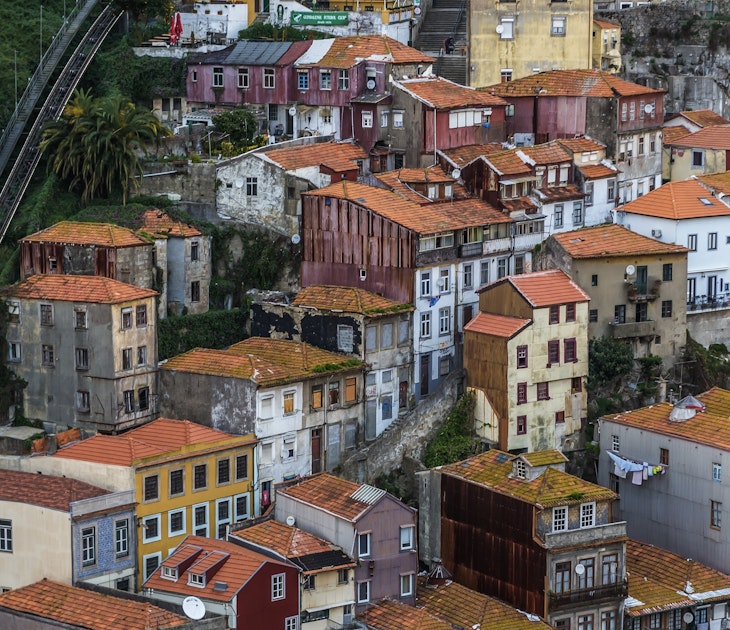
Destination Practicalities
Jun 19, 2024 • 6 min read
Porto’s history, hills and hipster allure always fascinate. Here are a few things to know before you arrive in this sensational city.

Jun 14, 2024 • 4 min read

Jun 12, 2024 • 12 min read

May 27, 2024 • 6 min read

Apr 15, 2024 • 10 min read

Apr 4, 2024 • 4 min read

Mar 25, 2024 • 6 min read

Mar 3, 2024 • 6 min read

Mar 2, 2024 • 7 min read

Feb 28, 2024 • 9 min read

- North Region
- Viana do Castelo
- Douro Region
- Central Region
- Serra da Estrela
- Castelo Branco
- Lisbon Region
- Castelo de Vide
- Vila do Bispo
- Vila Real de Sto. A.
- Arch. of Madeira
- Porto Santo
- Means of Transport
- Natural Parks
- Theme Parks
- Zoos and Aquariums
- Nightlife Spots
- Centro Region
- Estoril Coast
- Castro Marim
- Vila Real de Sto A.
- All-inclusive Trips
- Portugal with Children
- Weekend in Portugal
- Weekend in Lisbon
- Weekend in Porto
- Organize your tour
- Porto Airport
- Lisbon Airport
- Faro Airport
- V.R de Sto. Antonio

Portugal Travel
Organization of Portuguese agencies

- Customized tours
- Archipelago of Madeira
- Prepare your holidays
- Accommodation
- What to See
- Zoos & Aquariums
- Privacy and Policy
Portugal in April
Think about travelling to portugal in april ask for an estimate now and we’ll organize your stay.
Journey through Portugal in April and let us take care of making your journey complete just by filling out this form. Thanks to our Portuguese agency, experts in personalized trips, you’ll get the best option that fits perfectly with all your preferences, so that you can simply forget about the worries that come with organizing a vacation yourself. Don’t waste any more time thinking about it!
Request your Budget Now:
Data about your trip:
Are you travelling with children?
Have you decided the dates of your journey?
Would you like to book your flights?
Yes: No: Departure airport or city:
Would you like to book your accommodation?
Which accommodation category do you prefer? Apartments 3 or 4 star hotels Luxury hotels All-inclusive hotels
Would you like to contract any of these services?
Private transfers Car rental Tourist guide
Budget: € per person (Not including the flights)
Tell us more about your trip:
Personal and contact data:
Email:
Phone number:
Country of residence: Afganistán Albania Alemania Andorra Angola Anguilla Antártida Antigua y Barbuda Antillas Holandesas Arabia Saudí Argelia Argentina Armenia Aruba Australia Austria Azerbaiyán Bahamas Bahrein Bangladesh Barbados Bélgica Belice Benin Bermudas Bielorrusia Birmania Bolivia Bosnia y Herzegovina Botswana Brasil Brunei Bulgaria Burkina Faso Burundi Bután Cabo Verde Camboya Camerún Canadá Chad Chile China Chipre Ciudad del Vaticano (Santa Sede) Colombia Comores Congo Congo, República Democrática del Corea Corea del Norte Costa de Marfíl Costa Rica Croacia (Hrvatska) Cuba Dinamarca Djibouti Dominica Ecuador Egipto El Salvador Emiratos Árabes Unidos Eritrea Eslovenia España Estados Unidos Estonia Etiopía Fiji Filipinas Finlandia Francia Gabón Gambia Georgia Ghana Gibraltar Granada Grecia Groenlandia Guadalupe Guam Guatemala Guayana Guayana Francesa Guinea Guinea Ecuatorial Guinea-Bissau Haití Honduras Hungría India Indonesia Irak Irán Irlanda Isla Bouvet Isla de Christmas Islandia Islas Caimán Islas Cook Islas de Cocos o Keeling Islas Faroe Islas Heard y McDonald Islas Malvinas Islas Marianas del Norte Islas Marshall Islas menores de Estados Unidos Islas Palau Islas Salomón Islas Svalbard y Jan Mayen Islas Tokelau Islas Turks y Caicos Islas Vírgenes (EEUU) Islas Vírgenes (Reino Unido) Islas Wallis y Futuna Israel Italia Jamaica Japón Jordania Kazajistán Kenia Kirguizistán Kiribati Kuwait Laos Lesotho Letonia Líbano Liberia Libia Liechtenstein Lituania Luxemburgo Macedonia, Ex-República Yugoslava de Madagascar Malasia Malawi Maldivas Malí Malta Marruecos Martinica Mauricio Mauritania Mayotte México Micronesia Moldavia Mónaco Mongolia Montserrat Mozambique Namibia Nauru Nepal Nicaragua Níger Nigeria Niue Norfolk Noruega Nueva Caledonia Nueva Zelanda Omán Países Bajos Panamá Papúa Nueva Guinea Paquistán Paraguay Perú Pitcairn Polinesia Francesa Polonia Portugal Puerto Rico Qatar Reino Unido República Centroafricana República Checa República de Sudáfrica República Dominicana República Eslovaca Reunión Ruanda Rumania Rusia Sahara Occidental Saint Kitts y Nevis Samoa Samoa Americana San Marino San Vicente y Granadinas Santa Helena Santa Lucía Santo Tomé y Príncipe Senegal Seychelles Sierra Leona Singapur Siria Somalia Sri Lanka St Pierre y Miquelon Suazilandia Sudán Suecia Suiza Surinam Tailandia Taiwán Tanzania Tayikistán Territorios franceses del Sur Timor Oriental Togo Tonga Trinidad y Tobago Túnez Turkmenistán Turquía Tuvalu Ucrania Uganda Uruguay Uzbekistán Vanuatu Venezuela Vietnam Yemen Yugoslavia Zambia Zimbabue
I agree with the Privacy Policy and the data processing
Enjoying an escape to Portugal in April is your chance to explore the country in one of the country’s most beautiful seasons, as it coincides with the beginning of Spring when the temperatures become milder. What’s more, the landscape exhibits its most exuberant colors at this time, so you’ll have unforgettable memories of places like the Peneda-Gerês National Park, where you’ll be able to enjoy an infinity of activities involving ecotourism, as well as Braganza’s Montesinho Nature Park . In addition, wandering through Lisbon , Porto or any other historical towns such as Évora will be a real delight for the senses. A date you must note down as the last week of April , as the Feria de Agricultura y Ganadería Ovibeja (Ovibeja Agriculture and Livestock Festival), celebrated in Beja , takes place; a great time to see concerts, find artisanal items and to try Alentejo’s typical dishes.
Even more, it runs parallel to Easter Week , so you won’t be able to escape delving deep into Portuguese culture in places such as Braga , when processions march through the streets, a unique sight.
Don’t wait any longer, tell us all you want to do during your trip and we’ll be the ones who take care of organizing every detail of your stay.
Why should you trust in our agency?
Apart from being a Portuguese agency with years of experience in organizing trips, we offer: - Expert local guides in your language. - Secure payment through bank transfer, credit card, Paypal and in cash. - Insurance included for all excursions.
Why "Portugal Travel"?
Portugal Travel is an organization of Portuguese agencies whose objectives are:
- ✓ To make Portugal , its culture and its heritage known .
- ✓ To promote sustainable tourism .
In collaboration with:
Escola Superior de Hotelaria e Turismo do Estoril
Turismo de Portugal
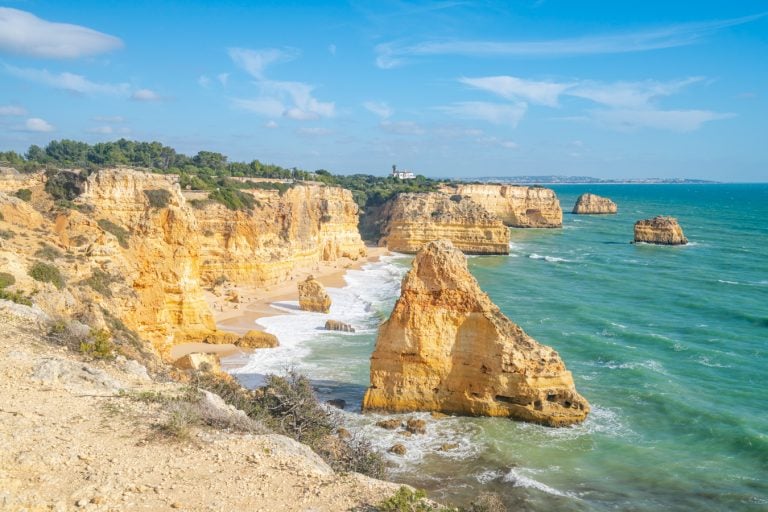
The Perfect 10 Days in Portugal Itinerary (+ Travel Tips!)
Colorful, vibrant, diverse, delicious, and surprising: after working your way through this 10 days in Portugal itinerary, those are just a few adjectives that you may find yourself trying–and failing–to sum up this gorgeous country with.
Despite its small size and somewhat isolated position in the far southwestern corner of Europe, the sheer variety of things to do and see on a trip to Portugal is astounding.
And–thanks to the aforementioned small size–you can sample a decent portion of the best places to visit in Portugal in 10 days.
We’ve now been living in Portugal as American ex-pats for about a year, and with every beach town, historic monastery, cozy restaurant, and quirky museum visited, we find something else that we love about traveling in Portugal.
And, thanks to having family and friends come to visit, we’ve had the opportunity to test-drive much of this suggested itinerary for Portugal on our various loved ones, too.
If you are planning your first trip to (mainland) Portugal and are hoping to see as much as possible, we have you covered!
Here’s how to enjoy an incredible 10 days in Portugal.
Table of Contents
How We Structured This 10 Day Portugal Itinerary
Getting around during your 10 days in portugal, the ultimate 10 days in portugal itinerary, other portugal destinations to add to your itinerary, tips for making the most of portugal in 10 days, the best time of year to visit portugal, what to pack for your trip to portugal.

Some links in this post may be affiliate links. If you make a purchase through one of these links, we may earn a small commission at no extra cost to you. Please see our disclosure policy for more detail.
We’ve intentionally structured this Portugal itinerary as a loop beginning and ending in Lisbon.
In addition to the capital city, we’ll cover stops in Sintra , Porto , the Douro Valley, and the Algarve.
While a quick glance at a map is enough to tell you that starting and ending your trip in Lisbon isn’t the most geographically sensible thing to do, it’s what most visitors end up doing simply because Lisbon has–by far–the biggest international airport in Portugal.
If you happen to get a good flight deal, starting your trip in Porto and ending in Faro (home to the Algarve’s international airport) is another option.
However, unless you’re flying to and from another destination in Europe, it’s unlikely to make sense for your vacation.
While there are plenty of modifications you can make to this itinerary (and we’ll cover many of them below), this Portugal itinerary as written goes like this:
- Day 1 : Arrive in Lisbon.
- Day 2 : Lisbon
- Day 3 : Sintra
- Day 4 : Take the train to Porto.
- Day 5 : Porto
- Day 6 : The Douro Valley
- Day 7 : Travel to the Algarve.
- Day 8 : The Algarve
- Day 9 : The Algarve
- Day 10 : Travel back to Lisbon and head home.
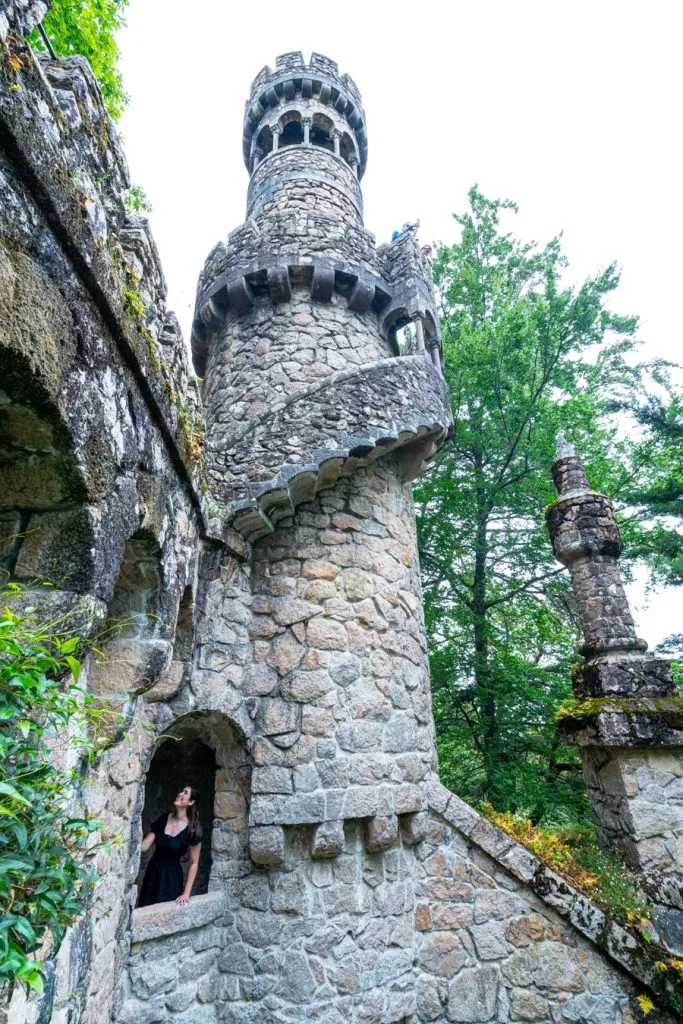
This itinerary for Portugal is best accomplished with a mix of transportation.
Within Lisbon and Porto, traveling on foot, via public transportation, and via taxi are sufficient.
To travel from Lisbon to Porto, we recommend taking the train, and we break down the details of that process in this Lisbon to Porto travel guide .
For train tickets, we recommend checking prices and timetables via Omio .

In the Algarve, your life will be much easier with a rental car, though–with some modifications–you can get by without one in a pinch.
We recommend searching for your rental car through Discover Cars , which will allow you to sift through all your options and choose the right car for you based on price, the reputation of the company that is renting it, and the terms of the rental contract.
The trickiest travel day on this route is between Porto and the Algarve, when, depending on your travel style, you may prefer to fly, take the train, or drive, and we’ll go into more detail on that below.
Shop rental cars and train tickets for your trip to Portugal today!

Day 1: Arrive in Lisbon and start exploring the city.
If you’re traveling to Portugal from North America, odds are very high that you’ll arrive early in the morning, exhausted, jet-lagged… and excited to see the city.
Head into the city by cab or metro (cab is the fastest and most comfortable), drop your luggage off at your hotel and enjoy your first round of pasteis de nata over coffee.
From there, it’s time to explore the city–starting with one of its highest points.
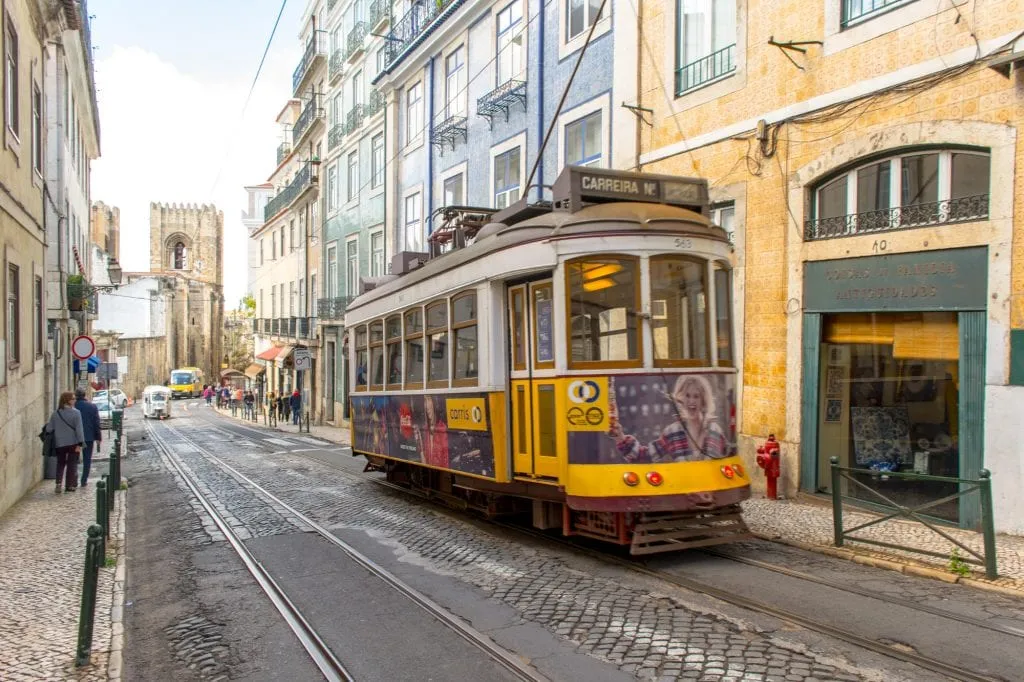
Morning: Alfama + Castelo de São Jorge
For your first morning in Lisbon, start by heading to the city’s very highest point: the remains of Castelo de São Jorge , which boasts one of the most stunning views of Lisbon.
Keep in mind that not much is left of Castelo de São Jorge–there are walls, ramparts, views, history, and peacocks.
Even so, it’s consistently ranked one of the best things to do in Lisbon, including by most of our visitors (and the lines get ridiculous, so nab skip-the-line tickets online before you go).
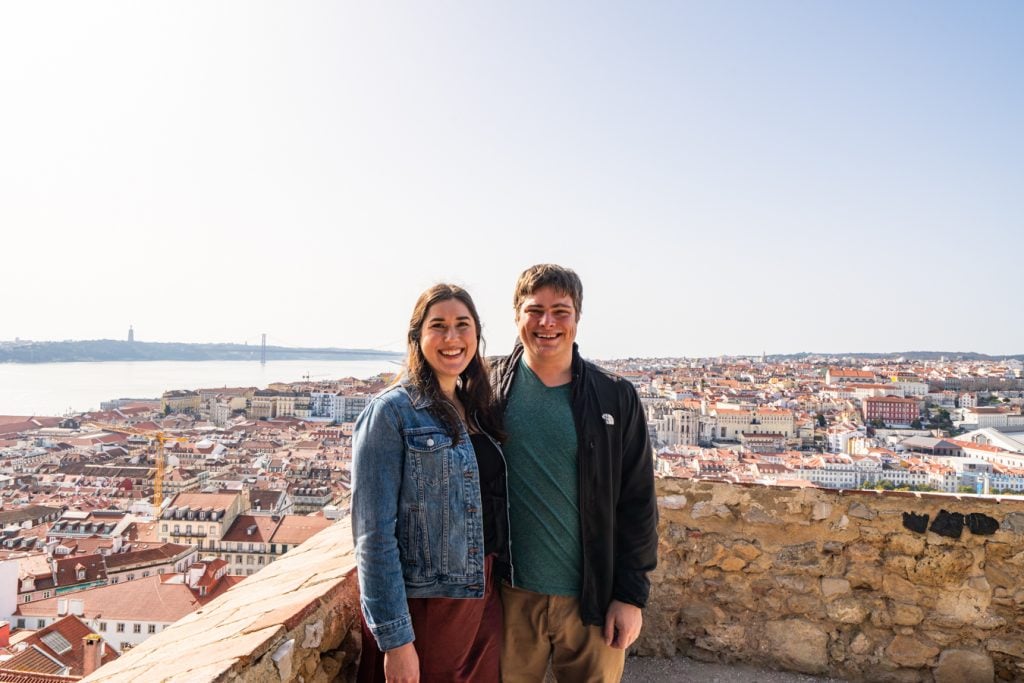
From there, head downhill to explore Alfama, Lisbon’s oldest neighborhood and one of the only parts of the city that wasn’t destroyed in the infamous 1755 earthquake.
Here, you’ll see many Lisbon postcards come to life, including the views from the Miradouro das Portas do Sol and the Miradouro de Santa Luzia, the famous Tram 28 (though we don’t recommend riding it–just snap photos from outside) and the Lisbon Cathedral.
Wander your way through the tiny streets of Alfama, vaguely making your way toward the Praça do Comércio.
Book skip-the-line tickets to visit Castelo de São Jorge today!
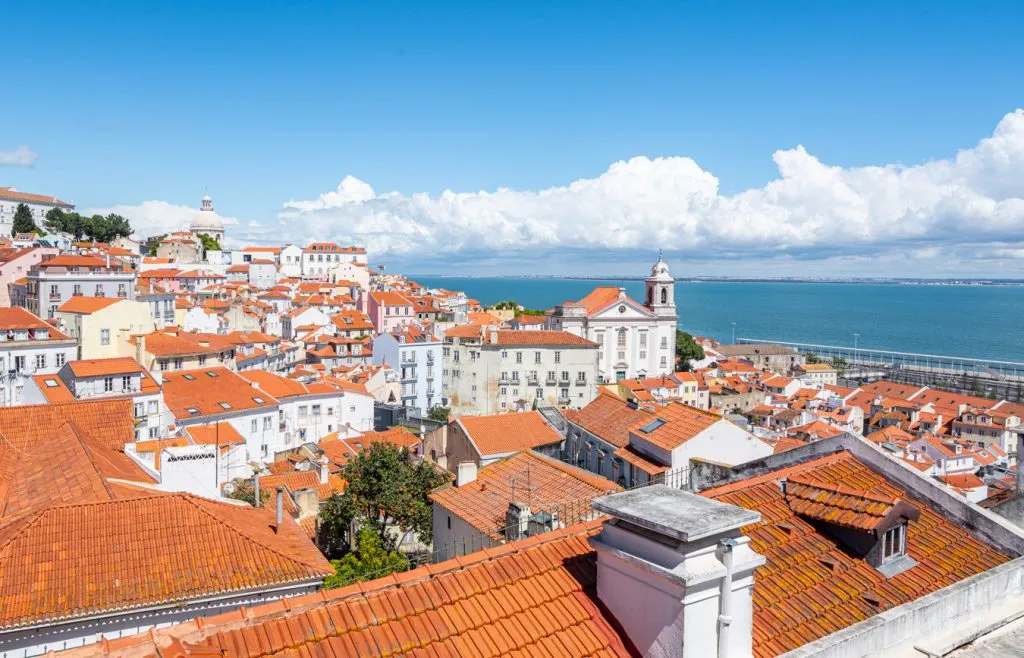
Afternoon: Baixa + A Food Tour
When you find yourself at the Praça do Comércio, you’re in Baixa, the heart of Lisbon’s downtown that was reimagined and rebuilt after the 1755 earthquake.
You’ll no doubt be able to feel the difference in architecture as compared to more medieval Alfama!
Enjoy the square and accompanying views of the river, and then head inland, through the beautiful Arco da Rua Augusta and up through Lisbon’s shopping district.
Make your way past Rossio Square, and check out the Church of São Domingos.
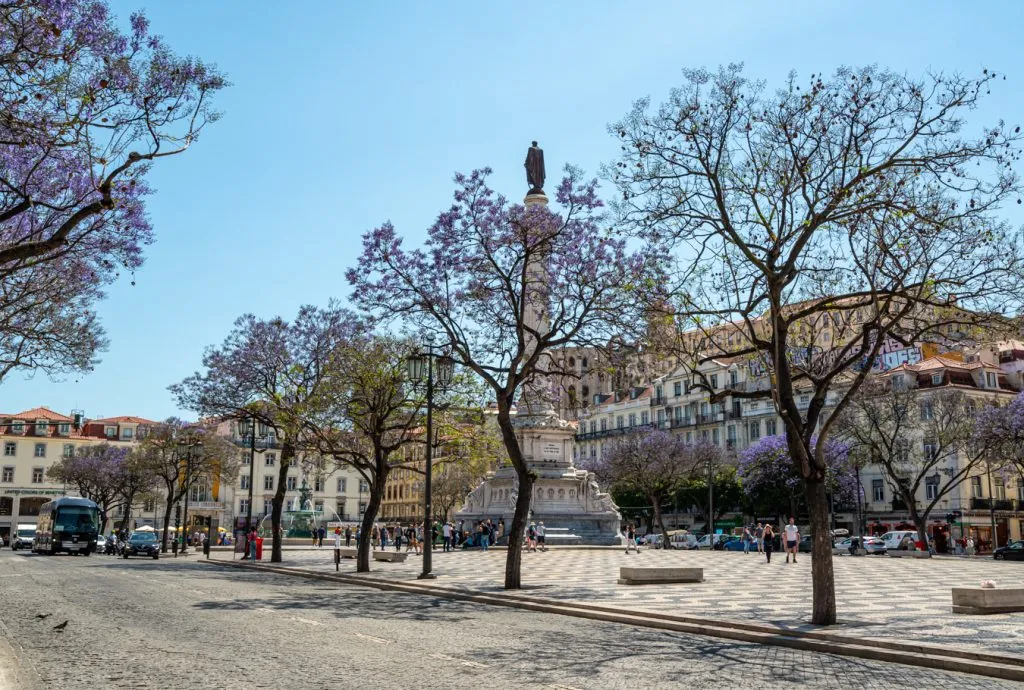
At this point, you may be completely burned out with jetlag–but hopefully not.
If you can rally, we highly recommend signing up for this food tour , which we loved and is one of a few that we have taken in Lisbon.
We had a great time on the tour and found it to be a great quick introduction to Portuguese cuisine.
In other words, it’s the perfect activity for the beginning of your first trip to Portugal (and it will save you from having to figure out where to eat dinner your first day, too).
Sign up for your Lisbon food tour today!

Where to Stay in Lisbon
We recommend basing yourself in Lisbon for your first 3 nights in Portugal.
While there are plenty of excellent neighborhoods to stay in throughout Lisbon, we recommend picking somewhere central with good transportation connections around the city.
Alfama, Baixa, Chiado, Principe Real, and Barrio Alto are great names to keep an eye out for when browsing places to stay.
For a budget-friendly hostel experience (with private rooms available), the Sunset Destination Hostel is a great, centrally located option.
At a mid-range price tag, you can’t beat the location or rave reviews for Tempo FLH Hotels Lisboa .
Looking for a splurge?
The Lumiares Hotel & Spa is part of the much-acclaimed Small Luxury Hotels of the World Collection, and offers stunning views that you won’t forget anytime soon!
Check rates & book your stay in Lisbon today!
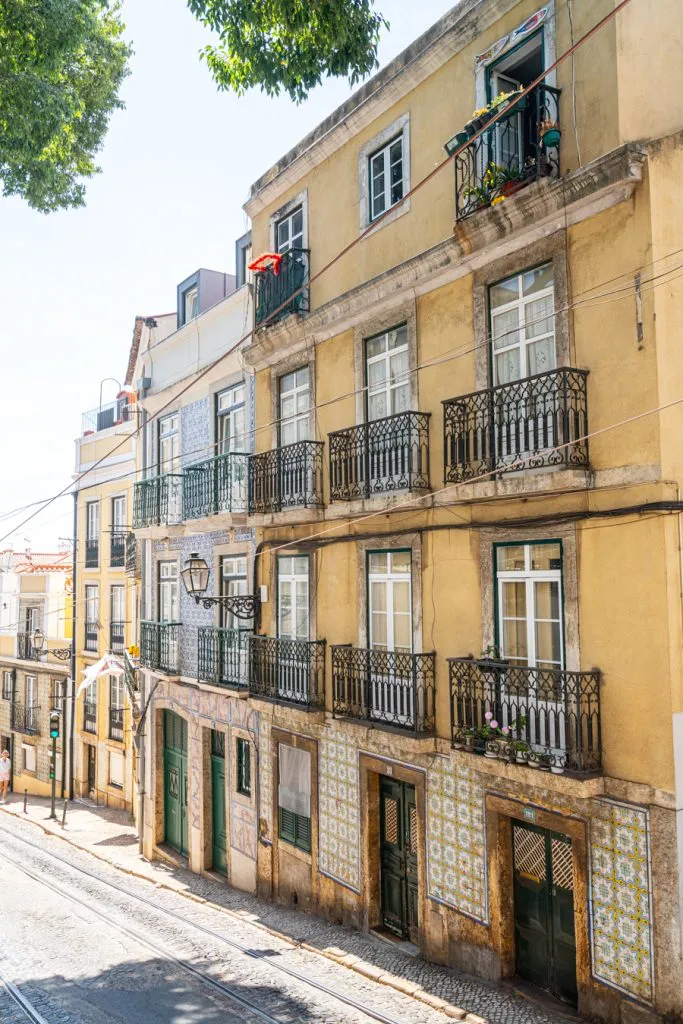
Day 2: Enjoy more of Lisbon’s highlights.
The second day of your Portugal itinerary is all about continuing to get to know Lisbon, covering a mix of the capital’s top attractions and cultural delights.
Morning: Bairro Alto + Chiado
Start your morning in Lisbon’s Bairro Alto (high town) and Chiado, exploring a corner of the historic center that you didn’t get to see yesterday!
Highlights include the Miradouro de São Pedro de Alcantara, the overwhelming Church of São Roque, the Carmo Convent, and a stop at Livraria Bertrand , the oldest still-operating bookstore in the world.
If you’re a fan of glitzy cafes, consider also grabbing a coffee and pastry at A Brasileira .
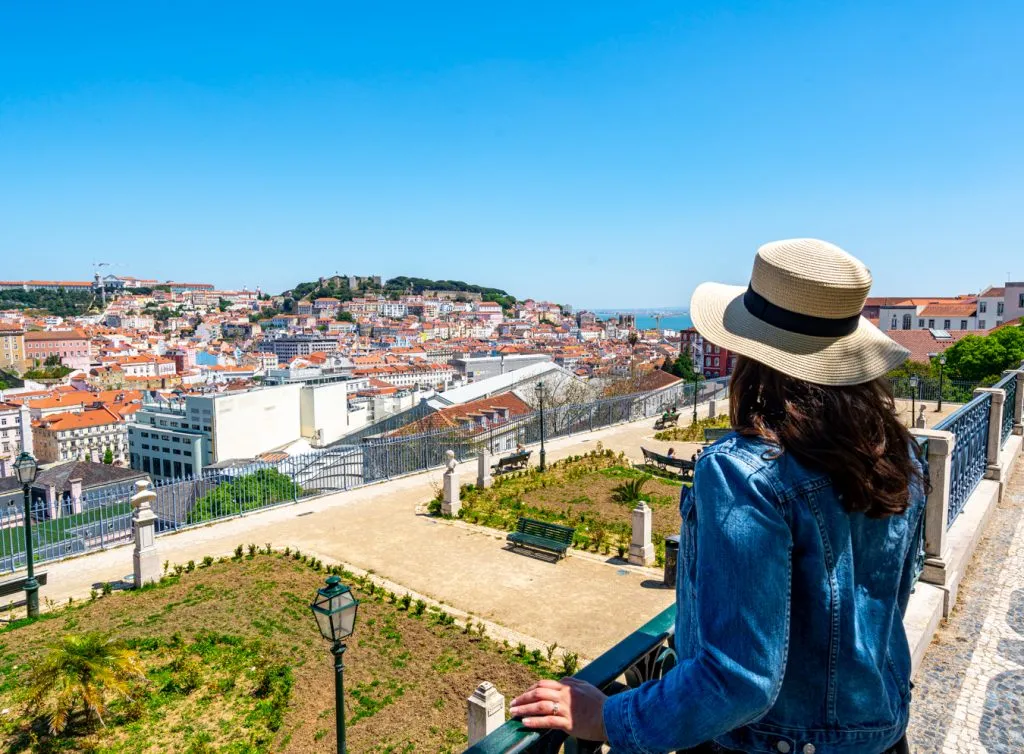
Afternoon: Belém + The Jerónimos Monastery
Next up on your Portugal itinerary, head down to the popular riverside neighborhood of Belém .
Here, you’ll find the famous Jerónimos Monastery and accompanying church (the church is free to enter, the monastery is not), the gorgeous Belém Tower (you don’t need to go in, but it’s worth seeing the exterior), the Monument of the Discoveries, and stunning views of the Tagus River.
You’ll also find the wildly popular Pastéis de Belém, which serves up the original pastéis de nata.

Yes, they are worth the long line (hint: the table service line is often much shorter than the takeaway line!), but if standing in line for carbs isn’t your thing, Manteigaria , another popular Lisbon bakery, has a location just down the street.
Meanwhile, the Jerónimos Monastery, while a must-see, is home to some of the longest lines for any tourist attraction in Portugal! Pre-book your ticket and, since you’re visiting Belém in the afternoon, consider going close to closing time (we took the photos of the monastery that are included in this post on a September afternoon close to closing time).
Grab your Jerónimos Monastery tickets today!
If you’re a speedy sightseer, you might even be able to squeeze in an extra offbeat museum (we love the National Coach Museum) or viewpoint while visiting Belém– here’s our guide to the neighborhood .
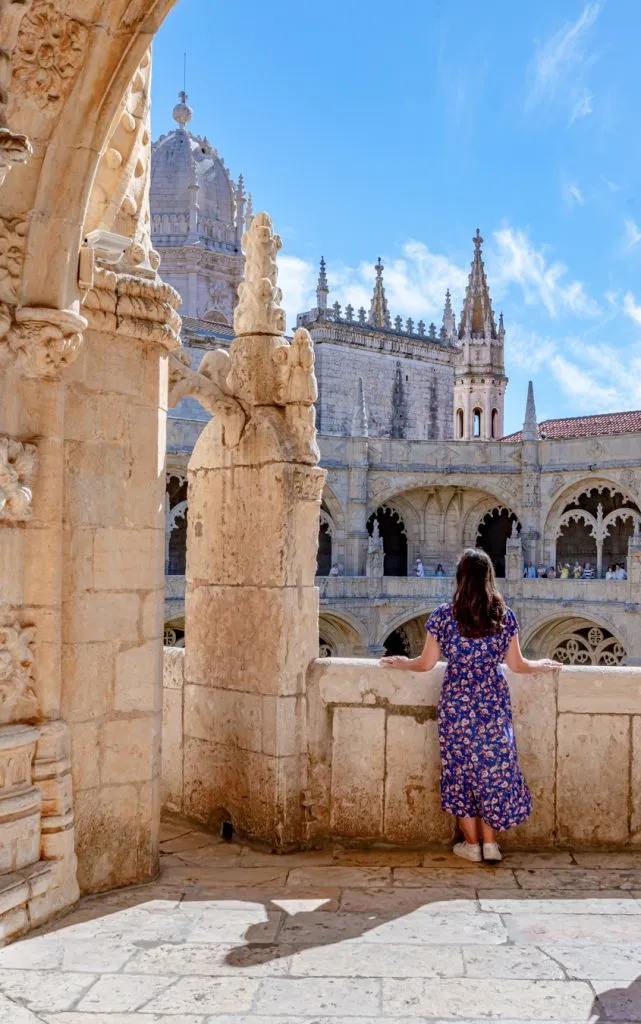
Evening: Sunset Boat Tour or Fado Show
In the evening, close out your day with a sunset boat cruise on the Tagus River, soaking in some of the best views of Lisbon, the Tagus, and the Ponte 25 Abril Bridge from the water.
We absolutely loved our sunset cruise experience in Lisbon and highly recommend it–kicking back and relaxing with beautiful views is the perfect way to end a busy sightseeing day.
Not into cruises? Alternatively, you could opt to attend a Fado show instead, to experience a different side of Portuguese culture.
If you prefer to enjoy a Fado show, we recommend reversing this day’s itinerary, starting with Jerónimos Monastery as soon as it opens and then ending your day in Chiado.
Book your sunset boat cruise or Fado show today!
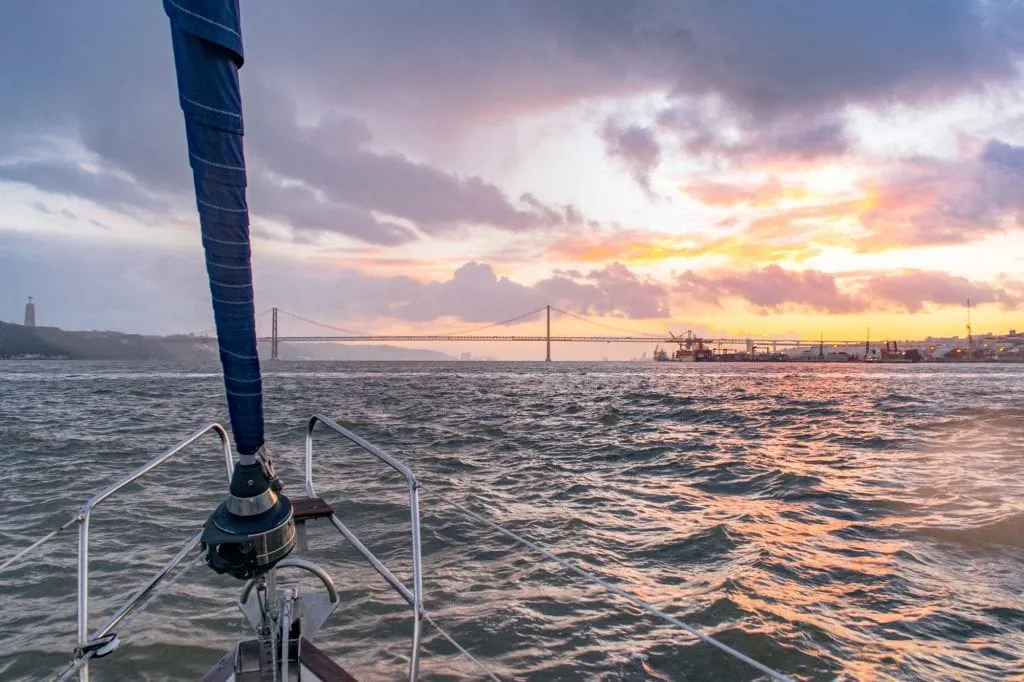
Day 3: Take a day trip to Sintra (and beyond).
Set in the hills just outside of Lisbon, the beautiful town of Sintra–complete with several fantastic palaces–is easily among the most popular places to visit in Portugal.
From the beauty of the distinctive yellow-and-red Pena Palace to the quirky Alice in Wonderland vibes of Quinta da Regaleira to the stunning views from the Moorish Castle and beyond, visiting Sintra is incredibly memorable and worth the effort.
… But, its popularity also has another side effect: the palaces of Sintra are among the most crowded places included on this travel itinerary, so be prepared for that.
With 10 days in Portugal, you’ll want to visit Sintra on a day trip from Lisbon, and that essentially leaves you 2 options: travel by public transportation, or on a guided day trip like this .
This day trip is one of the most popular tours in Portugal and includes visits to Pena Palace and Quinta da Regaleira as well as Cabo da Roca (long believed to be the westernmost point of mainland Europe, now simply a stunning viewpoint), and a short stop in the resort town of Cascais .
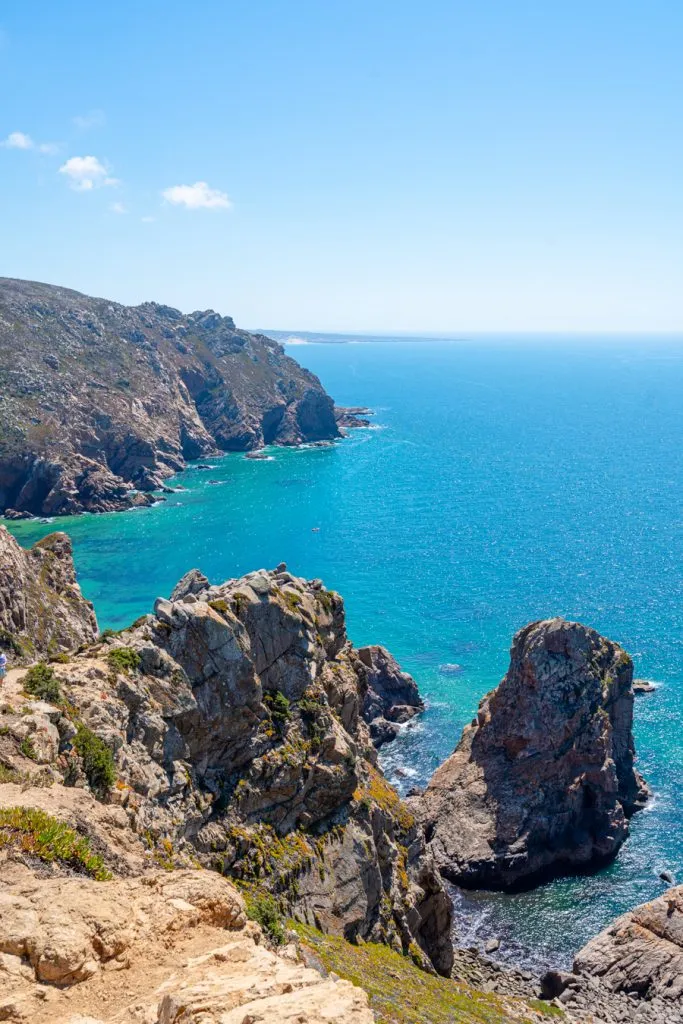
The pros of taking a tour are simple: as the palaces in Sintra are far enough apart that you can’t walk between most of them and parking is very tricky, it saves you time and allows you to see more.
The cons are simple too: with so many stops to make, you won’t have much time to linger.
If you’d rather travel independently, you can absolutely do that as well, though we recommend nabbing your tickets for Pena Palace and other popular places in advance.
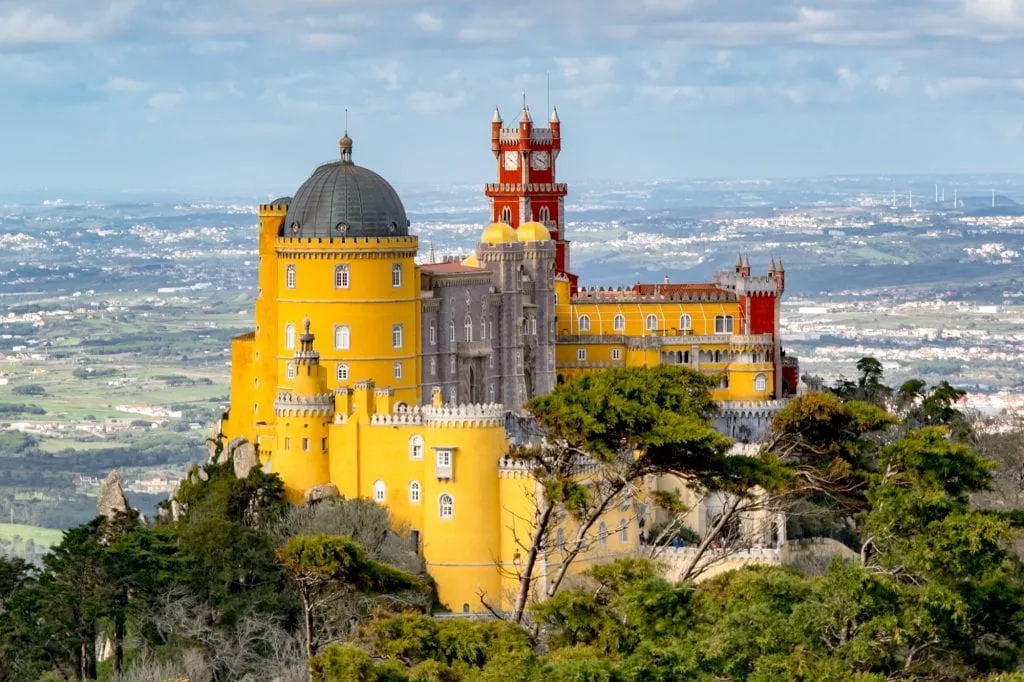
The train takes about 40 minutes from central Lisbon.
Once you arrive in Sintra, you’ll board one of 2 buses that will take you to your first palace, and then (depending on which palaces you choose to see) another to your second and maybe third, depending on how fast you explore.
When you’re finished, you can head back to Lisbon via train or simply call an Uber (we tend to do this).
Book your Sintra day trip today!
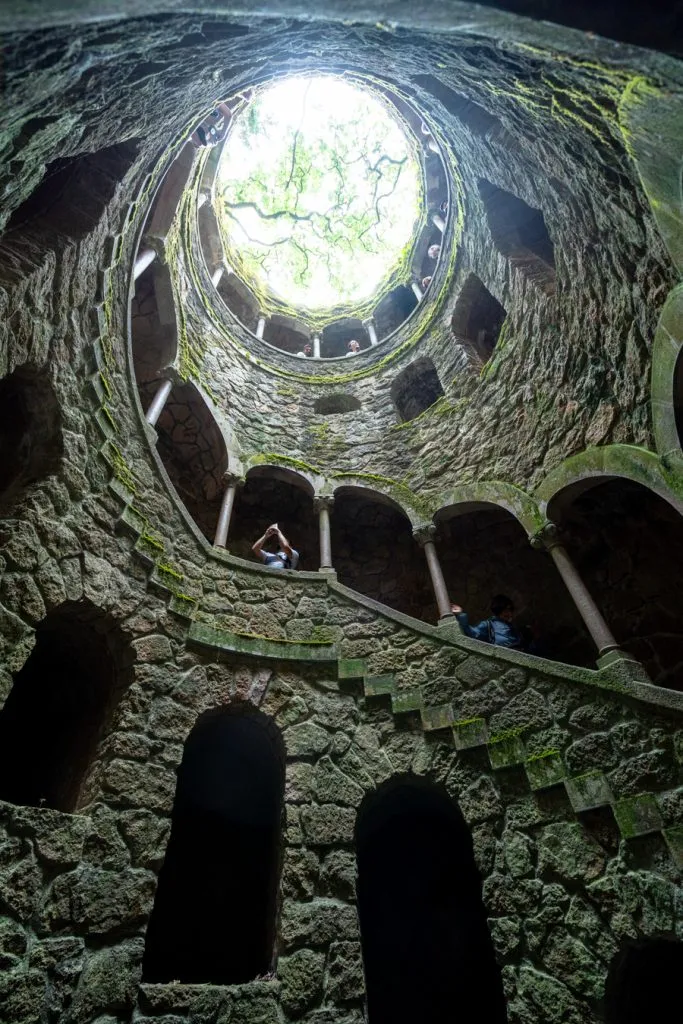
Alternative Day Trip: Obidos + the UNESCO Monasteries
Not into touring palaces (and fighting crowds to do so) or admiring views of the sea?
I can’t say I entirely understand, but I do have an excellent alternative for travelers more interested in small towns and historic architecture: instead of heading to Sintra and the coast, head to Óbidos and (some of) the nearby UNESCO monasteries of Alcobaça, Batalha, and Tomar.
I’ll describe these destinations in a bit more detail in the “other destinations” sections below, but if 700-year-old monasteries and medieval castle walls you can climb on for free sound like your idea of a good time, you’ll love them.
For this day trip, you’ll want to either rent a car for the day or sign up for an organized day trip like this to handle the transportation and logistics.
Honestly, these are some of my favorite places in Portugal, so it pains me not to include them in the full itinerary–and they’re certainly worthy of a day of your time.
Book your UNESCO monasteries + Obidos day trip today!
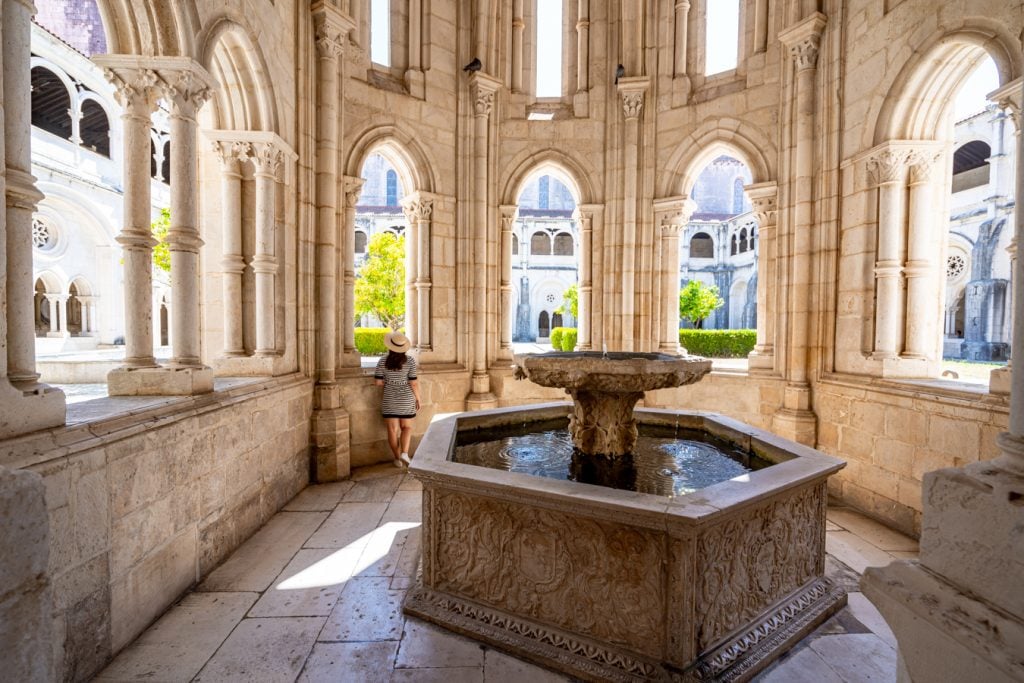
Day 4: Head north to Porto.
This morning, it’s time to check out your hotel and head north to Porto!
Morning: Train to Porto
The easiest way to travel from Lisbon to Porto during your 10 days in Portugal is to take the train, which travels directly between the 2 cities and takes about 3.5 hours.
Most trains leave from Lisbon’s Santa Apolonia Station and run consistently throughout the day.
We go into more detail on managing the journey between the 2 cities in this blog post .
We recommend booking your train tickets for the earliest time you feel comfortable with–the sooner you get to Porto, the better!
Shop train tickets from Lisbon to Porto today!

Afternoon/Evening: Porto’s Historic Center
Once you arrive in Porto, drop your bags off at your hotel (if it’s not time for check-in yet, they should be able to hold them in the lobby for you) and get ready to explore!
If you’re looking for a quick lunch, the roast pork and soft cheese sandwich at Casa Guedes is a great place to start.
From there, we recommend checking out some of Porto’s attractions that are further from the river, such as the Chapel of Souls, the Church of Saint Ildefonso, and Rua Santa Catarina.
If you have time, head over to the Church of Carmo, as and soak up the view from Miradouro da Vitória.
And, of course, you can’t forget the very first attraction you’ll see as you arrive in Porto: the interior of the São Bento train station is magnificent!

Where to Stay in Porto
We’ve visited Porto several times now, and have made a habit of staying at Pestana Porto – A Brasileira or NH Hotel Porto Batalha during our visits.
Both hotels are beautiful, with excellent customer service and incredibly central locations that both make it easy to explore Porto on foot and easy to check in when arriving by train.
(They both also welcome Ranger, a must for us).
If you’re traveling Portugal on a budget, the Zero Box Lodge Porto gets excellent reviews.
We recommend spending 3 nights in Porto during your Portugal vacation.
Check rates & book your stay in Porto today!

Day 5: Explore Porto in-depth.
While day 4 of this itinerary involved traveling from Lisbon and day 6 will include a day trip, day 5 is all about diving deep into the city of Porto.
Morning: More of Porto’s Historic Center
After a leisurely brunch (we can heartily recommend Floresta Cafe and Esquires Coffee, both of which we’ve eaten at many times), make your way to Clerigos Tower to enjoy one of the most stunning views of Porto!
From there, check out the Porto Cathedral–while the church is free to enter, it’s well worth forking over a few Euro to explore the cloisters and attached museum, too.
Meander down toward the gorgeous Bolsa Palace (if you want to go inside, you’ll need to book a 30-minute guided tour ) and the Church of San Francisco, which is home to a downright stunning interior!

Afternoon/Evening: Ribeira + Vila Nova de Gaia
When you wrap up with the Porto attractions above, you’ll be very close to the Ribeira district: Porto’s colorful, vibrant riverside.
Once the haunt of fishermen and sailors, and now the haunt of tourists, the Ribeira district is a beautiful place to relax and enjoy views of Porto.
Like many picturesque neighborhoods around the world, the restaurants here tend to be expensive and mediocre, but you can find occasional gems (we enjoyed our meal at Grupo Desportivo Infante D. Henrique, which has a great view but is a bit out of the hustle and bustle).
From Ribeira, make your way across the (lower level of the) Dom Luis I Bridge, to Vila Nova de Gaia.
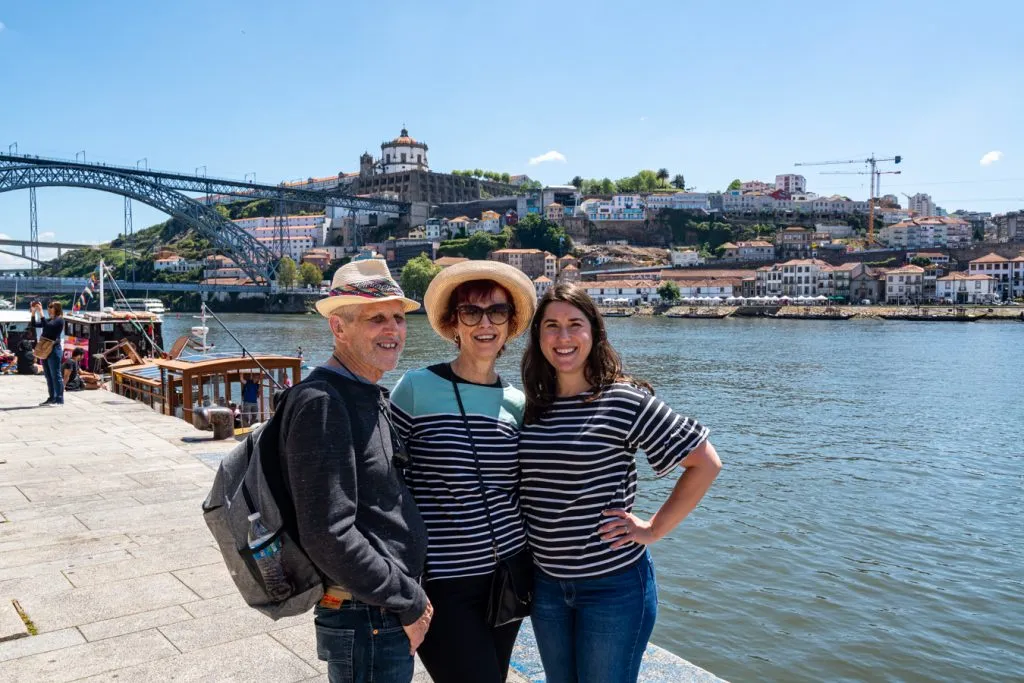
This charming riverfront is technically a separate city from Porto, but it’s also home to all of the port lodges, and no trip to Porto is complete without a port tasting!
This port cellar tour and tasting will give you a good idea of what to expect from a typical tasting, and you can either opt for an organized tour or a build-your-own adventure experience ( Quinta dos Corvos is a personal favorite lodge of ours).
This is also where you can hop on a 6 Bridges Cruise to experience Porto from the water for an hour–a delightful experience in and of itself.
Once you wrap up exploring Vila Nova de Gaia, ride the cable car back up to the top of the Dom Luis I Bridge, where you’ll be treated to gorgeous views over the city and an easy walk back to your hotel.
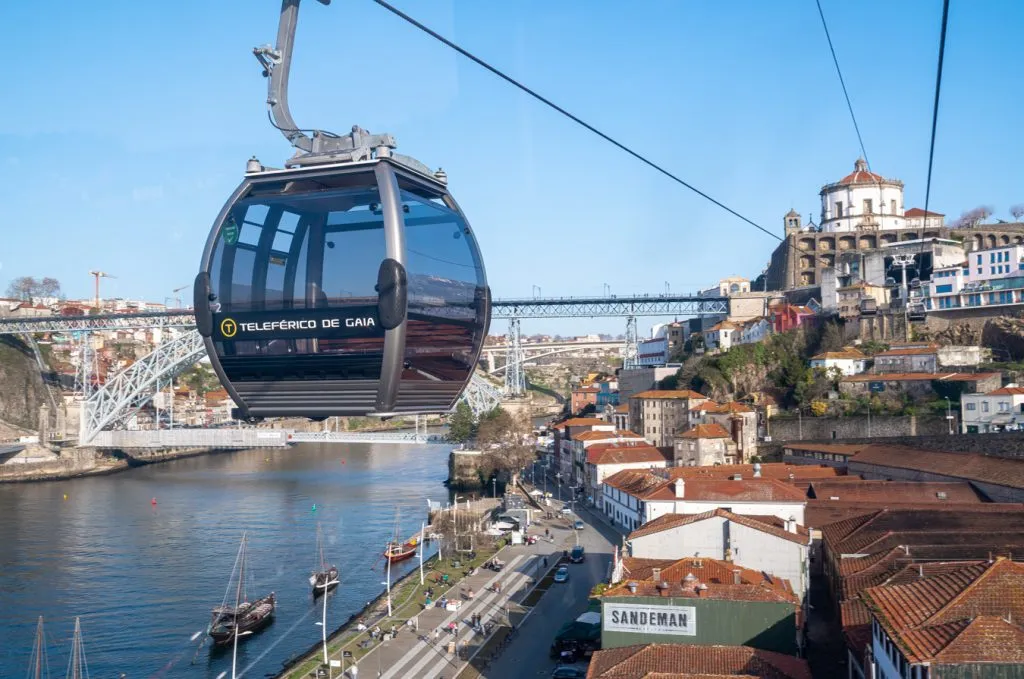
Day 6: Take a day trip to the Douro Valley.
Today, set off from Porto to visit one of the most dreamy destinations in Portugal: the Douro Valley.
Set a couple of hours east of Porto (give or take), the Douro Valley is the origin of the famous port wine and the oldest demarcated wine region in the world.
Here, the wine grows on dramatic terraces leading to the Douro River and, due to how steep the terraces are, the grapes are still harvested by hand.
And, as beautiful as the photos of the Douro Valley are, I have to say: this is one part of Portugal that photography simply sells short.
It is even more stunning in person!
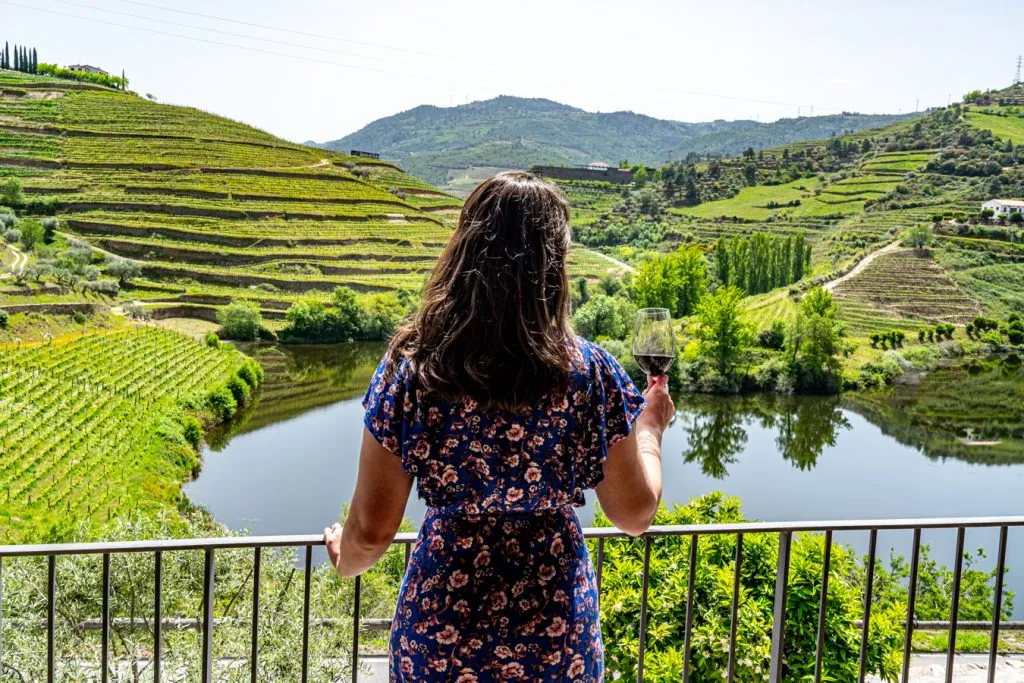
On a day trip to the Douro Valley from Porto, you’ll have time to take in a few mesmerizing viewpoints, attend a port tasting or two at the source, and possibly take a cruise along the Douro River.
While you can rent a car and drive out to a quinta or two yourself, this is one day where a guided tour makes absolute sense.
The best viewpoints in the Douro Valley, while stunning, can require a bit of tricky driving, and for obvious reasons, port tastings and driving on tiny, winding, unfamiliar roads don’t mix well.

With only 10 days in Portugal to work with, this is an area where it’s easier to let experts deal with the legwork.
There are many excellent tours out there, usually offering some combination of a couple of port tastings, a lunch, and a river cruise in the town of Pinhão (if you get a chance to check out the azulejo-covered train station while you’re in Pinhão, be sure to take it).
This day trip is an excellent option for those who want to focus exclusively on the Douro Valley, and this tour is a fun alternative who want to combine the Douro Valley with a stop in the charming small town of Amarante .
Book your Douro Valley day trip today!

Day 7: Make your way from Porto to Lagos.
Without a doubt, traveling from Porto all the way to the country’s southern shores in Lagos is the longest travel day on this 10 day Portugal itinerary.
You essentially have 3 options: first, rent a car and drive, which will likely incur a one-way rental fee (they’re usually quite reasonable, but double-check).
The drive is about 5 hours (360 miles/575 kilometers), not including stops.
Alternatively, you could take the train (6.5 hours and 1-2 changes), or fly to Faro (about an hour of flight time, then another hour to drive to Lagos).
All of the options have their pros and cons, you can price rental cars via Discover Cars here and check train and flight tickets on Omio here . Personally, we’d rather drive or take the train, as we generally consider flying more hassle than it’s worth for distances this short.
Regardless, once you arrive in the Algarve, you’ll likely want a car–so if you don’t pick one up in Porto, you’ll want to grab one once you arrive!
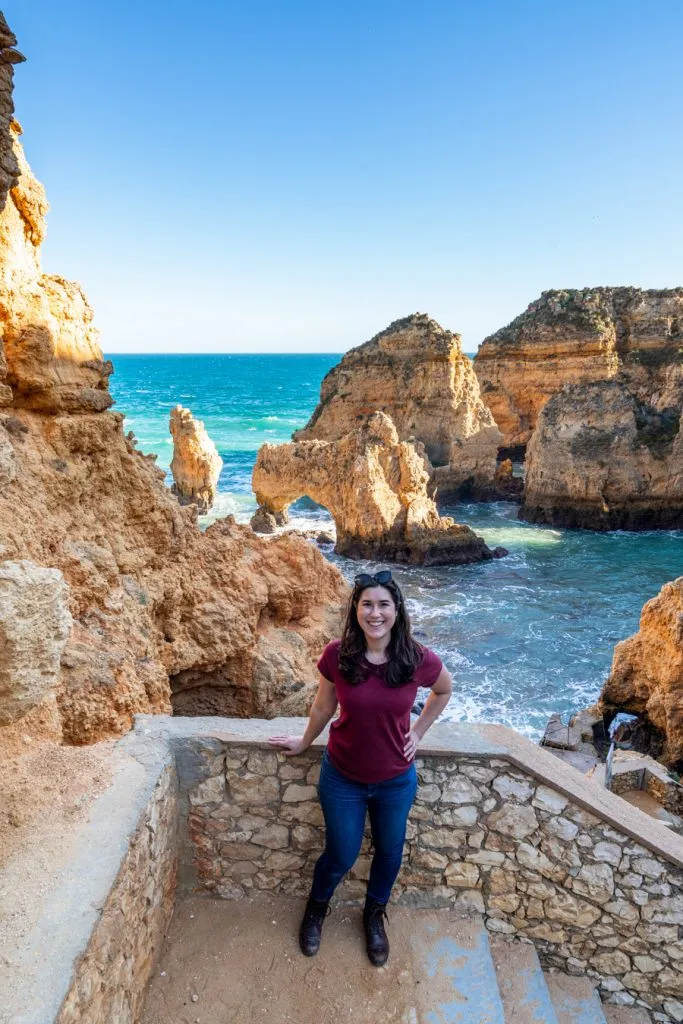
Evening: Lagos’ Historic Center + Ponta da Piedade
Once you arrive in Lagos and get checked into your hotel, you’ll potentially still have a bit of daylight left to work with! Start getting to know the town by wandering the historic center and waterfront.
Fort Ponta da Bandeira is always worth a look and, if it’s still open when you arrive, the Church of Santo Antonio is a must-see.
Ponta da Piedade, one of the most stunning viewpoints in all of Portugal, is a 10-minute drive or 45-minute walk from the center of town and is an excellent place to be at sunset.

Where to Stay in Lagos
Lagos is one of the most beloved beach towns in the Algarve and makes an excellent final base to round off your 10 days in Portugal.
Look for hotels within walking distance of the historic center, ideally with on-site parking, and you’ll be well-positioned to explore the region.
We adored our stay at Tivoli Lagos and would be thrilled to return to enjoy the beautiful property, gorgeous pool, restaurants, and delicious included breakfast again.
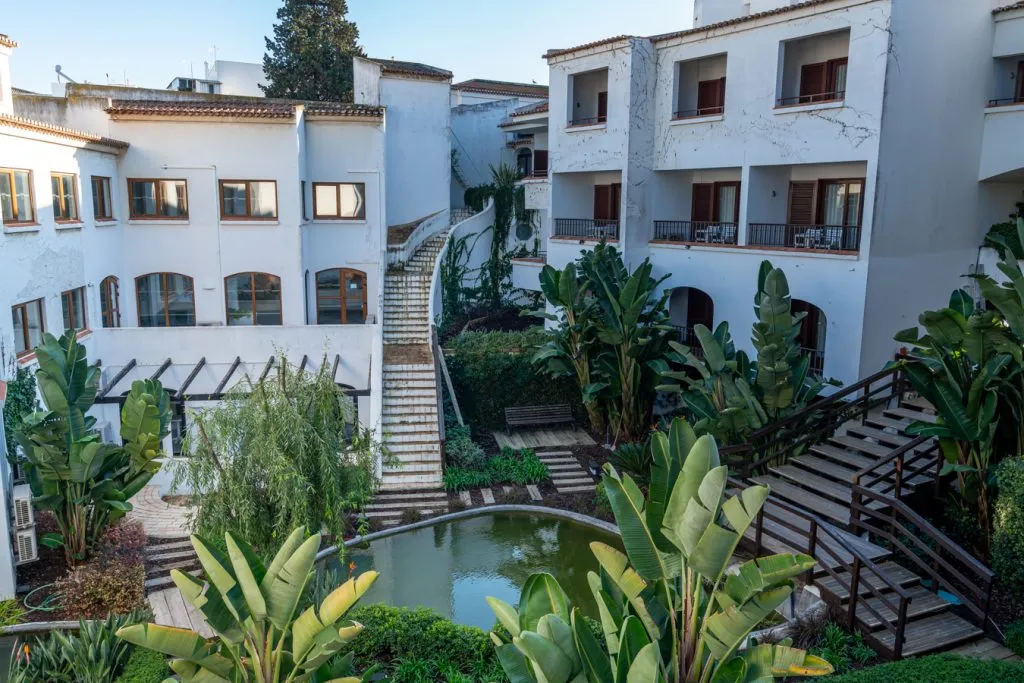
With free parking (almost) on-site, comfortable rooms, and incredibly easy access to Lagos’ attractions, Tivoli Lagos is a fantastic place to stay.
Hotel Lagosmar is another excellent nearby option, and Dream Lagos B&B is a fantastic place to stay when visiting Portugal on a budget.
We recommend staying in Lagos for 2-3 nights.
Check rates & book your stay in Lagos today!
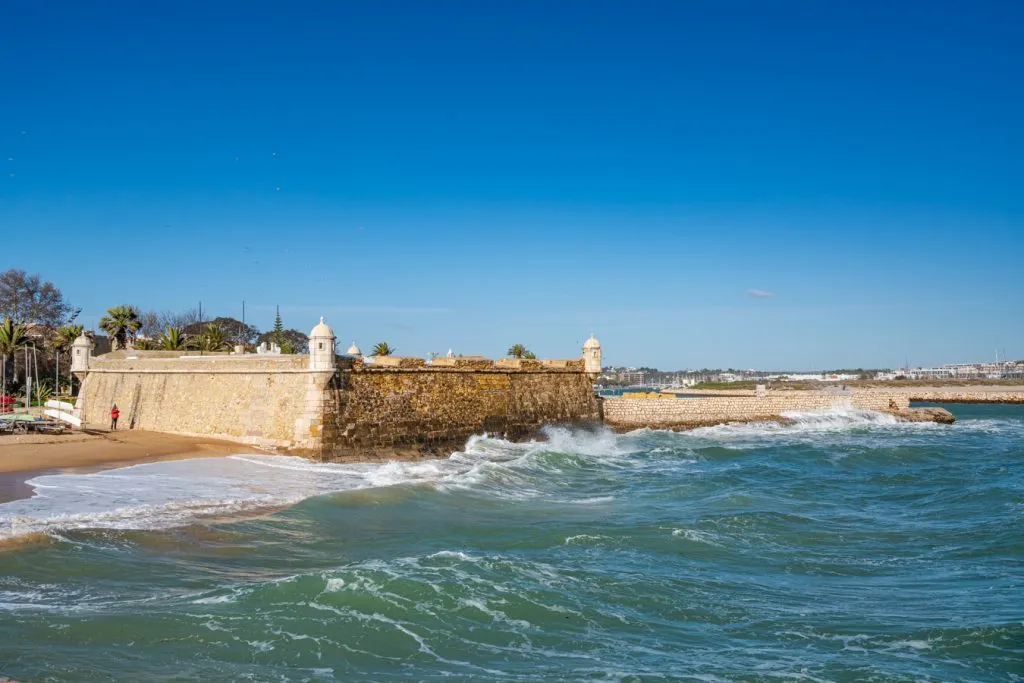
Day 8: See the best of Lagos + nearby towns.
Today is all about enjoying the best of the Algarve, both from land and sea!
Morning: Boat Tour From Lagos
Start your morning with a boat tour from Lagos , which will show you Ponta da Piedade and the coastline of the Algarve from a whole new level.
With any luck, you may spot a few dolphins, as well (though if that’s your focus, a dolphin spotting cruise might be more your speed).
If you’re looking for something more physically active than a boat ride, there are kayaking options as well!
Book your Ponta da Piedade boat tour today!
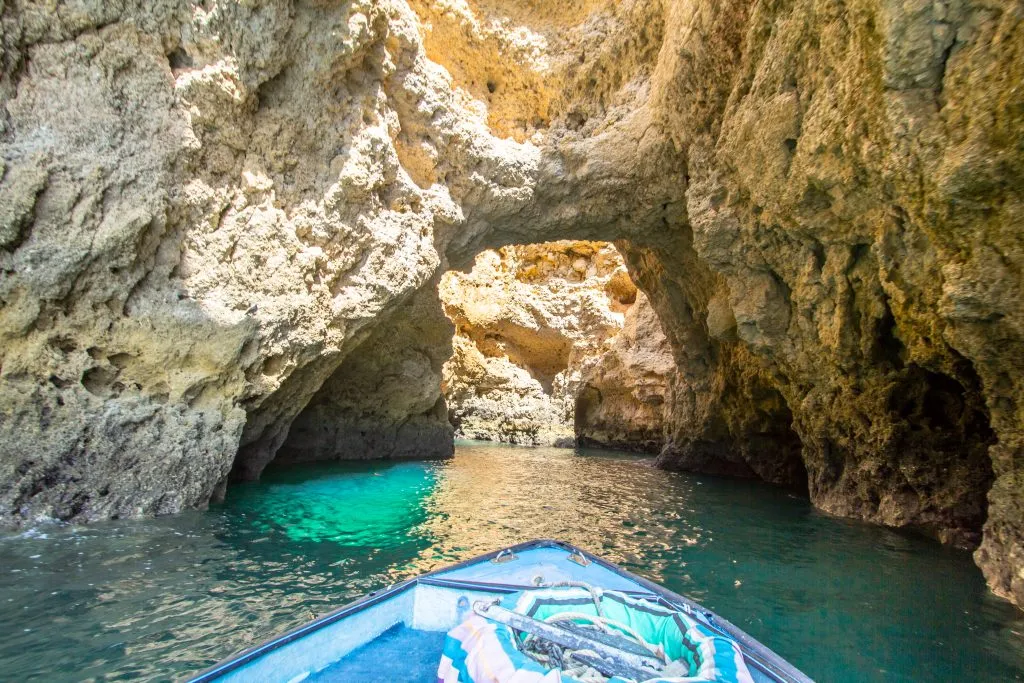
Afternoon/Evening: Algarve Town-Hopping
Lagos may be a wonderful place to visit in Portugal, but it’s surrounded by plenty of other gorgeous, white-washed towns that also deserve to be explored.
Albufeira (busy, beautiful, known for its nightlife) and Ferragudo (charming, laid-back) are both a short drive away and worthy of a visit.
Looking for something a bit more out of the way?
Sagres (yes, like the beer!) is located on the southwestern tip of mainland Europe, about a 40-minute drive from Lagos, and is also a gorgeous option.
It’s best known as a surfing destination, but the town center and scenic views from its 15th-century fortress are also worth checking out.
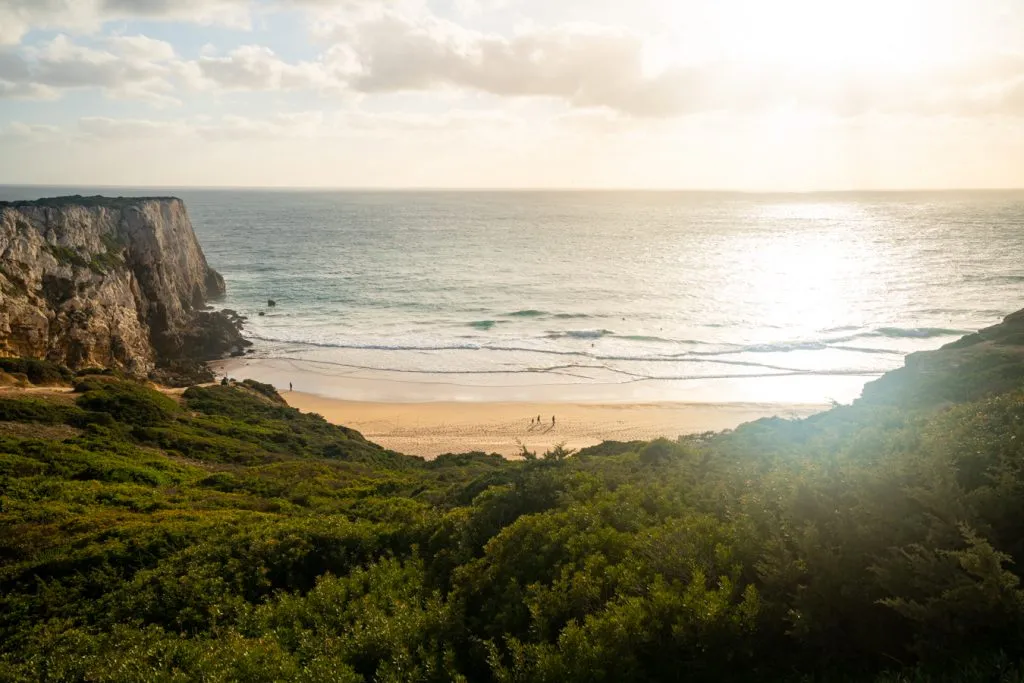
Alternative: Beach Time
Of course, after more than a week of intense sightseeing around Portugal, the idea of even more tours, towns, and attractions may sound more exhausting than invigorating!
If that’s you, don’t worry: the Algarve has plenty of beaches ready to help you relax as long as you need.
Praia Meia, Praia do Camilo, Praia dos Estudantes, and Praia do Pinhão are just a handful of the many dreamy beaches in the immediate vicinity of Lagos (some within walking distance) that are excellent places to relax.
Fair warning, though: if you hail from a hot climate like us, the beaches of the Algarve don’t have particularly warm water, even in the height of summer.
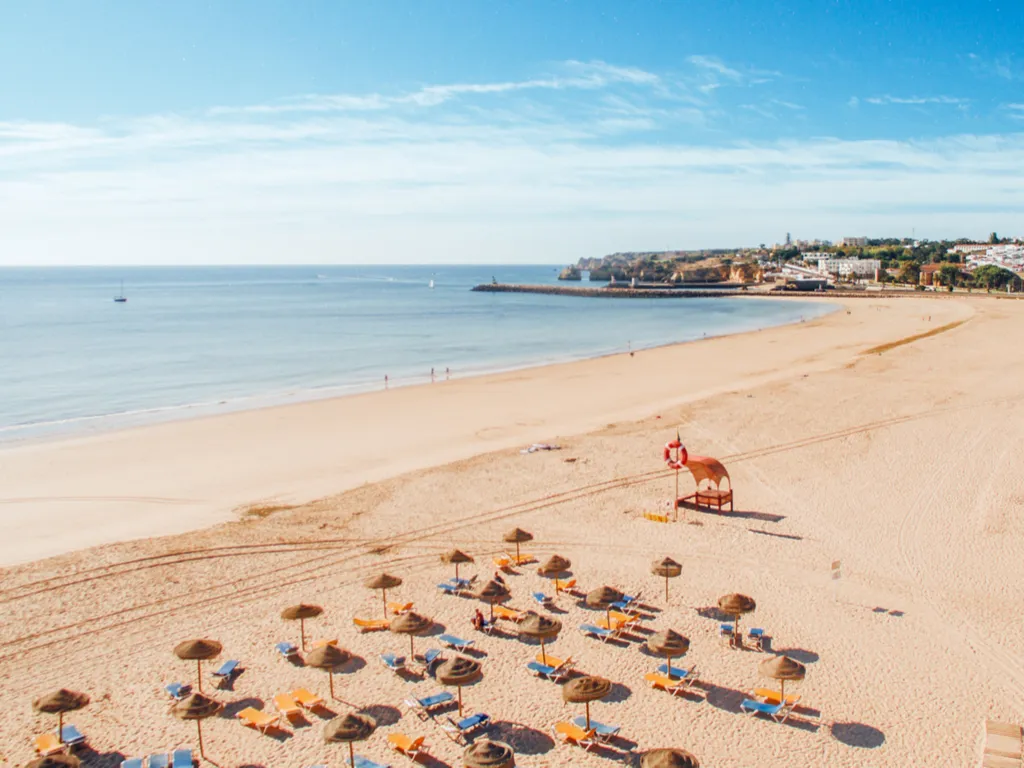
Day 9: Hike the Seven Hanging Valleys Trail and kayak to Benagil Cave.
Hiking, kayaking, and coastal views are what your last full day in Portugal is all about!
Of course, there’s also the perfectly valid option of relaxing on (or continuing to relax on) one of the Algarve’s many legendary beaches today instead–more on that in a bit.
Morning: Bengail Cave + Carvoeiro
If you’ve seen photos of a sea cave in Portugal, odds are it was of the stunning Benagil Cave.
This absolutely gorgeous cave is an iconic spot in the Algarve, and experiencing it yourself is one of the best things to do in Portugal!
In order to access Benagil Cave, you’ll need to do so from the water–and kayaking (or SUPing) the 200m required is the perfect option.
Don’t want to kayak or SUP?
You can still visit Benagil Cave, but here’s the catch: regulations prevent boat tours like this popular one from letting participants disembark in the cave.
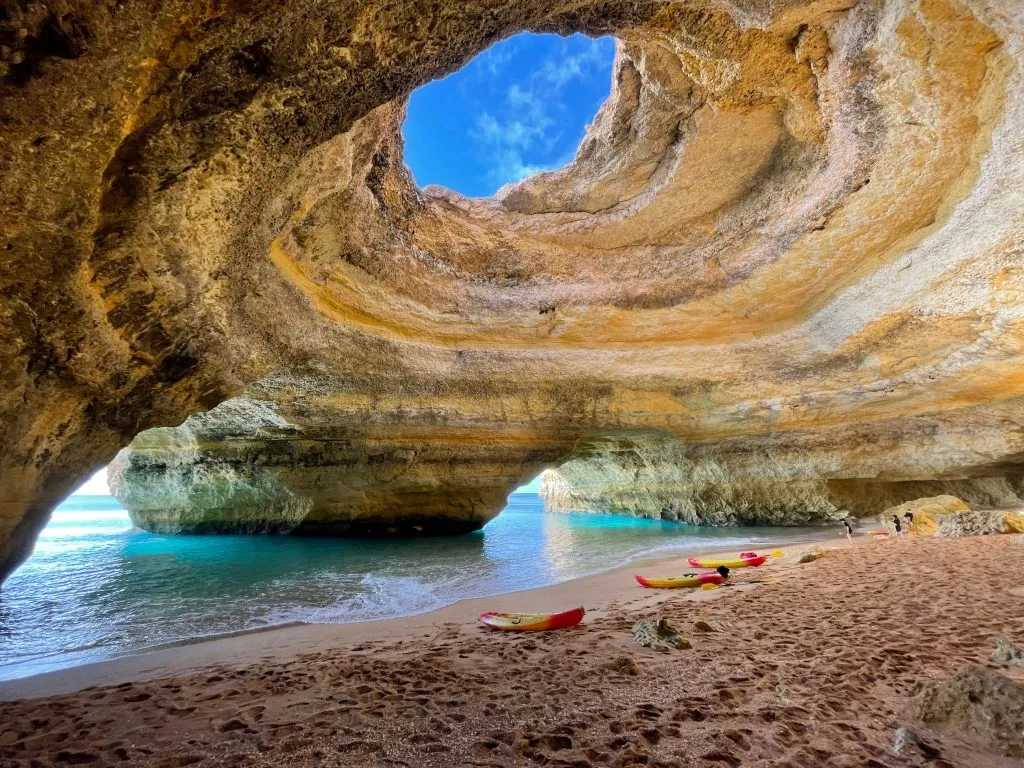
If you want that iconic view of Benagil Cave from standing on the small beach inside, you’ll have to sweat a bit to get it!
However, a boat tour has its benefits as well, including more time to visit several other sea caves in the area.
Once you wrap up visiting Benagil Cave–or if you’d rather not–the town of Carvoeiro, where the cave is located, is well worth a wander (and its beach is a wonderful place to enjoy some time on the sand).
Book your Benagil Cave kayaking tour or small boat tour today!
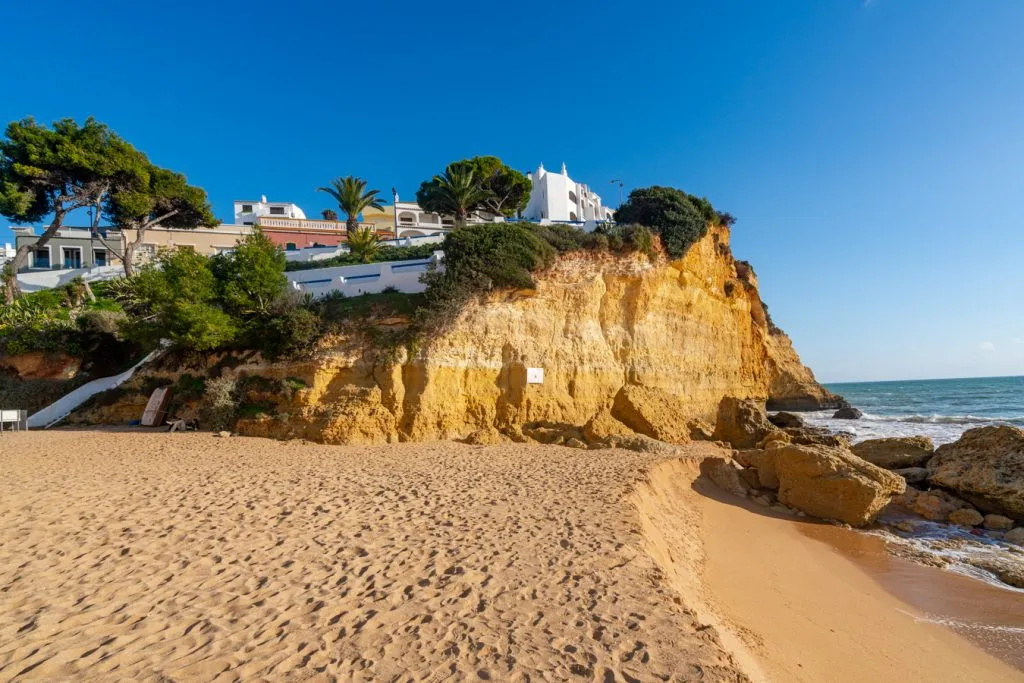
Afternoon/Evening: Seven Hanging Valleys Trail
Often considered one of the best hikes in Portugal, the Seven Hanging Valleys Trail stretches 6 kilometers each way and runs from Praia da Marinha and Praia de Vale Centeanes.
This out-and-back trail is absolutely stunning and one of our favorite places in Portugal, and the very top photo of this Portugal blog post was snapped when we were hiking the Seven Hanging Valleys Trail. Featuring magnificent views all the way through, every step of this moderate trail is a delight.
You’ll even hike right over the Benagil Cave, though a fence prevents you from being able to see into the cave very well.
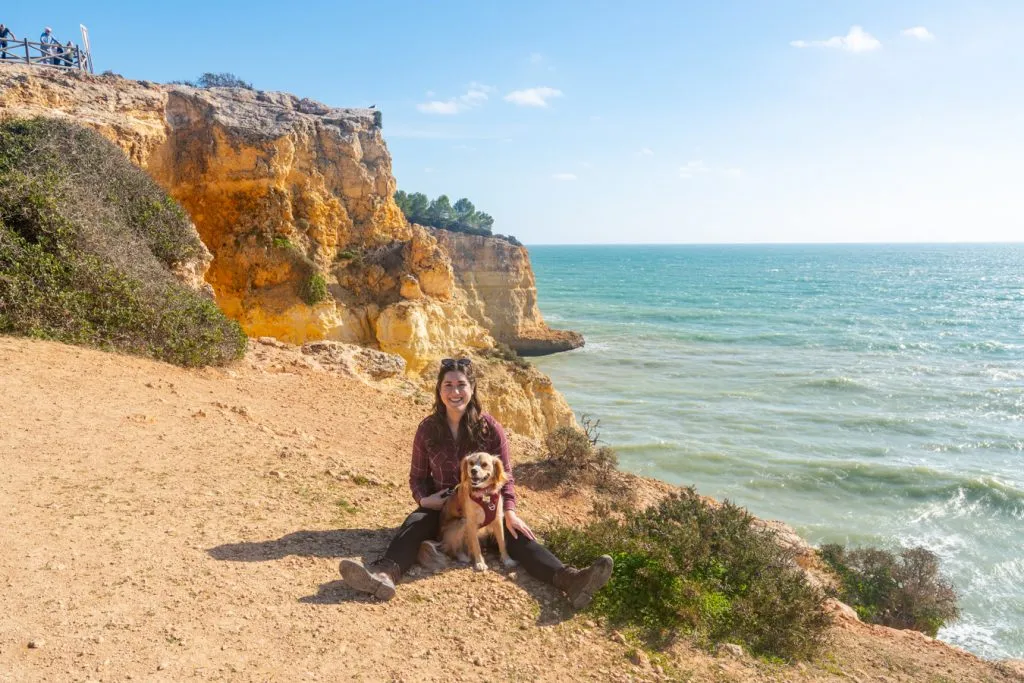
Alternative: Beach Day
If you’re looking for a beach to enjoy as you get ready to wrap up your 10 day Portugal itinerary, you can’t beat the iconic Praia da Marinha.
Situated at one end of the Seven Hanging Valleys Trail, the Praia da Marinha is absolutely stunning and a fantastic place to either enjoy the sand or admire from above.
Countless publications, including the Michelin Guide, have ranked Praia da Marinha as one of the most beautiful beaches on Earth over the years, and to see it in person is to fully understand why.
There’s parking near the beach, and if you’re not up for a full hike, you can always hike however much of the Seven Hanging Valleys Trail you would like from there, and then double back to the beach when you’re ready.
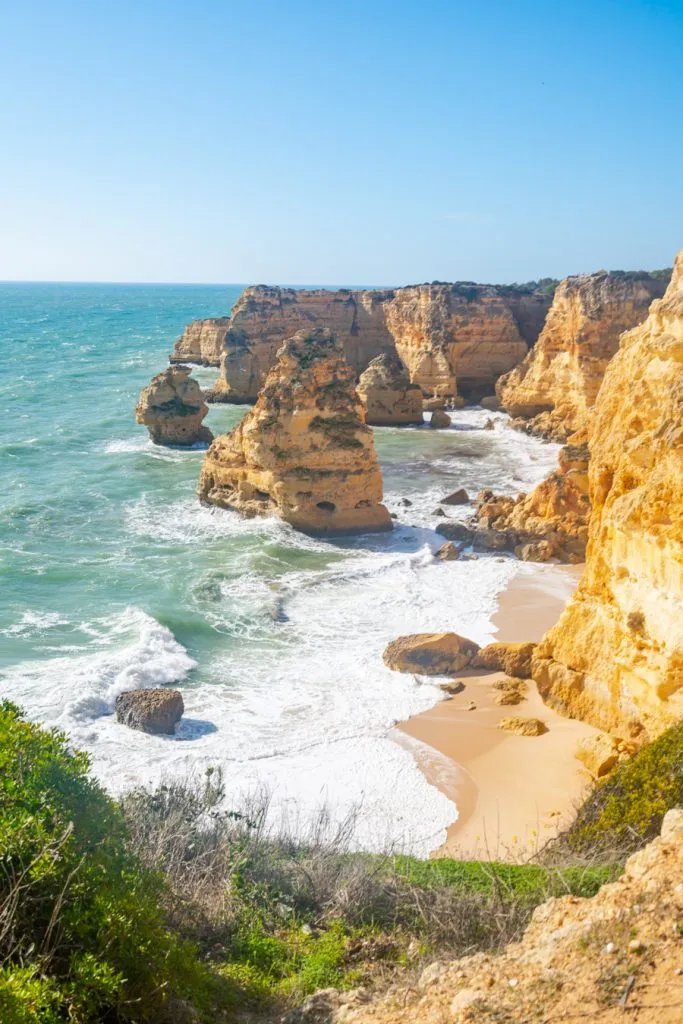
Day 10: Make your way back to Lisbon and say goodbye to Portugal.
… over one more pastel de nata, probably!
Honestly, depending on what time your flight leaves, you may need to return to Lisbon on the evening of day 9 instead.
But, since Lagos and Lisbon are less than 3 hours apart by car, you can still have a full day of exploring and then drive back the evening of your 9th day.
If you have an evening flight out and wake up in the Algarve this morning, we recommend getting one last glimpse of the sea if you have time!
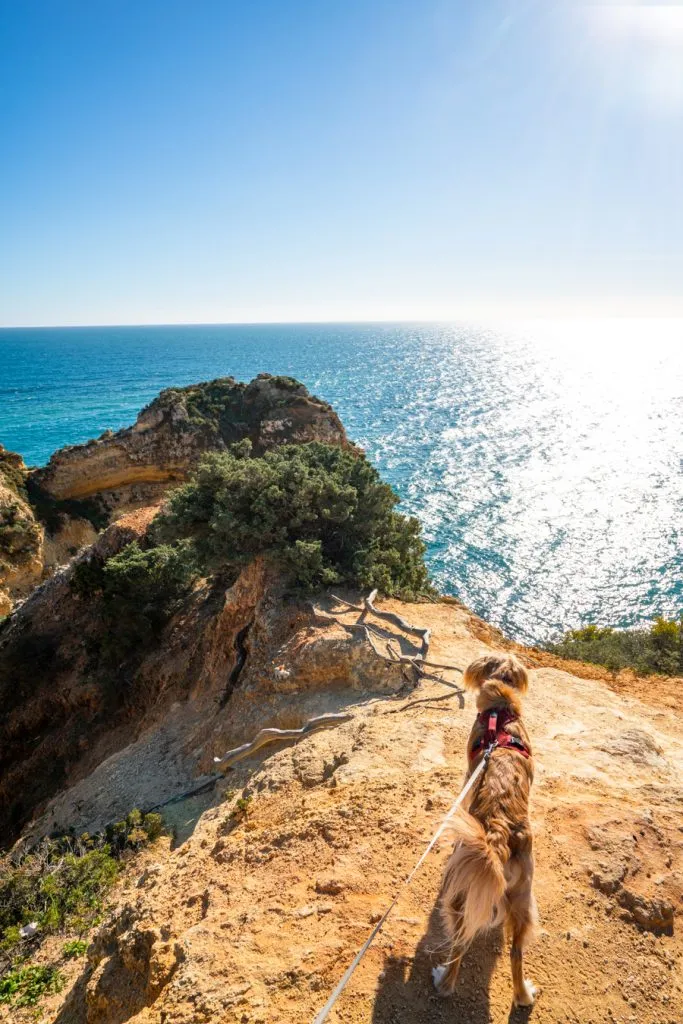
It’s very tempting to simply use this section to make a list of all the incredible places that we love in Portugal–but that’s not particularly helpful!
However, if you have more than 10 days to work with–say, around 2 weeks in Portugal or so–here are the destinations we’d strongly consider adding to your itinerary.
You won’t have time for all of them, even with a full 14 days to work with, but some will likely catch your eye more than others.
And, all of these places are within around 2 hours of Lisbon, Porto, or both, making them smooth additions to your route.
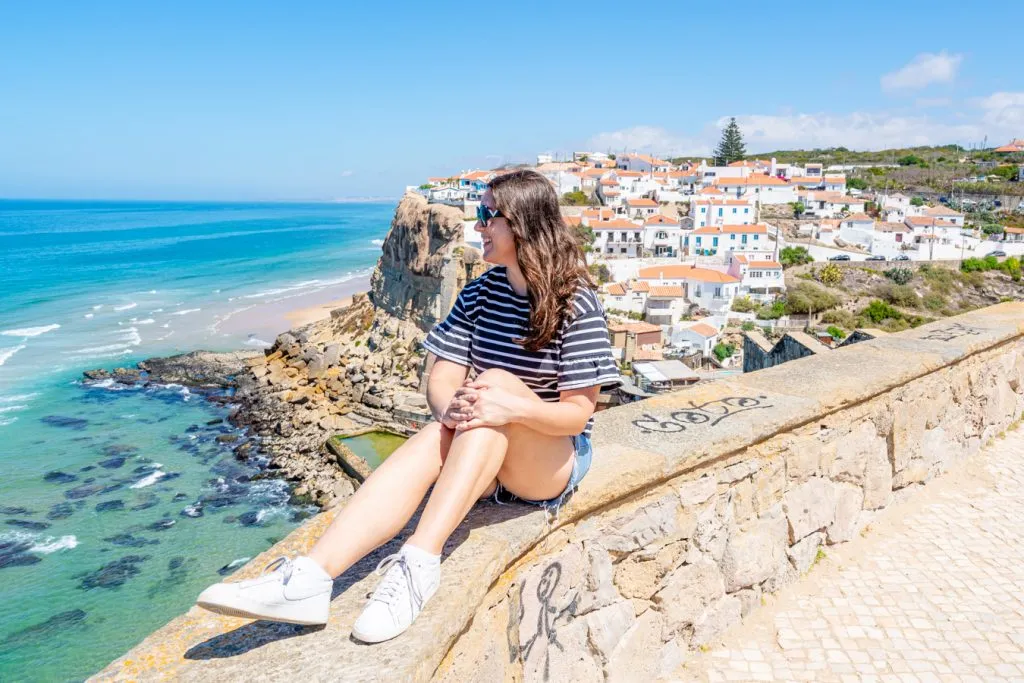
One of our absolute favorite small towns in Portugal, Obidos lies about an hour north of Lisbon and is completely surrounded by the intact walls of its medieval castle.
And, one of the best things to do in Obidos is to simply stroll along the tops of those walls!
Check our our guide to the best things to do in Obidos!
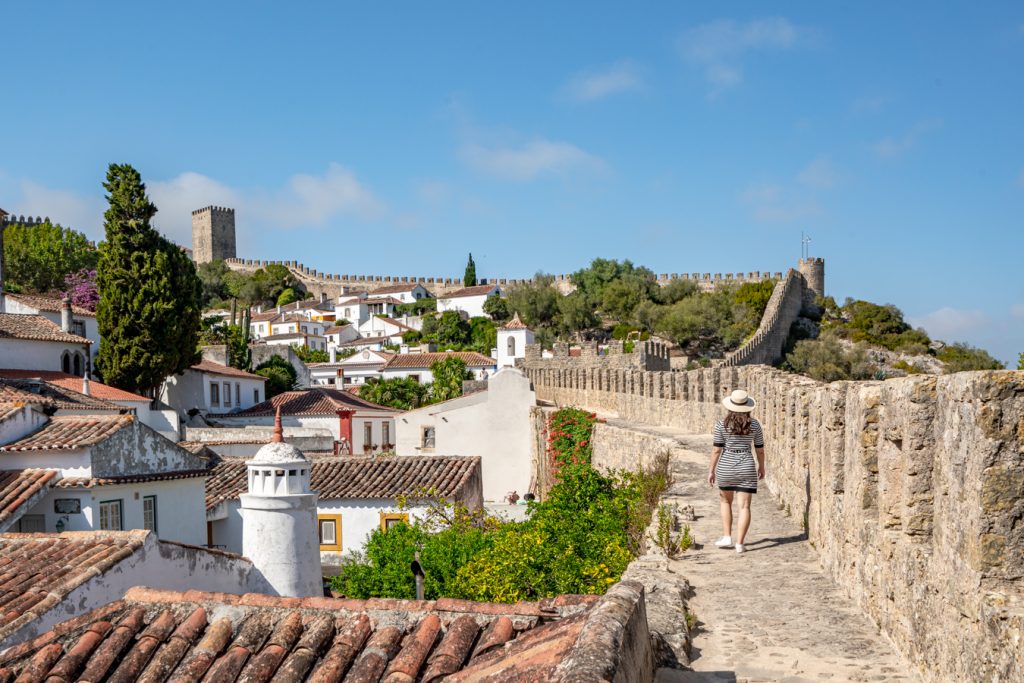
Alcobaça + Batalha + Tomar
The monasteries of Alcobaça and Batalha, plus the Convent of Christ of Tomar, are all UNESCO World Heritage Sites that are located within fairly short drives of each other, only 1.5 hours or so north of Lisbon.
They also happen to be typically uncrowded and are some of my favorite places in Portugal!
Tomar, and the Convent of Christ of Tomar in particular, has 12th-century roots in the Knights Templar.
All 3 destinations have absolutely mesmerizing architecture and are well worth visiting.
(Entrance to all 3 is also included with the Lisbon Card , so if you plan to purchase the card, try to structure your visits here so they’ll be covered).

As Lisbon’s most convenient beach/resort town (less than an hour by train or car), Cascais is a local and tourist favorite!
From relaxing on the beaches to checking out fun attractions like the Boca do Inferno and the Castro Guimaraes Museum (well worth the 4 Euro entry fee), Cascais is a fun addition to any Portugal itinerary.
It also doesn’t take long to see: whether you have 2 hours or 2 days, you’ll have fun in Cascais.
Here’s our guide to taking a day trip to Cascais.
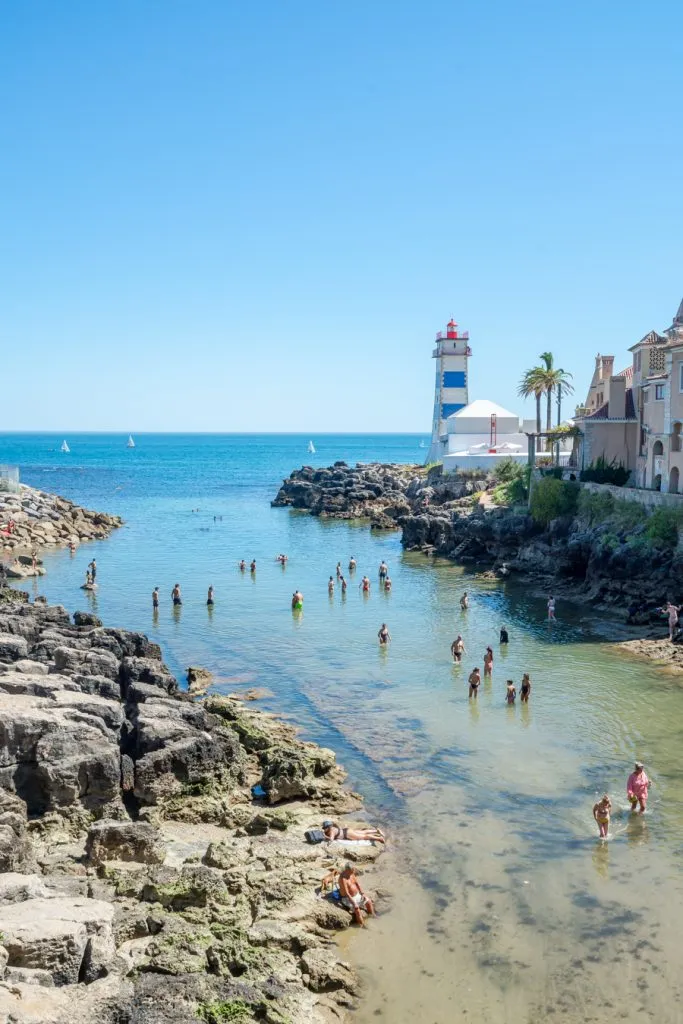
Braga, located northeast of Porto, is best known for its famous UNESCO World Heritage Site, Bom Jesus de Monte.
Exploring the city center, and visiting the many other historic churches in the city (including the Braga Cathedral), are also well worth your time.
As the capital of Portugal’s Alentejo region, Évora makes a fantastic day trip from Lisbon or an overnight addition to a Portugal itinerary.
While you’re there, don’t miss the 12th-century Gothic Cathedral, the spooky Chapel of Bones, or the remains of a 2000-year-old Roman temple that you can find in the center of the city.
Check out our guide to the best things to do in Évora!

Known as the “birthplace of Portugal”, Guimarães is located in the north of the country, not far from Braga and within day-tripping distance from Porto.
The 10th-century Guimarães Castle and the 15th-century palace of the Duke of Bragança are among the best things to see in town, but don’t miss the chance to explore the historic center, either!
Home to the UNESCO World Heritage-recognized University of Coimbra, Portugal’s “third city” is incredibly beautiful and mixes ornate architecture and lengthy history (it was the capital of Portugal from 1139 to 1385) with youthful energy.
Note that Coimbra is located along the train route between Lisbon and Porto, and is a very easy stop to add between the two.
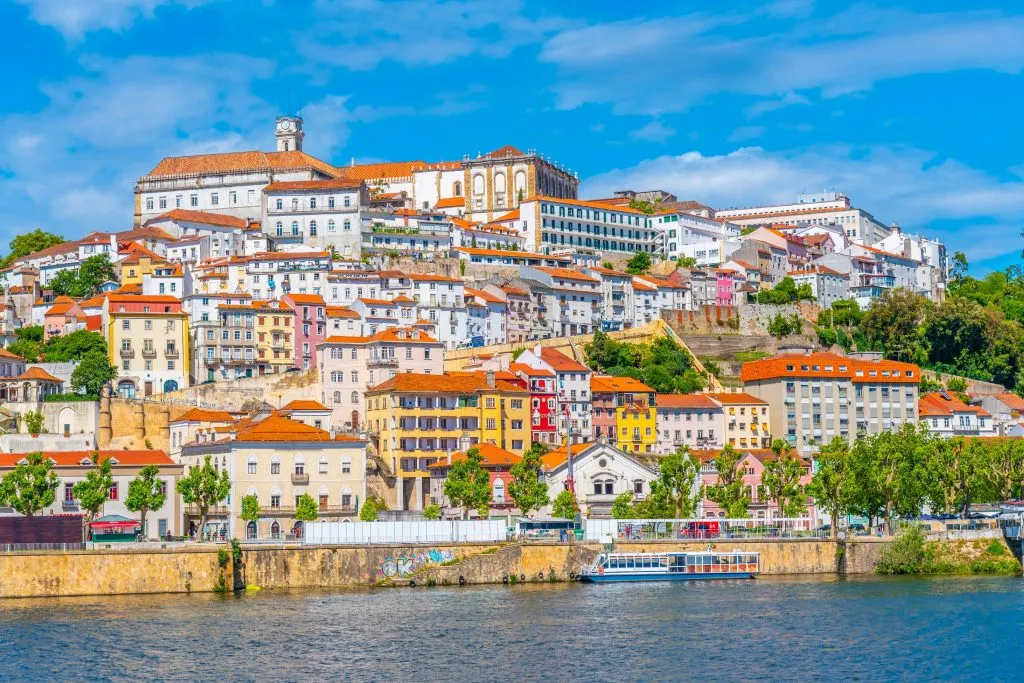
Choose your day trips based on your travel style.
We’ve structured this 10 day Portugal itinerary to cover the country’s biggest highlights in a short amount of time–which, realistically speaking, means visiting some places (Sintra, for example) that tend to be crowded.
If you know that you’re a fan of quieter, more offbeat destinations, Lisbon and Porto both have an overwhelming number of options!
Instead of Sintra, for example, you could head to Évora or Tomar.
Instead of the Douro Valley, you could visit Braga and Guimarães .
There are no wrong answers, and there are far more incredible things to see in Portugal than you can cover in less than 2 weeks.
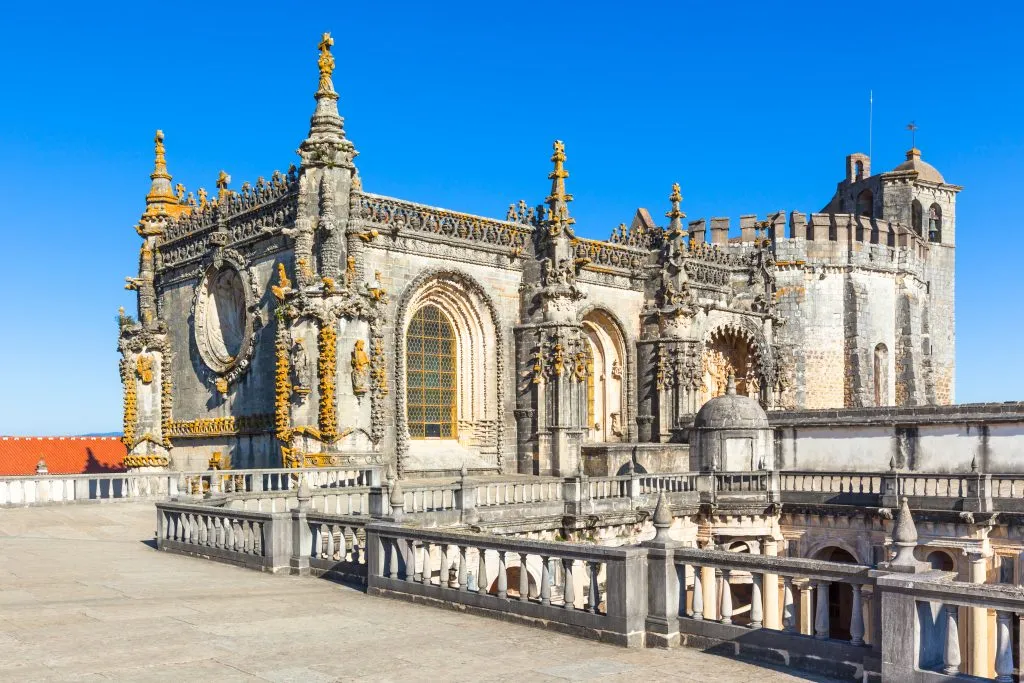
Don’t overextend your itinerary.
Given Portugal’s compact nature (it’s about the same size as Indiana) it can be very tempting to add on “just one more!” destination to your travel plans. Try to resist the urge, though!
This itinerary for Portugal is already very fast-paced as written, and you don’t want to end up spending all of your time in a car or on a train instead of enjoying the country.
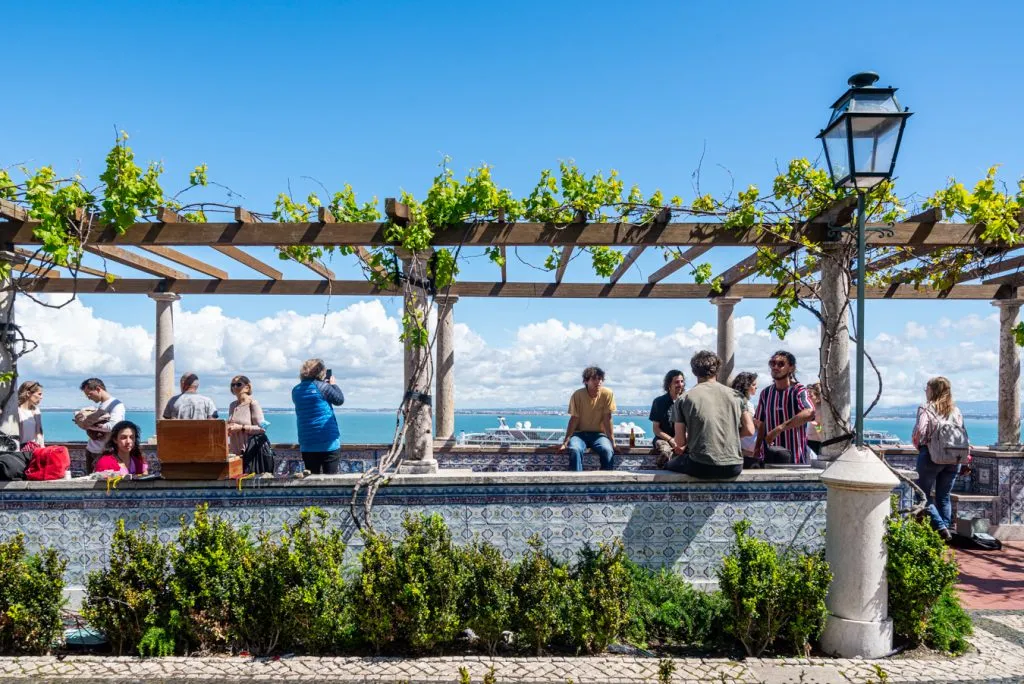
Carefully consider how you’ll get from place to place.
While Portugal’s train system is very useful in some areas–like traveling between Lisbon and Porto–it can get a bit more complex on other routes.
Even traveling between Lisbon and Lagos via train , for example, requires making a change.
And taking a day trip to Évora from Lisbon via train, while it looks simple on paper, requires some careful planning, as there are only 2 trains per day.
Rental cars can come in handy here, and for places very close to a major city (like Cascais and Sintra), so can taxis and/or Ubers.
Check train routes + schedules in Portugal today!

Bring shoes with an excellent grip.
Portugal’s traditional pavement, or calçada portuguesa , is one of the most distinctive features of the country’s cities and towns (though you’ll also find it in many of the places Portugal once colonized).
These walkways are beautiful, distinctive, and quite slippery–especially in the rain.
Watch your step, especially on hills, and opt for shoes with some grip on them!
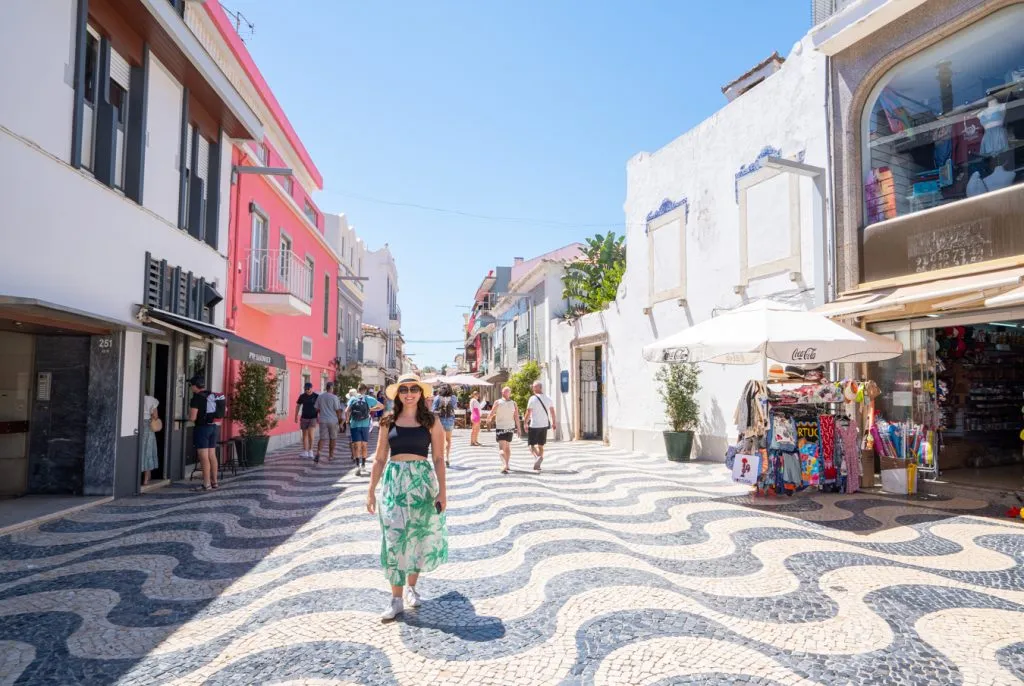
Be prepared to climb lots of hills.
Most of the places included on this 10 day Portugal itinerary, including both Lisbon and Porto, are famous for their steep hills!
Be prepared to get a workout when exploring both cities, as well as in places like Sintra.
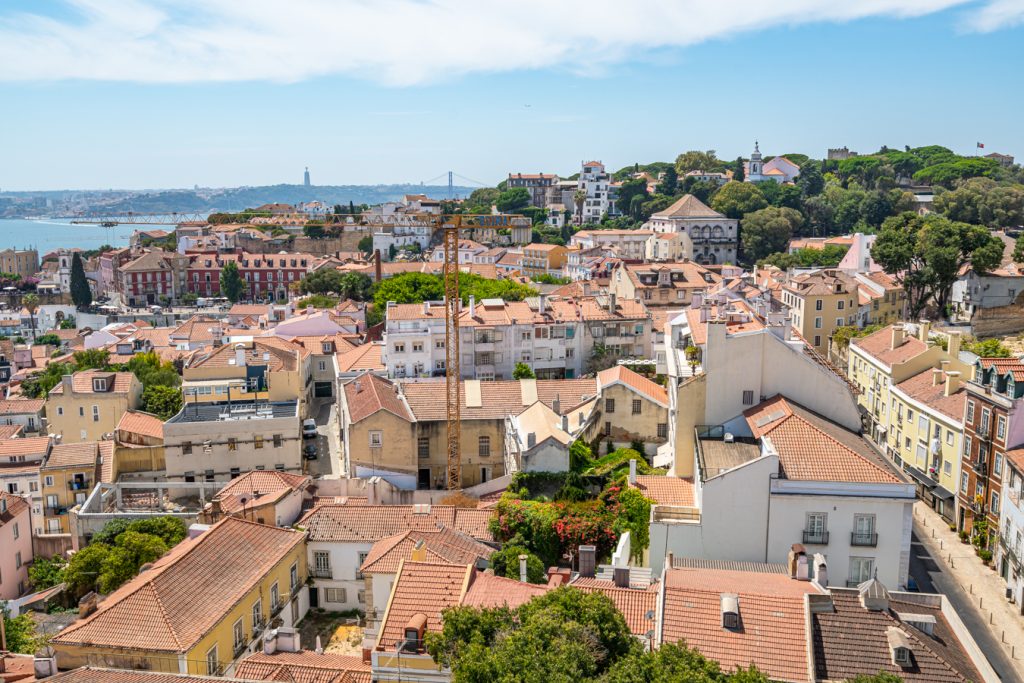
Portugal is the epitome of a year-round destination, and this itinerary for Portugal in 10 days is equally viable in January and July.
There will be a few things that change with the seasons, of course–the Algarve in January will mean more pleasant hiking but no swimming, and you’ll certainly fight more crowds at Pena Palace in August than you would in March–but the overall structure of the route is solid at any time of the year.
Portugal’s winters are extremely mild but can be wet, especially in the north.
Plan for rain if you’re visiting in the winter, but that’s no reason to cancel your trip.
After all, you could just as easily end up with January weather in the Algarve that looks like this:
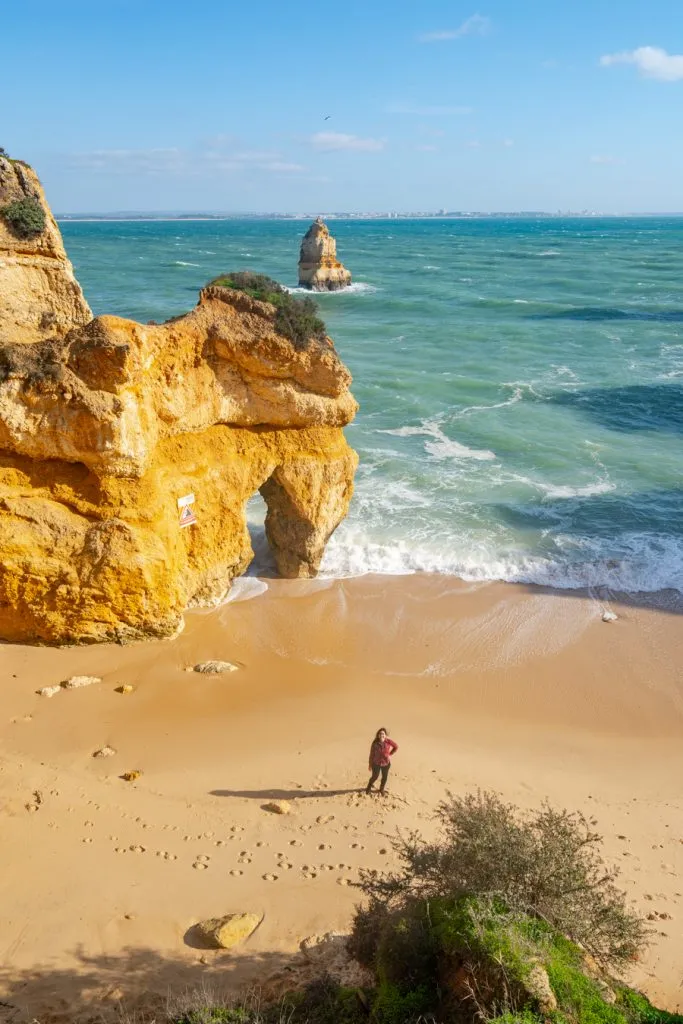
If we had to pick our absolute favorite times to recommend for visiting Portugal, we’d recommend April/May (the jacaranda trees blooming in Lisbon in May is a special bonus!), and September/October.
In other words, shoulder seasons that offer plenty of sunshine and mild weather, while avoiding the worst crowds of July and August.
Our summer packing list for Europe will cover the vast majority of what you need to bring to Portugal–but here are a few essentials to keep in mind!
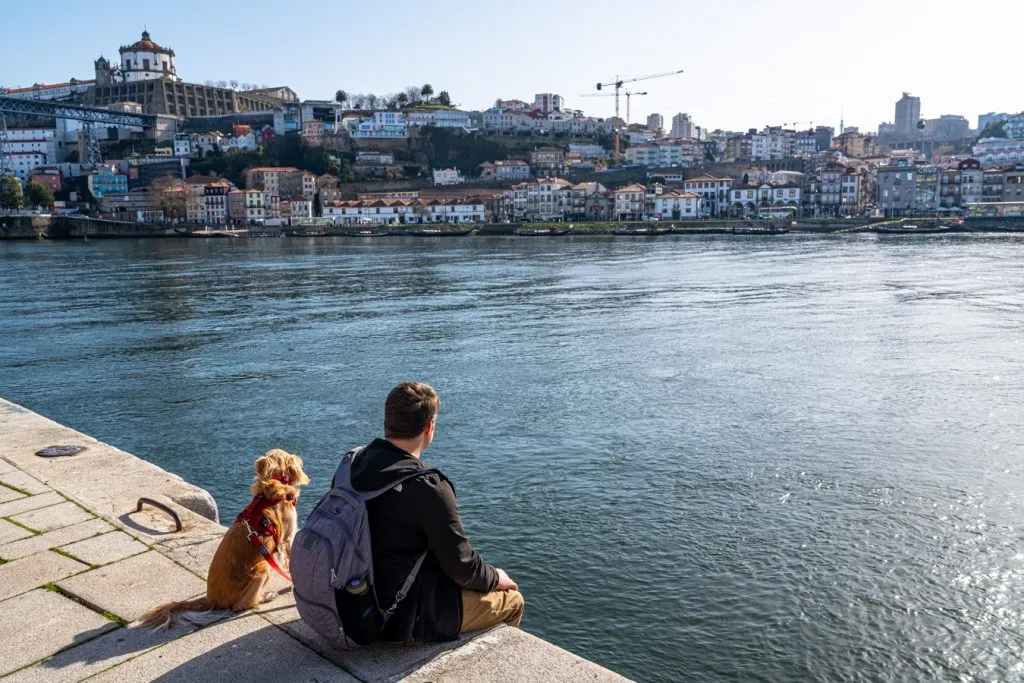
Travel Adapters for Portugal — If you’re coming from outside of Europe, you’ll need adapters for your electronics.
Dry Bag — Want to keep your electronics safe during a beach day, kayaking tour, or boat trip?
Securing them in a dry bag is the perfect low-cost solution!
Sunglasses — Remember how I mentioned that the beautiful calçada portuguesa is incredibly slippery?
Well, there’s another hazard: it’s also incredibly bright!
You’ll want to wear sunglasses even more than usual during your 10 day Portugal vacation.
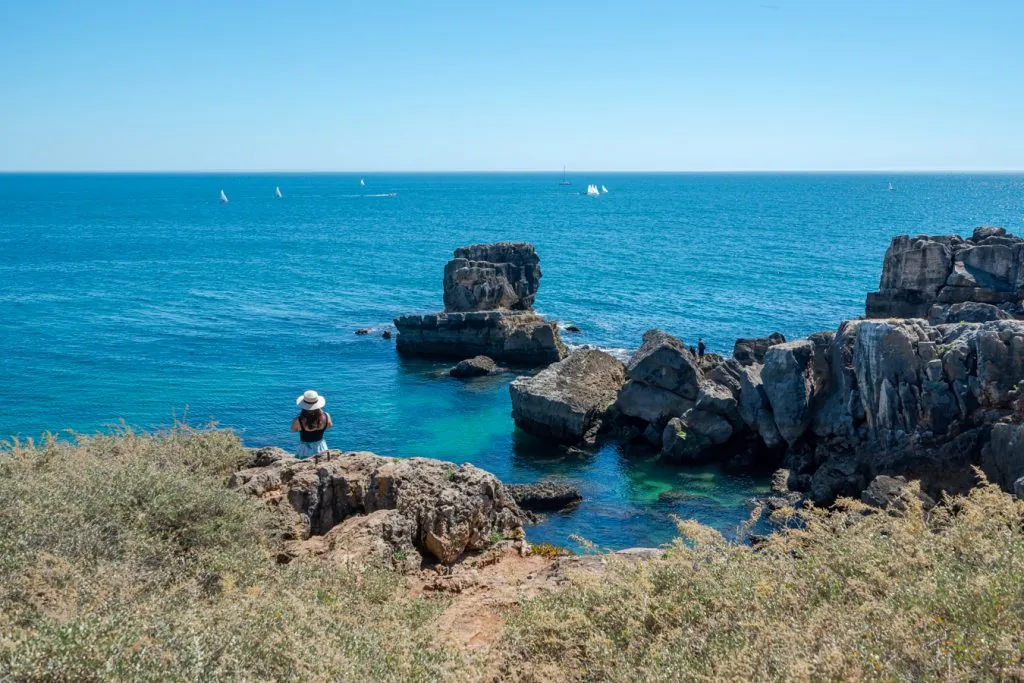
Camera — We absolutely adore our Sony a7R III , but whatever camera you’re comfortable with works.
Just make sure you have something with you to preserve your memories!
Hand Sanitizer — We carry this everywhere, and have never been sorry to have it floating around in our day bag.
Reusable Water Bottle — Cut down on plastic waste and save money by bringing a reusable water bottle along for your 10 days in Portugal!
[convertkit form=3127238]
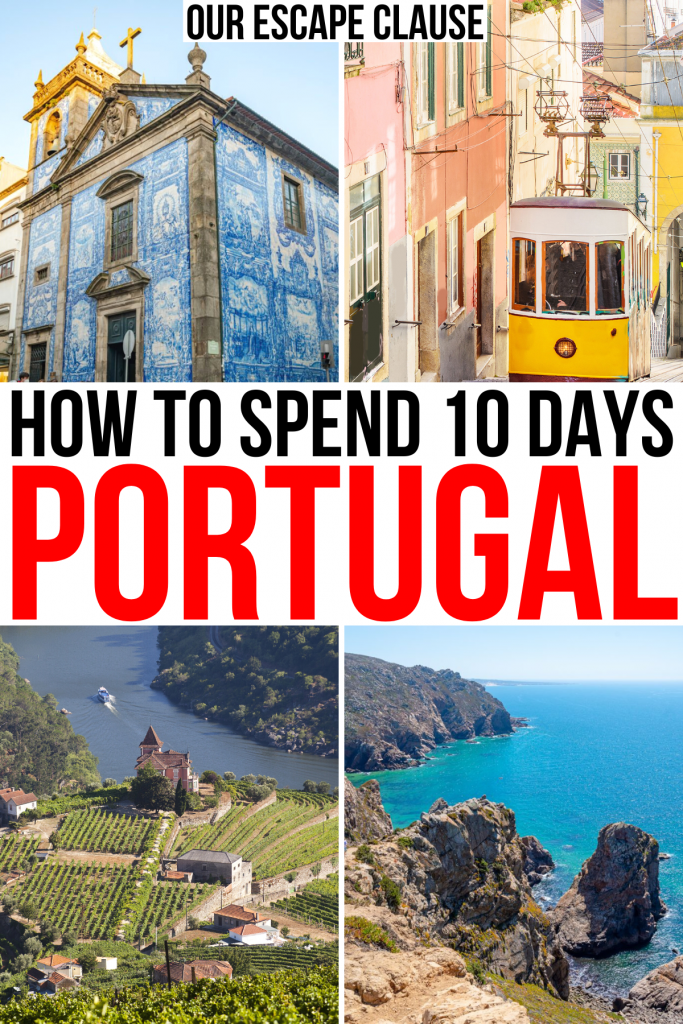
About Kate Storm

In May 2016, I left my suburban life in the USA and became a full-time traveler. Since then, I have visited 50+ countries on 5 continents and lived in Portugal, developing a special love of traveling in Europe (especially Italy) along the way. Today, along with my husband Jeremy and dog Ranger, I’m working toward my eventual goal of splitting my life between Europe and the USA.
49 thoughts on “The Perfect 10 Days in Portugal Itinerary (+ Travel Tips!)”
Thanks for the treasure trove of information. We are going on 10 day trip to Portugal in early March and your travelog is very helpful in planning our trip. One question: after 3-4 days in Lisbon, what would you think of renting car for the rest of the trip to Porto and Algarve? Is parking in Porto a hassle to be avoided? Thanks Kam
If you’re hoping to make a day of the journey and stop somewhere between Lisbon and Porto (Alcobaca Monastery, Batalha Monastery, or Obidos would be a few of our top picks), you can absolutely do it that way!
With only 10 days in Portugal, you’d likely be trading extra time in Porto to be able to do so, but if that sounds like a fair trade-off to you it’s workable.
You definitely won’t need a car when sightseeing in Porto, but parking isn’t too bad. There’s a garage right down the street from the NH Hotel we used when we decided to drive up one trip, and you can get in and out of the city fairly easily from there.
Many thanks for your reply, it was very helpful. Apologies for my late response, was out of pocket for some time. On further checking and deliberation, I think we will do the train and rent a cart only in Algarve, to make it easy on ourselves driving wise in a new country. Our plan now looks like the following (4N Lisbob, 3N each in Algarve and Porto): 2/28: Arrive Lisbon 3:10 pm 3/1: Lisbon 3/2: Lisbon 3/3: Lisbon 3/4: Morning train to Lagos arriving noon-2 pm (depending on which train) 3/5: Algarve 3/6: Algarve 3/7: Train to Porto arriving 1:30-3:30 pm (depending on which train) 3/8: Porto 3/9: Douro valley 3/10: 2 pm train to Lisbon 3/11: Early morning flight out of Lisbon to Houston
Sounds like a fantastic trip!
Hope you guys have a great time, and we’d love to hear how it goes!
Thank you for this wonderful deep dive into a country we’ve been so excited to visit for a long time. Just booked our flights for this July, and we’ve constructed an itinerary very much based on your guide! Leaning Lagos for our Algarve stay as it seems central to explore the coast in both directions. Here’s our plan!
• Fri Jun 30: fly to Lisbon PM • Sat Jul 1: arrive Lisbon AM / Lisbon PM • Sun Jul 2: Lisbon • Mon Jul 3: Sintra tour • Tue Jul 4: train to Porto AM (3.5hrs) / Porto PM • Wed Jul 5: Porto • Thu Jul 6: Douro valley tour (port tasting!) • Fri Jul 7: drive to Lagos/Algarve (5hrs) / Lagos PM • Sat Jul 8: Algarve • Sun Jul 9: Algarve • Mon Jul 10: Algarve / Lisbon • Tue Jul 11: fly home
Sounds like an excellent trip! You guys are going to have a fantastic time.
So glad we were able to help with your planning. 🙂
Hi Kate, thank you for such great ideas. What do you think of this itinerary:
fly into Porto – 2-3 days (river cruise) then train/bus Coimbra – 1 day then train or bus to Lisbon – 5 days (Sintra/Obidos/Evora/Fatima) then train or bus to Algarve – 2 days then train or bus to Lisbon – fly home
too much for so little time? is it worth doing a multi-city airline ticket?
Hi Christine,
Sounds like you have about 13-14 days to work with, right? If so, that’s doable, but I’d mix it up a little bit.
I’d recommend trimming one day from Lisbon to add an extra day in the Algarve.
While in Lisbon, you can easily visit Obidos and Fatima on the same day. You might also look into visiting Alcobaca Monastery or Batalha Monastery that day as well.
Personally, if it fits into your budget I’d definitely consider the multi-city airline ticket. If you can save a day of doubling back it’ll buy you more time to explore!
If you plan to do that, be sure to check rates from the Faro Airport as well–it’s much smaller than Lisbon’s but worth checking prices for as that could save you doubling back to Lisbon as well.
Hope that helps and that you guys love Portugal!
What did you have to do to take your dog to Portugal? Is there doggy day care for excursions that do not allow dogs? Do you find English speakers everywhere in Portugal? Any issues with language?
Hi Richard!
We spent over a year living in Lisbon, so we moved Ranger to Portugal with us via plane. We took him to the vet when we arrived to confirm his rabies vaccine and have him examined and got an EU Pet Passport that way.
There are doggy daycares in Portugal, especially in the cities, but I’m not sure how usable they are for visitors versus regular users. We never took Ranger to one.
English is widely spoken in Portugal, though not ubiquitous. You don’t need to speak Portuguese to get by, though learning simple phrases is of course polite and very appreciated! We’ve never run into any issues with language in a travel setting in Portugal.
Hi Kate, great info. Is it necessary to rent a car in Algarve/Lagos? Is the taxi system not very good? And if we did get a car is parking difficult to find?
I’d say it depends on your expectations–it’s possible to rely on a combination of buses, taxis/Ubers, and tours, but it would require a lot more planning and managing of your time.
Lagos is a fairly small place, as are most of the other places first-time visitors want to see in the Algarve. You won’t find the easy-to-access taxi stands you find in Lisbon or anything like that.
Parking is fairly easy, especially if you visit outside the peak summer months and/or get up early (we know people who live in the Algarve who say you can have any beach to yourself early in the morning). Most of the beaches have parking at or near them, and there’s metered parking in towns. It’s nothing like parking in cities!
Hi Kate, Jeremy, Thanks for the detailed notes .. am bookmarking this for our trip. We plan to travel to Portugal with this itinerary. Any recos if this makes sense? What would you change, if anything? 4 – reach Lis by 10am, sightsee (Lis) 5 – Sintra (Lis) 6 – 1/2 day Lis, Leave for Algarve (Lagos) 7 Algarve (Lagos) 8 Algarve (Lagos) 9 Algarve – Porto travel day (Por) 10 Porto (Por) 11 Porto (Por) 12 Porto (Por) 13 – Fly out I am traveling with my family – 2 kids (10 & 7). Would you recommend I book a car from Lisbon, keep it for my Algarve leg and return it to Porto? I am a North American driver – how easy is it to drive here? Would you recommend that over public transport? Thx
Personally, I’d take one day off of Porto and add it to Lisbon! Porto is a much smaller city, you can easily see the majority of its top attractions in 1 to 1.5 days. I’d also recommend considering a day trip out to the Douro Valley from Porto, it’s wonderful!
The driving is pretty simple in Portugal, I definitely wouldn’t hesitate to book a car. You don’t need one in Lisbon or Porto, but it will definitely come in handy in the Algarve.
Lagos is definitely doable without a car but it’s more flexible with one.
Trains are definitely a solid option for getting between cities, but there aren’t any direct trains from Lagos to/from Lisbon or Porto.
Thank you so much for the gold mine of information! We always travel with our small dog too, coming from Washington DC. We generally bring him everywhere on our travels and have a comfortable bag pack to bring him into some buildings/restaurants if they don’t allow a dog out of the bag but are okay with him being in the bag- which he happens to love. Im curious if any of the tours or castles, monasteries, kayak tours, boats etc take dogs? What was your experience? We’re going in mid December along your route. Hopefully weather is good. It’s our only school break where the whole family can travel together. We’re hoping to find some Christmas markets too!
Hi Melanie,
Absolutely, I’m so glad you found it helpful!
Portugal is reasonably dog-friendly by European standards (which is very friendly compared to most of the US), but dogs aren’t generally allowed in most attractions like castles or monasteries. You’d need to ask on a case-by-case basis, but I wouldn’t count on it. (If you were going to France or Italy… that’s another story).
Boats you might have a bit more luck, but again, you’d have to ask.
Ranger didn’t visit any attractions with us in Portugal, though he was universally welcome on outdoor dining patios.
The good news about visiting in the winter like you are is that many of the beaches that don’t allow dogs during the high season are more lax about furry visitors during the winter!
Hi Kate! I saw that you commented to another traveler that there are not direct trains from Lisbon to Lagos. How do we do the train from Lisbon to the Lagos which is in the Algarve…correct? I think I read there is a train to somewhere near the Algarve? To Faro? And then rent a car in Faro to take Lagos. We were planning on staying Lagos and the going the most popular/beautify beaches in the Alarve. Just wanted to verify as the correct plan on getting to Lagos. Thanks
Hi Kate We are planning a trip to Portugal mid April for 10 days. We are going to fly into Lisbon, spend 2-3 days there, then go to Porto for 2-3 days. Looking at flying from Porto to Faro, getting a rental car there, and make our way back to Lisbon, where we depart from. Is this too much for 10 days?
It’s a fast-paced trip, but very doable, and very similar to the itinerary option I outlined here. 🙂
Hi Kate! Whoops! I looked on the map and going to Faro is wrong. So from Lisbon to as close to Lagos as possible, where is the closest train destination and from wherever that is how do we get to Lagos since train doesn’t go to Lagos, which I’m Not sure why. But we then plan to rent a car in Lagos. I assume we can rent a car in Lagos. Maybe you can give us some guidance on doing this. Thanks.
Lagos does have a train station, but you’ll need to make a change when traveling from Lisbon, as there’s not a direct route between the 2 cities.
Yes, you can definitely rent a car in Lagos! However, since it’s faster to drive between Lisbon and Lagos than to take the train, you may want to consider renting a car in Lisbon and driving it south, since you plan to rent one when you arrive anyway.
That’s down to personal preference and your plans before and after Lagos, but it’s an option!
Hi Kate. Do you know the approximate cost per day to rent a car in Lisbon in order to drive to the Algarve. Assume an average size car. I see on the internet it says $6 to 15 US dollars which seems really cheap. And do you recommend a particular area or town in the Algarve to stay that is central to all the beaches and things to stay? Not sure if you mentioned this in the 10 day itinerary. Thanks
That does sound very cheap–we’ve definitely never paid that little, though if you got an online deal and didn’t buy the extra insurance (we always do) I suppose it may be possible. I suspect that number is a bit out of date, though. We use Discover Cars to compare prices (they’re an aggregate that searches multiple companies at once).
As far as towns go, there’s definitely some flexibility. We personally like Lagos (it’s very convenient and small without being tiny), but Albufeira and Carvoeiro are also lovely.
Hi Kate, would you suggest going to Faros from Lagos rather than returning to Lisbon. We will be heading to London after Portugal so we can get a direct flight from there. Best wishes Judy
Yes, if you can get a good flight from Faro that’s a great idea!
Love your website. Well done! Do you have this itinerary in a list format for a quick glance? Thanks!
Thanks, Smidge!
Here you go:
Day 1: Arrive in Lisbon Day 2: Lisbon Day 3: Day Trip to Sintra Day 4: Head to Porto Day 5: Porto Day 6: Day Trip to Douro Valley Day 7: Travel to Algarve Day 8: Algarve Day 9: Algarve Day 10: Travel back to Lisbon and head home
The advice here is a lot of help. Could we stay in Lisbon and take day trips or is it recommended to split the vacation between Lisbon and Porto? Should tours be booked in advance or at the hotel? In Italy we booked our train travel the day that we traveled and did not have reserved tickets. Any advice would be appreciated. My wife wants to see the Fatima. Is this a church, place etc.? Thanks for any advice.
Hi Richard,
Happy that you found our site helpful!
If you want to visit Porto, we highly recommend splitting your time. If you’re flexible about what you see, you can definitely have a wonderful vacation based in Lisbon, but it’ll look very different from this itinerary (which also includes staying in the Algarve).
We personally always book our tours online and recommend our readers do the same, but it’s personal preference. Some hotels (4* and higher especially) would be happy to help, but we recommend doing price comparisons to the online options.
Fatima is a city that’s about an hour and a half north of Lisbon by car, but the major reason people visit is to see the Basilica of Our Lady of the Rosary and surrounding buildings, which are a major Catholic pilgrimage site. To get there, you’ll want to either drive, take a bus, or book a tour.
We talk more about Lisbon day trip options, including Fatima, here: https://www.ourescapeclause.com/best-day-trips-from-lisbon/
Hello Kate! I came to say how grateful I am to you for this itinerary. We followed it to the letter and it was one of the best trips in our lives. We decided to go to Portugal for our 20th anniversary and it was nothing short of amazing.
Fellow travellers, we tried every single activity in this itinerary and can’t recommend all of them enough. You will not be disappointed.
The only two suggestions I have – do your own research on hotels. To me two out of three hotels were not ideal, but that’s totally on me. I should have read the reviews first and choose for myself.
And another one for all the art lovers out there- if you have some free time then add some museums and art galleries to your itinerary. In Lisbon Museu Nacional de Arte Antiga and Calouste Gulbenkian Museum blew my mind. They have world class collections comparable to the best world museums.
Again, thank you Kate. What a wonderful vacation I’ve had all thanks to you.
Thank you so much for taking the time to come back and share!
So glad you had a wonderful trip to Portugal! Happy 20th anniversary, as well. 🙂
Hello Kate, My wife and I are from Florida, and we plan to visit Portugal in November. Would the 10-day itinerary still work in November since it is a low season and cooler month? Any adjustment or change will you recommend? Any special advice for traveling Portugal in November? Thank you!
Your website is wonderful and very helpful. Thank you for sharing your knowledge and experience.
Best Regards, Ken
Yes, as long as you’re prepared for a higher risk of rain, this itinerary works perfectly well year-round!
If not being able to swim at the Algarve is a dealbreaker for you, you could consider trimming that portion and spending more time further north instead–but we happen to think that the hiking and coastal views are even better down there during the low season, when the crowds and temperatures are both smaller.
Hope you guys have an amazing trip!
Hi Kate, so looking for some advice. We are in Portugal for 11 days at the end of March 2024. We fly into Lisbon but thought it made more sense to take the train to Porto to start from there and then end in Lisbon. We would like to visit Braga, Sintra, Fatima and the Algarves. Do you think that those places are doable in the time we are there? Very deceiving looking at a map, so hoping since you are so experienced with living there you could help. Thanks and appreciate any feedback you are willing to give.
Assuming you’re wanting to experience both Lisbon and Porto too, in addition to Braga, Sintra, Fatima, and the Algarve, I think you’ll find that’s a bit much for 11 days! This itinerary covers 10 days and includes fairly short visits to both Lisbon and Porto–but doesn’t include either Braga or Fatima.
Fatima itself tends to take less than a day to see, but getting there and back from Lisbon requires either a drive or bus ride, and organized tours tend to combine it with other nearby (lovely) places that you don’t really have room for in your itinerary.
If Braga and Fatima are priorities for you, I’d recommend considering skipping the Algarve, and getting your fix of the coast in Cascais, at Cabo da Roca, or both as part of a combination day trip with Sintra.
That will trim off a decent amount of travel time that you can then use toward additional day trips.
Hope you guys have a great time!
Dear Kate, Bravo! Thank you for all of the fabulous information! My husband and I will be celebrating our 30th wedding anniversary and we are planning a trip to Portugal in July. We had initially considered a tour but we prefer to plan it ourselves as we have always done in the past. Your itinerary is everything we were looking for! Thank you for all of your recommendations. All of the hotels look lovely and appear to be centrally located. If you have any other hotels that you have admired along the way please share! We will probably add one or two more nights to the itinerary. Any suggestions? Look forward to hearing from you! Best, Gabby
Hi Gabrielle,
Happy anniversary! And thank you so much. 🙂
Personally with a couple of extra days I’d consider adding on another day trip or two instead of fully changing destinations! Visiting Evora, Obidos + the UNESCO monasteries, or Cascais from Lisbon, or Braga and Guimarães from Porto, is an easy way to dive deeper into the country without having to transition to a new place to stay.
If you’re more interested in the coast, spending another day in the Algarve, either hiking, swimming, or town-hopping, is a great choice.
Hope you guys have a wonderful anniversary trip!
Thank you Kate (and Jeremy)! Your site is a wealth of information! I have passed it along to family and friends! We are just beginning our planning process! I am sure I will be reaching out again. Happy and safe travels! Gabby
That’s fantastic to hear, thanks Gabby! 🙂
Hi Kate! Happy to say we booked our flights and have begun planning our trip to Portugal! 3 nights Porto 4 nights Lisbon 3 nights Lagos
We are flying into Porto and out of Faro. I have a question about lodging in Lagos. We are considering the Tivoli or Hotel Marina Rio. (which one do you recommend between these two?). However we then stumbled upon some hotels by the coast such as the Carvi Beach Hotel or the Clube Porto Mas. Which areas do you recommend? We love the beach but obviously want to do some of the tours that you recommended on your itinerary. In addition, what is the best way to reach lagos from Lisbon? Thank you again Kate. Your site is the best! Gabby
Congratulations, that’s exciting!
As far as lodging in Lagos goes, the main thing to consider with all of them is location. The first two are both located more or less in the town center, so you’ll be right by plenty of shops, restaurants, etc. We loved staying at the Tivoli and haven’t stayed at the Hotel Marina Rio, the only note I can make there is that the marina definitely feels like a newer and more “modern” area whereas the Tivoli feels a bit more integrated into the Old Town (though on a quiet street). Both are very conveniently located.
The second two are better for accessing the beaches, and you could technically stay at the Carvi Beach Hotel and walk back and forth to the Old Town each day, though it’s a bit of a slog–definitely feels more like walking for transportation in that area, rather than meandering through a town.
If you have a car and appreciate beautiful views on your doorstep, you may love the second two options. If you’d rather prioritize pedestrian access to the town center, I’d choose one of the first two. 🙂
As far as transportation goes, we tend to recommend driving from Lisbon to Lagos because you have to make a change on the train to get there, you don’t save time, and most people want a car once they get to the Algarve anyway. If you don’t want to drive on your trip, though, the train works just fine!
Wow, thank you SO much for this, the itinerary looks fantastic and has me really excited to go! I do have a question. We are a family of four with teen boy (16) and teen girl (14). We’re thinking of going for 14 days at the beginning of July and spending the extra few days at a beach. Activities like the kayaking / SUP or perhaps body boarding or snorkeling would be fun for the kids, and we would also like to be able to walk to a village with restaurants, etc. Is there a beach town you would recommend for that? Bonus points if it isn’t too crowded or crazy touristy… We plan to rent a car so could travel a little off the beaten path. Oh, and if there are any other activities that go over especially well with teens, I’d love to hear about that, too. Thank you!
Thanks so much, Christina!
You’ll have lots of beach town options for that! Albufeira and Lagos are the classic choices, but I think you guys would also love Carvoeiro (you can kayak to Benagil Cave from there, and there’s a great mix of water, hiking, and town activities all located very geographically close together).
Tavira, on the eastern side of the Algarve, is a bit more offbeat if you’re looking for something quieter. Sagres, on the western edge of the Algarve, is very quiet and more of a surf spot, but you guys might enjoy a day trip there.
Hope you guys have a fantastic time in Portugal!
Thanks so much for your response! It’s so great to be able to communicate with someone who really knows these places! I hope you don’t mind a couple more question. Between Lagos, Albufeira, and Carvoeiro, which would have the least crowds on the beaches? And just how crowded are we talking in beginning of July? Hoping to avoid a Cancun type vibe. And if we chose Tavira, are there still opportunities for water sports, etc?
Thanks! Christina
Hi Christina,
As far the beaches… honestly, all of those places are going to be very busy in July. Maybe Lagos, simply because even though it’s very popular, there are lots of beaches in the immediate area to choose from, including some large ones? But really, there’s not going to be an offbeat/relaxed feel in any of those towns–the Algarve in general just gets busier every year!
There are definitely water sports in Tavira, but it’s a bit of a different experience as the popular beaches are a (short) ferry ride from town (or in the case of Barril Beach, a short drive followed by a walk).
Hope that helps a bit!
Loved your info! We are traveling to Portugal in late March with plans to visit Lisbon, Porto and some smaller towns. We figured the Algarve might be cool that time of year and were planning to take a flight to Madeira instead for a few nights. Have you been to Madera? Do you think this is a good choice? I am sad about not having time for both, so I’d love to know if you think we will get the same beauty out of Madeira that we would get from the Algarve region?
Sadly haven’t been to Madeira yet, but it looks beautiful and we have many friends who have fallen in love with it.
It’s very different from the Algarve–lush and volcanic, while the Algarve is more arid and “beachy”, for lack of a better word. Think Hawaii versus the coast of California along the PCH Highway, for example (not a 1:1 comparison but it’s a good way to get an idea what to expect). Both are beautiful and technically have beaches, hiking, etc, but in very different forms.
That being said I don’t think you’ll regret either one, they’re both extremely popular for a reason!
HI Kate, I really enjoy your blog as you are a wealth of information for a first time traveler like me to Portugal. I would like to know your thoughts on Peniche and if you think it would be worth spending a day or two in that town. I will be traveling with my husband, my 21 year old daughter who is up for anything and my 19 year old son who might be up for seeing castles and museums and churches and the beautiful landscapes at first but will likely become bored. We are planning a 10 day trip and I’m wondering where we should go that would appeal to both personalities. I would appreciate any advice you may have.
I can only speak for myself, but I would’ve loved Peniche in my late teens/early 20s! Heading out to the Berlengas Islands is a great way to break up the castles/museums/churches aspect of the trip, though that’s definitely worth it too.
A day in town + a day at the Berlengas Islands is more than enough to get a good taste of the immediate area, though if you want to use Peniche as a base for visiting nearby spots like Obidos and/or want extra time to relax on the beach, you can certainly stay longer!
Leave a Comment Cancel reply

Portugal Packing List: 10+ Essential Things to Bring in 2024
So you’re going to Portugal? Whether you’re planning to wander through the historic neighbourhoods of Lisbon, sip fine port wine in Porto, or bask in the sun-soaked beaches of the Algarve, preparing the right packing list is crucial to make the most of your Portuguese adventure.
Portugal offers a diverse range of experiences and it’s essential to pack for both the region and the season. In this guide, we’ll help you curate the perfect packing list to ensure you’re well-equipped for every moment of your journey in this enchanting country.
Travel Insurance
Travel insurance is not just a recommendation; it’s a necessity, especially for those visiting Portugal from outside the EU. While Portuguese medical facilities, including hospitals, offer quality care at affordable rates, unforeseen medical emergencies can lead to unexpected expenses. To avoid the stress of a hefty medical bill, it’s prudent to invest in comprehensive travel insurance that covers potential health issues during your stay.
AXA Schengen is one of the most popular options, but it’s definitely not the only one.
For European visitors, the European Health Insurance Card ( EHIC ) offers a layer of protection. This card, available free of charge, allows citizens from the EEA countries, Switzerland, and the United Kingdom to access medical services in another member state, either free or at a reduced cost. This is particularly beneficial for those with pre-existing conditions that might require attention, such as kidney dialysis. Following Brexit , the UK introduced its counterpart, the GHIC card, which functions similarly to the EHIC.
However, it’s crucial to understand the limitations of the EHIC and GHIC cards. They primarily cover state-provided healthcare and do not extend to private hospitals. Moreover, these cards don’t encompass broader travel-related emergencies like missed flights, lost luggage, or the need for repatriation. Therefore, while the EHIC and GHIC can be valuable tools for basic medical needs, a comprehensive travel insurance policy remains indispensable to ensure a worry-free trip to Portugal.
A Travel-Friendly Simcard
If you’re visiting Portugal, of course you’ll want to use your phone while you’re here. You’ll need it for Google Maps, getting Ubers, and researching what to see and do.
But using your data abroad can be complicated. Those from the EU typically don’t need to worry as there’s EU roaming between the different countries, allowing you to use your phone as you would at home (fair usage data caps apply).
Those from the UK don’t have such a good deal post-Brexit. According to the UK Parliament website , since the end of the Brexit transition period (1 January 2021), there has been no obligation on UK mobile operators to guarantee surcharge-free roaming across the European Economic Area (EEA). Other protections, including a daily limit on roaming costs, expired on 30 June 2022.
That said, some UK providers offer roaming abroad. Money Saving Expert has a good roundup .
For those from the US (and further abroad) it varies and you will need to check your phone plan to see how you will be affected. Be sure to check or you could get a bill of several hundred (or even thousand) dollars.
If your plan doesn’t allow you to use your phone abroad at a reasonable rate, consider getting a travel sim or eSim, such as the MEO travel sim.
Comfortable Shoes
Navigating the charming streets of cities like Lisbon and Porto is an experience like no other, with their intricate mosaic pavements and steep, winding alleyways. However, these beautiful cobblestones (known as calçada s) can be deceptively slippery, especially after a rain shower or in areas worn smooth by countless footsteps.
Given the hilly terrain of these cities and the amount of exploration you’ll undoubtedly want to do on foot, investing in a pair of comfortable, non-slip walking shoes is paramount. Ensure your footwear provides good grip and support, allowing you to wander with confidence and comfort, soaking in the sights without the worry of a misstep.
Other parts of Portugal, such as the coastal Algarve, are a little easier as there are fewer hills. However, you’ll still find that heels and Portuguese streets don’t go well and that a pair of comfortable shoes is always welcomed.
Clothes (think layers)
When packing for Portugal, it’s essential to think beyond the sunny beach photos and consider the country’s diverse climates. While many tourists flock to destinations like Lisbon and the Algarve during the summer months, expecting to bask in the warmth all day, the reality is that temperatures can fluctuate significantly.
- Evening Drops: Even in the height of summer, once the sun sets, the temperature can dip considerably. So, while shorts and a t-shirt might be perfect for daytime strolls, you’ll be grateful for those pants and a sweater come evening.
- Winter Chill: If you’re visiting outside of the summer months, be prepared for cooler temperatures, especially in the evenings. Some traditional Portuguese houses, particularly in rural areas, might not have central heating, making those extra layers invaluable.
- Coastal Breezes: Portugal’s extensive coastline, especially outside of the peak summer season, can be subject to brisk winds. A windbreaker or a light jacket can be a game-changer, ensuring you enjoy your coastal adventures without the chill.
- Island Climates: If your travels take you to the Azores or Madeira, remember that these islands have their own unique weather patterns. The Azores, for instance, can be unpredictable with occasional rain showers, so packing a light raincoat or umbrella might be wise.
In essence, the key to packing for Portugal is versatility. By bringing a range of clothing options, you’ll be equipped to enjoy everything this beautiful country has to offer, come rain or shine.
A travel adapter
If you’re journeying to Portugal from regions like the UK, US, or countries outside the EU, a crucial item to pack is a travel adapter. Portugal, like most of Europe, uses Type F sockets (two-pin) with a standard voltage of 230V and a frequency of 50Hz. Without the right adapter, you’ll find yourself unable to charge or use devices like laptops, cameras, or even your hairdryer. A worldwide travel adapter will not only allow you to travel within Europe, but also other parts of the world as well.
Modern travel adapters have evolved to cater to the digital age, often featuring built-in USB ports, making it convenient to charge multiple devices simultaneously. For those with the latest gadgets, it’s worth noting that some adapters now also include USB-C ports, essential for charging contemporary smartphones and other tech devices. Investing in a versatile travel adapter ensures you stay connected and powered up throughout your Portuguese adventure.
A travel-friendly bank card (or a bundle of Euros)
Navigating the financial landscape while travelling can be a challenge, especially when it comes to avoiding hefty fees on currency conversions and transactions abroad. Thankfully, there are travel-friendly bank cards designed to minimize these costs and make your spending experience seamless.
App-based banks such as Revolut, Starling, and Wise have emerged as popular choices for travellers, offering competitive exchange rates and low or no fees on international transactions. Some traditional banks might charge a fee upfront but will refund you later, making them a viable option too.
However, while Portugal is modernizing its payment systems, it’s essential to be aware of some nuances. Not all establishments in Portugal accept non-Portuguese cards, especially in smaller towns or rural areas. While cash is universally accepted, credit cards might face some resistance, especially in places that prefer debit transactions.
American Express cardholders should be particularly cautious, as this card is infrequently accepted due to its associated high merchant fees. To ensure a smooth financial experience in Portugal, it’s advisable to carry a mix of a travel-friendly bank card and some cash, allowing you to navigate both urban hubs and quaint villages with ease.
Tip: If your bank is in another currency (e.g. Sterling or Dollars), the ATM will ask you whether you want the conversion made to your own currency there and then, rather than letting your bank do it. Always choose Euros and let your bank do it and never take that conversion rate the ATM offers.
In Portugal, it’s a legal requirement that you have ID on you at all times. It’s unlikely you’ll ever be asked for it unless your car is stopped or you have to go to the police for something, but it’s a law that you should be aware of.
If you don’t have an ID card in your country (e.g. the UK doesn’t have an ID card) then this means a passport.
Tip: If you don’t want to carry your passport on you all the time, you can carry a photocopy of your passport. If you’re asked to show ID and you show the photocopy, you’ll then have six hours to produce the original.
Portugal, blessed with an abundance of sunshine throughout the year, makes sunglasses not just a fashion accessory but a necessity. Whether you’re wandering the vibrant streets of Lisbon, lounging on the Algarve beaches, or exploring the Douro Valley’s terraced vineyards, a good pair of sunglasses will protect your eyes from the sun’s intense rays.
Beyond the practical benefits, they’ll also ensure you blend in with the stylish locals. So, as you pack for your Portuguese adventure, make sure your favourite shades are at the top of your list. Don’t worry if you forget, though: you’ll find plenty of touristy shops or lojas chinesas where you can buy a cheap pair for a few of euros.
Most supermarkets and many small shops in Portugal sell sunscreen. However, it’s often quite expensive (e.g. 10-20 Euros per bottle). You can get cheaper sunscreen in Lidl but, if you’re travelling with a suitcase, it may be easier to bring it with you.
Tip : If you’re only travelling with hand luggage you won’t be able to bring sunscreen through security, but most airports have a pharmacy after security where you can purchase sunscreen and other liquids.
Noise levels in Portuguese accommodation varies. It’s not unusual to hear your neighbours when you’re staying in an Airbnb and for this reason, it’s a good idea to bring earplugs. If you’re staying in Central Lisbon or Porto, you should definitely bring earplugs, particularly in locations like Cais do Sodré and the Bairro Alto.
You don’t need an eye-mask normally as most Portuguese homes have shutters, but if you’re a light sleeper it’s always good to have.
Your boarding pass (or the airline’s app on your smartphone)
Most European airlines require you to check into your flight before you arrive at the airport. In the past, you had to print out your boarding card as well but, these days, most people have the app on their smartphone. You can still print off the boarding pass if you want, but most people find it easier to use their phones.
Mosquito Repellent
Mosquitoes exist in Portugal, but it’s not a big issue: they don’t carry malaria or dengue but the bites are still itchy.
You don’t need to spray deet on yourself or do anything as extreme as you would in a country that has malaria, but you may want to bring a plug-in mosquito repellent to keep them away at night.
Useful (but not essential) items to think about
While there are some must-haves for any trip, there are also optional items that can enhance your travel experience. Here’s a breakdown of some frequently recommended items by travel bloggers, with a realistic take on their necessity:
- Packing Cubes: Often praised for their organizational magic, packing cubes can help compartmentalize your luggage. While they’re handy, they’re not a must-have unless you’re a stickler for organization.
- Power Bank: If you’re an avid photographer or rely heavily on your phone for navigation, a power bank can be a lifesaver. It’s not crucial, but it can prevent battery-drain stress.
- A good book: There’s nothing quite like reading a good book while you’re lounging by the pool or on the beach and although you can buy books in English here, they’re going to be more expensive than they would be in the UK, USA, or any other English-speaking country.
- Travel Safety Purse/Bumbag: While Portugal isn’t notorious for pickpocketing like some other European destinations, it’s always better to be safe. These might not win fashion awards, but they’re practical, especially in busier areas of Lisbon and Porto.
- Luggage Scale: If you’re the type to shop till you drop or if you’re flying with strict airlines like Ryanair, a luggage scale can help avoid those pesky overweight fees. Useful, but not essential.
- Quick Dry Travel Towel: Primarily for backpackers or beachgoers. Most accommodations provide towels, but if you’re on the move and need something lightweight and fast-drying, this could be handy.
- Filtered Water Bottle: Tap water in Portugal is safe to drink, but if you’re sensitive to different tastes or want to be eco-friendly by reducing plastic bottle purchases, a filtered bottle can be a good investment.
- VPN: For the security-conscious traveler, a VPN can offer peace of mind, especially when accessing personal or financial information on public networks. It’s a good-to-have, especially for longer stays.
- Noise Cancelling Headphones: A luxury more than a necessity. They can make flights and train journeys more peaceful, drowning out ambient noise.
- Pain killers: Medicines like Paracetamol and Ibuprofen are more expensive in Portugal than they are in many countries as the supermarkets don’t make their own own-brand versions. If you expect to need painkillers or travel sickness tablets, it’s a good idea to stock up before you get here.
Spotted a mistake? Suggest a correction
Thank you for your informative and helpful travel list. You mentioned that sunscreen is not allowed with carry on luggage, does that apply to 3 ounce bottles or less? What about small, travel sized shampoo and liquid toiletries? Also, we will need to bring medical supplies for a three month trip…should we bring a doctor’s note for these supplies?
Travel-sized liquids are fine (100 mils or less). Some people split the liquids up into multiple min bottles so that they can travel with them.
As for medications, some medications require a certificate if you’re bringing them in from outside of Europe. It would depend on the medication and you would need to find out what the rules are for that particular medication.
I know a lot of people travel to and from the EU without any kind of documentation and sometimes even labelling. Within Europe, it’s even easier. Most people have no problems, but it’s obviously not something you want to have confiscated.
Do women in Porto wear white pants in late September?
Fashion isn’t my expertise, but I don’t think you’ll have a problem wearing white pants in September.
Muriel, I can answer that question. Women all over Portugal wear mostly jeans – I haven’t seen many white jeans though. And they are always smart and clean. But you can wear whatever you like, if you want to blend in go for a smart, casual and understated elegant style.
Thanks for helping out here, Susanne 🙂
I went to World Normad’s website to get a quote – I am too old. Age limit is 65 – just thought you would like to know 🙂
Thanks Susanne,
That’s good to know. I will update the article to try and find some more suitable options.
Hi James! Re: carrying photo ID when out and about, and you say carry your passport or a copy but if stopped for whatever reason, an indiv has 6 hours to produce ID. Question: can we carry our driver’s license (easier to get another one vs. passport) and would that suffice for the photo ID? Now, James, what might someone be asked for ID outside of maybe a customer purchase? I’ve never had anyone ask me for ID when I have traveled unless it was at a hotel. Thanks! Enjoy the list and made notes for our upcoming trip first of June! Patty
This was very helpful. Thank You
I am 75, reasonably fit thanks to 6 tablets a day. Over the last winter I travelled for 17 weeks without medical insurance through Kenya, Mozambique, Sydney, and most New Zealand cities. I had a problem with my leg and had a doctors appointment that cost me $100. Better than being ripped off for £1100 by UK travel insurance providers.
Leave a Comment Cancel reply
Save my name, email, and website in this browser for the next time I comment.
Find Portugalist on Facebook | X | Instagram FR | DE | ES | PT


IMAGES
VIDEO
COMMENTS
Where to Go. April is a fabulous month to slow tour Portugal. The Algarve in the south is now bursting with wildflowers and this is wonderful time to go hiking along its ravishing cliff-backed, gold-sanded coastline, or to take a road trip through its hilly, cork oak-wooded interior, stopping at little villages en route. The blissfully peaceful Alentejo is a great alternative for a trip ...
Spring is a shoulder season and is a great time to visit! In April, average daytime temperatures in Portugal are around 18-20°C (65-68°F). Rain isn't uncommon, but mostly, you can expect beautiful sunny skies. Sometimes temperatures rise to summer-like 25°C (77°F), which is almost too warm for exploring the cities.
This travel and tourism event takes place in late March or early April in Lisbon. The exhibition consists of a variety of stands from different countries, all promoting the beautiful sites that they recommend tourists visit in their country.In 2019, over 700 exhibitors took part, both domestic and international.
The high season - June to August - is the best time for the beach. Early summer is one of the liveliest times to visit Portugal, as the festival calendar is packed. Warm, sunny days are the norm, and while tourism picks up, the hordes have yet to arrive, particularly in the first half of June. During the summer months, you'll also find ...
Portugal Weather in April: Overview. Averages: Temperature range: 12-20°C (54-68°F) Rainfall: 7 cm (3 inches) Rainy days: 10. Humidity: 70%. Sunshine hours/day: 7 hours. Discover real reviews of Highlights Travel Family 's best-rated service across trusted platforms. Tour to Vietnam Cambodia and Thailand.
Average temperatures in April. In April, Portugal welcomes the arrival of spring with mild and increasingly sunny weather. Coastal areas experience pleasant temperatures, while inland regions begin to warm up. Daytime temperatures typically range from 15°C to 20°C (59°F to 68°F), with some warmer days reaching up to 25°C (77°F).
A trip to Portugal in April offers a delightful mix of cultural exploration, natural beauty, and pleasant weather.. Whether you're wandering through historic cities, relaxing on stunning beaches, or enjoying scenic hikes, this captivating country provides a unique and memorable travel experience.
Some say that the average daytime temperature in the Algarve in April is 15°C (59°F), some others - 20°C (68°F). According to some websites, the average low temperatures are around 10°C (50°F), others say it's 15°C (59°F)…. This might have to do with the fact that the Algarve is quite a big region, and so these stats are likely ...
10. Wellness and Relaxation. The beautiful and peaceful sunsets, perfect Algarve weather for April, and fresh sea breeze are enough to recharge your inner wellness. But if you're looking for a more pampering vacation, use a thermal spa (freshwater treatment), and thalassotherapy (salt water treatment).
Otherwise, Portugal in April is a mesmerizing month with warm, sunny days, pleasantly cool nights, and tons of fun activities to partake in. It is the best month to experience local festivities and visit natural sites to create a memorable holiday. Take a peek at our travel guides if you want tips on how many days to spend in Portugal.
As one of the least busy months to visit Portugal, March is moderate in most ways with highs in the mid-50s to mid-60s, 4-8 rainy days, and fair pricing on hotels and airfare ($93/night average with flights as low as $410). Events include Holy Week processions in Braga, the Algarve, and other cities across Portugal. April
Start planning your itinerary now with our 11 favorite places to visit in Portugal. 1. Lisbon. Best for nightlife. Seven iconic hills overlook Lisbon 's postcard-perfect panorama of cobbled alleyways, white-domed cathedrals and grand civic squares - a captivating scene crafted over centuries.
Things are much quieter if you travel in January or February, but you'll also be met by cool, cloudy weather. To strike a balance between great weather and affordable accommodation, the best time to visit Portugal is April to June or mid-September to November. This is the shoulder season and offers the best of both worlds.
Portugal is generally a safe country to visit with a low overall crime rate - violent crime is extremely rare. Pickpocketing and bag-snatching are the main concerns to keep in mind, especially when traveling on the trams and metro in Lisbon or Porto. Avoid moving around during the crowded peak times, and don't zone out on your phone.
The cheapest time to visit Portugal is in the low season. That would be from November to April, when the weather is cooler, and the sun is more sporadic than in the summer. The weather is still great, and in early November and April, even the beaches and water will be comfortable enough for swimming.
Rick's Best Two-Week Portugal Trip (by Car) Day 1: Arrive in Lisbon (sleep in Lisbon) Day 2: Lisbon (sleep in Lisbon) Day 3: Lisbon (sleep in Lisbon) Day 4: Lisbon, or side-trip to Sintra by train (sleep in Lisbon) Day 5: Morning in Lisbon; in the afternoon, pick up car and drive 3 hours to the Algarve (sleep in Salema)
Enjoying an escape to Portugal in April is your chance to explore the country in one of the country's most beautiful seasons, as it coincides with the beginning of Spring when the temperatures become milder. What's more, the landscape exhibits its most exuberant colors at this time, so you'll have unforgettable memories of places like the ...
Day 4: Head north to Porto. This morning, it's time to check out your hotel and head north to Porto! Morning: Train to Porto. The easiest way to travel from Lisbon to Porto during your 10 days in Portugal is to take the train, which travels directly between the 2 cities and takes about 3.5 hours. READ NEXT.
Costs of Traveling in Portugal. Travel on a budget in Portugal, from $330 − $350 USD weekly per person, mid-range $470 − $1300 USD, and high-end from $1270 − $1970 USD. However, costs depend on factors like accommodation, transportation, and activities. We did not include flights. Check flight prices here.
Day-Trip to Sintra. Lisbon. Day 4. Free Day in Lisbon. Lisbon. Day 5. Depart Lisbon. Spending five days in Lisbon and its environs is a great way to live and breathe Portugal like a local. You'll have lots of help from expert guides along the way, kicking off your first night in town with a delicious culinary tour.
Day 1 - The Algarve (Faro) View over the cliffs above Praia da Marinha. 📍 Google Maps. On your first day in the Algarve region of Portugal, you're going to put its beach reputation to the test. Start with a full breakfast spread from Padaria Urbana in Faro City.
A travel adapter. If you're journeying to Portugal from regions like the UK, US, or countries outside the EU, a crucial item to pack is a travel adapter. Portugal, like most of Europe, uses Type F sockets (two-pin) with a standard voltage of 230V and a frequency of 50Hz.
Portugal. Temperatures in April. April in Portugal is on average a mild month, with a minimum temperature of 8.9 degrees Celsius (48 degrees Fahrenheit), a maximum of 18.2 °C (65 °F), and therefore a daily average of 13.6 °C (56 °F). In the following table, we can see the temperature in Portugal in the month of April, in a list of locations.